
- Cuisine Ideas
- Healthy Living

Avoid Scams and Tourist Traps in Marrakech: 24 Tips for a Safe and Enjoyable Trip
Y our Ultimate Guide to Avoiding Scams and Tourist Traps in Marrakech
Marrakech is a vibrant and culturally rich city, attracting travelers from all over the world. However, as with any popular tourist destination, scams and tourist traps can be a concern. To help you navigate these potential pitfalls, we've compiled 24 tips for a safe and enjoyable trip to Marrakech. From researching ahead of time to being mindful of local customs and traditions, these tips will help you make the most of your trip while staying safe and avoiding scams.
How can I avoid scams and tourist traps in Marrakech?
Marrakech, the vibrant and colorful city of Morocco, attracts millions of tourists every year with its beautiful architecture, lively markets, and rich culture. However, like any other popular tourist destination, it also has its fair share of scams and tourist traps that can ruin your experience and drain your wallet. In this article, we'll give you some tips on how to avoid these pitfalls and have a safe and enjoyable trip to Marrakech.
Do Your Research Before You Go
One of the best ways to avoid scams and tourist traps in Marrakech is to do your research before you go. Look up reputable travel guides and websites, read reviews from other travelers, and check out the official tourism websites for the city. This will give you a good idea of what to expect and what to avoid.
Beware of Unlicensed Guides
Marrakech is full of unlicensed guides who may offer to take you on a tour of the city for a fee. While some of these guides may be knowledgeable and helpful, many are not. They may take you to overpriced shops and restaurants, or even steal from you. To avoid this, always use licensed guides who are registered with the local tourism board.
Negotiate Prices in Advance
When shopping in the souks (markets) of Marrakech, be prepared to negotiate prices. However, make sure to agree on a price before you make a purchase. Some vendors may try to change the price after you have already made your selection, so it's important to be clear about the price before you buy.
Be Cautious of Pickpockets
Pickpocketing is a common problem in Marrakech, especially in crowded areas like the markets and on public transportation. Keep your valuables close to you and avoid carrying large amounts of cash. It's also a good idea to wear a money belt or other secure pouch to keep your money and passport safe.
Use Reputable Taxis
If you need to take a taxi in Marrakech, make sure to use a reputable company or one that is recommended by your hotel or guide. Some drivers may try to overcharge tourists or take them to the wrong destination. Also, make sure the meter is running and agree on a price before you get in the car.
Marrakech is a beautiful and exciting city to visit, but it's important to be aware of the scams and tourist traps that can put a damper on your trip. By doing your research, using licensed guides, negotiating prices, being cautious of pickpockets, and using reputable taxis, you can have a safe and enjoyable experience in this amazing city.
Avoid Street Food Scams
Marrakech is known for its delicious street food, but it's important to be cautious when trying new foods from street vendors. Some may overcharge tourists or serve food that is not fresh or safe to eat. To avoid this, stick to vendors who have a good reputation and follow basic food safety rules.
Don't Fall for Fake Products
Marrakech is famous for its traditional handicrafts, such as pottery, carpets, and leather goods. However, some vendors may try to sell you fake or low-quality products at inflated prices. To avoid this, only buy from reputable shops and make sure to examine the product carefully before making a purchase.
Be Mindful of Cultural Differences
Marrakech is a Muslim city with its own unique customs and traditions. To avoid offending locals or causing misunderstandings, it's important to be mindful of cultural differences. Dress modestly, ask permission before taking photos of people or religious sites, and avoid drinking alcohol in public places.
Stay in a Safe and Secure Accommodation
Choosing a safe and secure accommodation can help you avoid scams and tourist traps in Marrakech. Make sure to research your options and read reviews from other travelers. Look for places that have good security measures and are located in safe neighborhoods.
Avoiding scams and tourist traps in Marrakech requires a combination of research, caution, and cultural awareness. By following these tips, you can have a safe and enjoyable trip to this vibrant and exciting city.
Learn Some Basic Arabic Phrases
Learning a few basic Arabic phrases can go a long way in helping you navigate Marrakech and avoid scams. Locals will appreciate your efforts to communicate in their language, and it can help you negotiate prices and avoid misunderstandings.
Be Wary of Fake Charities
Some locals may approach you in Marrakech claiming to represent a charity or organization and ask for donations. While some of these may be legitimate, many are not. To avoid being scammed, do your research before donating and only give to reputable charities.
Avoid the Henna Tattoo Scam
Henna tattoos are a popular souvenir in Marrakech, but be wary of the henna tattoo scam. Some vendors may offer to give you a "free" henna tattoo, only to charge you an exorbitant price later or steal from you while you're distracted. To avoid this, only get henna tattoos from reputable vendors.
Hire a Local Guide
One of the best ways to avoid scams and tourist traps in Marrakech is to hire a local guide. A reputable guide can help you navigate the city, recommend safe and authentic experiences, and negotiate prices on your behalf. They can also provide valuable insight into the culture and history of Marrakech.
Stick to Established Tour Companies
If you're planning on taking a tour in Marrakech, make sure to choose an established and reputable tour company. Research the company before booking and read reviews from other travelers. This will help you avoid scams and ensure that you have a safe and enjoyable experience.
Don't Be Afraid to Say No
Scammers and aggressive vendors may try to pressure you into buying something or taking a tour. Don't be afraid to say no and walk away. Remember that it's your trip, and you have the right to choose how you spend your time and money.
Use Trusted Transportation Services
When traveling around Marrakech, it's important to use trusted transportation services. Stick to official taxis, and negotiate the price before getting in. If you're using a ride-sharing service, make sure to confirm the driver's identity and vehicle before getting in.
Stay Vigilant in Crowded Areas
Crowded areas such as markets and tourist attractions can be prime targets for pickpockets and scammers. Stay vigilant and keep your belongings close at all times. Avoid carrying large amounts of cash, and be cautious of anyone who tries to distract you.
Research Local Customs and Traditions
Before traveling to Marrakech, take the time to research local customs and traditions. This can help you avoid inadvertently offending locals or causing misunderstandings. For example, it's important to remove your shoes before entering a mosque or someone's home, and to use your right hand for eating and greeting.
Use a Money Belt or Hidden Pouch
A money belt or hidden pouch can help keep your valuables safe and secure while traveling in Marrakech. These items can be worn under your clothing, making it difficult for pickpockets and thieves to access your money and passport.
Be Aware of Currency Scams
Be aware of currency scams in Marrakech, such as vendors giving you incorrect change or offering to exchange money at inflated rates. To avoid these scams, familiarize yourself with the local currency and exchange rates, and only exchange money at reputable banks or exchange bureaus.
Stay Hydrated
Marrakech can get very hot, especially in the summer months. It's important to stay hydrated to avoid heatstroke and other heat-related illnesses. Make sure to drink plenty of water and avoid drinking tap water, which can be contaminated.
Stay Alert When Using ATMs
When using ATMs in Marrakech, stay alert and aware of your surroundings. Cover the keypad when entering your PIN, and avoid using ATMs that look suspicious or have been tampered with.
By taking these additional tips into consideration, you can further increase your chances of avoiding scams and tourist traps in Marrakech and have a safe and enjoyable trip. Remember to stay vigilant, use common sense, and be respectful of local customs and traditions.
Avoid Walking Alone at Night
While Marrakech is generally safe, it's still important to be cautious when walking alone at night. Stick to well-lit and populated areas, and avoid walking through dark alleys or quiet streets. If possible, travel with a group or take a taxi.
Be Aware of Fake Tourist Information Centers
Scammers may pose as tourist information center employees and offer to provide directions or book tours for you. To avoid this, only use official tourist information centers and be cautious of anyone who approaches you on the street.
In conclusion, Marrakech is a beautiful and vibrant city that offers a unique and immersive travel experience. However, it's important to be aware of scams and tourist traps that can put a damper on your trip or even put your safety at risk. By following the tips provided in this article, including doing your research, being cautious of street vendors, you can avoid these pitfalls and enjoy all that Marrakech has to offer. With these precautions in mind, you can have a safe, memorable, and enjoyable trip to this amazing city.
Contact Form

- South Korea
- Indonesia (Bali)
- Central Asia
- African Safari
- South Africa
- Itinerary Ideas
- How to Stay Safe and Avoid Tourist Traps in Morocco
Morocco, generally, is safe to visit, but you may have heard some negative reports about small incidents of crimes like swindling, touting, harassment, and pickpocketing, which can be annoying. How can you ensure that your trip remains enjoyable and you stay away from such dangers and tourist traps?
Keep reading to find the information you need.
- Don't Trust Faux Tourist Guides (Unofficial Guides)
In Morocco, all guides need to have a license, which they can get by passing some official exams. However, there are always faux guides who haunt tourist sites in every city, and who zealously approach tourists and try to get some "business" done.
Following are some of the scams they run:
Claim they are local citizens or students and give you information about the local history and tourist sites. Later, they will charge you a high service fee.
Take you to free sites but charge you an entrance fee.
Lie that some of the sites are closed and only they can take you inside. Or take you to what they claim are "better sites", and then charge you a high service fee.
Bring you to their home or the house of their relatives for tea, and then persuade or even force you to buy over-priced rags or other handicrafts.
Say "NO" firmly, but with a smile. Do not ask them any unnecessary questions, and do not let them lead you. If they do not stop, clearly let them know that you will call the police.
If you decide to travel with a tourist guide, plan the tour before your trip begins, and draw up a detailed list of cities and sites to visit, what activities to take on, and the costs involved.
If you sign up for a "one-day tour", visiting tourist shopping sites is unavoidable. If your guide brings you to one of these shopping sites, insist that the guide continue the trip instead of stopping; or else, the unscrupulous guide may disappear for 30 minutes to an hour, wasting your time.
- Be Careful of Enthusiastic Locals
Most Moroccans welcome tourists, and if you chat with them amicably, they will reciprocate. However, if you find a local person who is over-enthusiastic, especially at important tourist sites, be careful, as they may try to extract money from you.
Check out below how they operate:
Proactively take you to good locations to take pictures, or voluntarily help you find interesting sites or hotels, and then ask you for tips.
Offer to exchange currency for you, but return counterfeit money to you, instead.
Accompany you saying that they would like to practice speaking English, and then take you to tourist shops with over-priced goods (their commission included) after you treat them as a friend.
Offer small gifts but ask you to pay for them after you accept them.
If you decide to get a henna tattoo, without clearly confirming the design and the price, they may draw an extra henna design and charge exorbitantly.
Put a snake on your shoulders and persuade you to take photos with it, and then charge you a fee for the photograph.
Plan your trip in advance and gather all the information you need before you travel. Alternatively, you can book an official guide. This would empower you to say "NO" firmly with a smile to the unnecessary assistance.
If you need to ask directions to a place, it is best to approach the owners of local shops or restaurants, as they have businesses of their own and don't need to make money through defrauding.
Don't underestimate seniors, women, and children, as they too can be a part of the fraud.
If you have to ask for their help, about 2–5 Moroccan dirhams is enough of a tip for information about a destination. So make sure you keep a small amount of cash handy.
- Prevent Harassment and Unwanted Attention
Morocco is a conservative Muslim country, with certain rules about what to wear for both men and women. Shorts and sleeveless or skimpy clothes may invite intrusive stares and harassment.
Tips for averting uncomfortable situations
Ensure your legs, shoulders, and arms are covered (especially for women).
Preferably, at least one male member should be part of the group.
If possible, don't walk outside alone especially after sunset, or in back alleys where there are not many tourists.
- Unwritten Rules for Taking Photos
The general rule is that photography of police stations, military installations, or sensitive areas is not allowed. However, in Morocco, it's better to be aware of the hidden rules given below to avoid paying extra unnecessarily, and more importantly, to avoid ruining your cheerful mood.
Don't photograph any person without permission. Some locals may get angry and some may even charge for this, especially in the markets (souks).
Sometimes, you may need to climb up a building to get a better picture. Negotiate in advance with the owner of the house or shop and fix the price if they require a commission.
Some mosques are open to tourists, but it's a best practice to ask if photography is permitted before taking pictures.
Don't photograph policemen or women with covered faces to avoid trouble.
Carry a small amount of cash, as you may need it sometimes.
- Don't Attract Thieves
Theft is not a problem in Morocco, but in bigger cities, it sometimes happens.
Dress simply and avoid jewelry. Generally, jewelry, especially eye-catching pieces, should be avoided, as it draws attention.
Keep your valuables, especially your passport and cash, in your inner pocket, or where you can keep a constant watch on it. Or you can keep them in the safe at your hotel. Some hotels have safes in the rooms or at the reception desk. Or you can even leave it locked in your suitcase, with your room locked.
Be vigilant, particularly at night, in the medinas of Marrakesh, Casablanca, and Tangier, which have a bad reputation for petty theft, or sometimes even serious stabbing incidents. Stay focused on your belongings, as a thief may clean out your pockets when you are distracted.
- Don't Let Your Guard Down Around Drugs
Chefchaouen is a hot spot for marijuana, and you may find that some locals smoke kif (marijuana) themselves. However, buying, selling, or smoking kif or hashish is illegal in Morocco.
You may encounter people, especially in Chefchaouen, who may offer to sell you kif. Be firm and refuse politely.
If you are hell-bent on trying some, be sure not to do it in public and be extremely careful about whom you buy it from, which can actually be very difficult for a tourist. If you are caught, a fine or a prison sentence are both possible.
- Taxi Drivers Can Be Unreasonable
The taxi drivers in Morocco are not reliable all the time.
They may drop you in the middle of the journey and ask you to change to another vehicle that will take you to your destination, as they have some sort of a partnership.
They will charge you extremely high prices for whatever excuse.
Confirm the destination and cost before you jump into a taxi.
Wear dark sunglasses to avoid eye contact in case you lose your cool while haggling.
Carry a small amount of cash (local currency) in case the driver has no cash for change. You can exchange money at the airport and ask them to give you some small currencies.
Is There an Easier Way?
Morocco is a wonderful place to travel, and the above-mentioned points may not normally affect your good memories of the place, as most people in Morocco are nice and friendly.
However, if you do not want to spend extra energy being alert all the time, feel free to contact us. Global Highlights offers private tours with private guides and drivers who will serve only you and ensure your comfort. In addition to customizing your trip for you, they will also keep you safe from frauds, traps, and messes.
Why Global Highlights (10,000+ reviews & 98.8% 5-star rating)
- Save Your Time:
- Less research, more enjoyment!
- Real-time 1V1 expert planning
- Maximize Your Flexibility:
- Personal local guide and ride
- Explore at your own pace
- Celebrate Your Journeys:
- Specially-crafted family adventures
- Celebrate milestones with style!
- 8-Day Morocco Highlights and Bin El Ouidane Lake Tou
- 8-Day South Morocco & Sahara Desert Tour from Marrakesh
- 10-Day Heart of Morocco Tour: Fez, Marrakesh Featured
- 11-Day Morocco and Tunisia Discovery Tour
- 11-Day Grand Tour of Morocco: Casablanca Roundtrip
- 12-Day In-Depth Morocco Tour with Essaouira
- 12-Day Morocco and Spain Highlights Tour
- 15-Day Morocco and Egypt Highlights Tour
- Top Private Turkey Tours 2024/2025: Personalized and Stress-free
- The Best Times to Travel in Morocco
- How to Plan a Desert Trip in Morocco?
- 18 of the Best Things to See and Do in Morocco
- Morocco Weather in January: Travel Tips for First-Timers
- Morocco Weather in February: Travel Tips for First-Timers
- Morocco Weather in March: Travel Tips for First-Timers
- Morocco Weather in April 2024: Travel Tips for First-Timers
- Morocco Weather in May 2024: Travel Tips for First-Timers
- Morocco Weather in June 2024: Travel Tips for First-Timers
- Morocco Weather in July 2024: Travel Tips for First-Timers
- Morocco Weather in August 2024: Travel Tips for First-Timers
- Morocco Weather in September 2024: Travel Tips for First-Timers
- Morocco Weather in October 2024: Travel Tips for First-Timers
- Morocco Weather in November 2024: Travel Tips for First-Timers
- Morocco Weather in December 2024: Travel Tips for First-Timers
Get Inspired with Some Popular Itineraries
More travel ideas and inspiration, sign up to our newsletter.
Be the first to receive exciting updates, exclusive promotions, and valuable travel tips from our team of experts.
Why Global Highlights
Where can we take you today.
- Southeast Asia
- Japan, South Korea
- India, Nepal, Bhutan, and Sri lanka
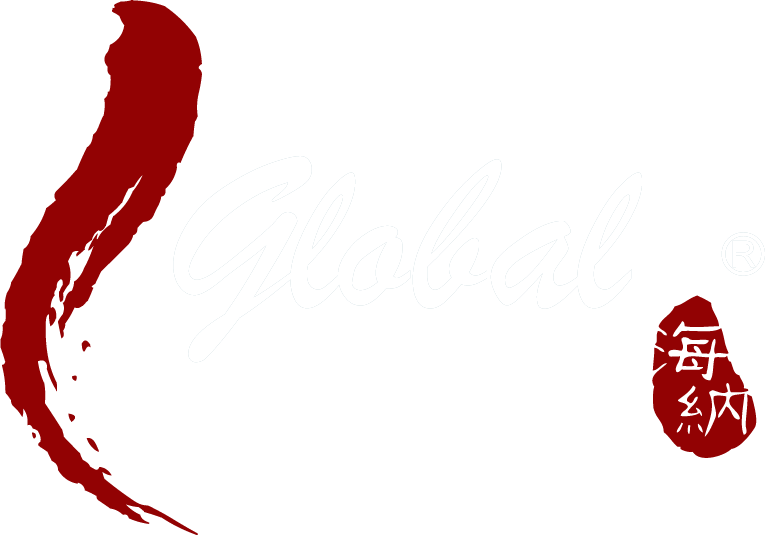
- Travel Agents
- Privacy Policy

Address: Building 6, Chuangyi Business Park, 70 Qilidian Road, Guilin, Guangxi, 541004, China

Get Daily Travel Tips & Deals!
By proceeding, you agree to our Privacy Policy and Terms of Use .
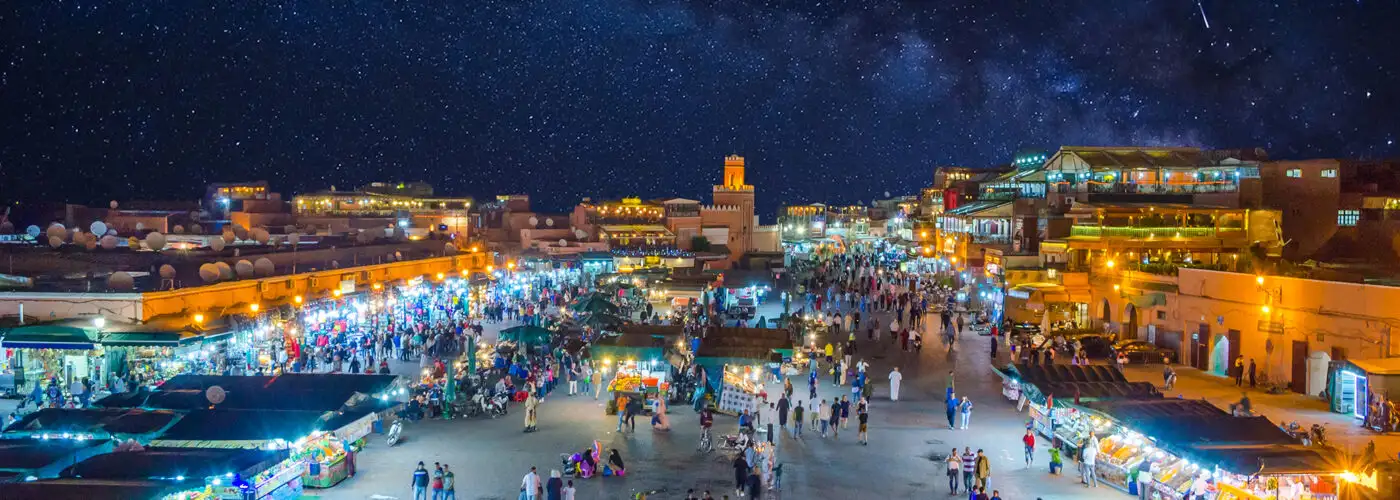
Is Marrakech Safe? Warnings and Dangers Travelers Need to Know
The Editors
We are the editors of SmarterTravel! Together we have appeared in countless travel publications including ABC News, Huffington Post, Travel + Leisure, USA Today, and more. We dedicate our days to creating and producing expert travel content, including packing tips, general travel advice, destination inspiration, and helpful videos. Follow us across social media on YouTube , Pinterest , Facebook , Instagram , and Twitter or drop us a line to say hi at [email protected]!
Travel Smarter! Sign up for our free newsletter.
Marrakech is a magical city, full of mystery, bustle, and color. But is Marrakech safe as a travel destination? Opinions range, from the Canadian government urging travelers to Morocco to “exercise a high degree of caution” to International SOS calling the risk of traveling to Marrakech “low,” the same level as it is for much of Europe. Overall, the consensus seems to be that it is relatively safe to visit Marrakech—provided that travelers take certain precautions, including informing themselves about the areas to avoid in Marrakech. To learn more about traveler safety in Marrakech, read on.
Tips for Staying Safe in Marrakech
- Travel on foot whenever possible. Car accidents are quite common in Marrakech, so plan to walk wherever possible, with public transit being the next best option. If you must get in a cab, choose a petit taxi over a grand taxi, and make sure that it has seat belts and is otherwise in good order. It’s wise to agree in advance with the driver about what your final fare will be.
- Maintain vigilance. More than focusing on areas to avoid in Marrakech, focus on how to visit the most popular tourist sites while preventing yourself from becoming a victim. That is, always be aware of your surroundings, keep belongings under wraps, and don’t get distracted, as that’s when you can fall victim to the elements that can make Marrakech dangerous.
- Steer clear of prostitution in Marrakech. Even though prostitution is illegal in Morocco, it is prevalent in Marrakech. Steer well clear of Marrakech’s red light districts, and avoid patronizing any of the city’s sex workers. Many of Marrakech’s prostitutes are victims of the global sex trafficking industry and have contagious diseases.
Places to Avoid in Marrakech
In Marrakech, there aren’t so much areas to avoid as there are places to be vigilant when you visit. Many of the most popular attractions and markets attract not only tourists but also petty criminals, who prowl the large crowds to find their victims—especially those who are obvious tourists. For example, the city’s historic medina is a must-see, but pickpockets are common there; visitors should keep valuables well under wraps and be aware of their surroundings at all times.
Be on the alert, too, for suspicious-looking packages and people. In 2011, a cafe in Jemaa el-Fna Square fell victim to a terrorist bombing, which killed 17 people, most of them tourists.
Other potentially dangerous places in Marrakech include Gueliz and Hivernage , especially at night, when these districts’ nightclubs are frequented by prostitutes.
If you’re thinking of exploring beyond Marrakech’s city limits, make sure to avoid all travel around the Berm , which is Morocco’s militarized boundary in Western Sahara. Be extremely careful if you plan to head to the country’s remote areas—restrict your journeys to officially designated tourist areas, hire guides recommended by your hotel or the local tourist office, and travel only in vehicles that are equipped for off-roading, advises the Canadian government.
Other places to avoid in Marrakech include political demonstrations and similar large gatherings, which can occasionally turn violent.
How to Get Around Safely in Marrakech
While some of Morocco’s roads are modern and well kept, others are in bad shape, and car accidents are common, with a fatality rate about twice that of the United States . Drivers often act in defiance of traffic laws, and many vehicles are in disrepair. For this reason, it’s best to travel around Marrakech on foot as much as possible.
In terms of hired cars, the yellow “petit taxis” are the most advisable to take in Marrakech, though they’re not always equipped with seat belts or airbags. Avoid the white “grand taxis,” which are large but may pack in more passengers than is safe or comfortable. To save yourself from getting gouged, agree on your total fare with the driver before getting into a cab, especially if the cab isn’t equipped with a meter.
Uber and Lyft do not operate in Marrakech, but a European equivalent called Heetch does. Local taxi drivers sometimes gang up against drivers that work for ride-hailing services, creating an unsafe situation for their passengers.
Public transportation is somewhat reliable and safe in Marrakech, especially ALSA’s tourist buses. Be sure to keep valuables close and monitored when taking any type of public transit in and around Marrakech.
Indeed, Marrakech crime consists mostly of theft—the crimes committed against U.S. tourists in Marrakech are typically pickpocketing, mugging, and purse snatching, according to the Overseas Security Advisory Council (OSAC).
Wherever you’re staying, make sure the doors and windows are locked, and keep valuables in sturdy safes.
Other dangers in Marrakech include natural disasters. Morocco is in an earthquake zone, so familiarize yourself with seismic safety procedures. Heavy rains can cause flash flooding in Marrakech, in which event you should heed the instructions of local authorities.
Terrorism, too, is another factor that compromises safety in Marrakech. As a whole, Morocco is considered at high risk for terrorism , and ISIS has been known to carry out dangerous attacks in this North African nation, with tourists and other foreigners as the key targets. Though Morocco’s government has responded with heightened security measures, travelers to Marrakech should remain on alert for any threat of terrorism.
Other factors to consider regarding Marrakech safety include street harassment, which remains common despite a law against it; female travelers might consider dressing in conservative, non-revealing clothing. In addition, travelers should know that sex between two unmarried people is illegal in Morocco , as is homosexuality.
Vendors who sell street food in Marrakech occasionally add extras to tourists’ bills or serve less-than-fresh fare that could cause illness. To avoid this, choose busy stalls (where food doesn’t sit for long) and seek places where locals are eating.
Prostitution in Marrakech
Despite being a devout Muslim nation, prostitution is a big problem in Morocco, especially in Marrakech . Sadly, sex tourism—including child sex tourism—is a growing industry and does draw travelers here.
Marrakech prostitution is the subject of Much Loved , a Moroccan film that debuted at Cannes and was abruptly banned in Morocco because the government and citizens objected to its sexualized depiction of Marrakech. But thousands of sex workers do work in places like Square 16 November, Avenue Mohammed V, and Rue Yougoslavie —and the government mostly turns a blind eye.
Travelers to Marrakech should know that if they engage in prostitution, they could be supporting the global crime of sex trafficking, which enslaves vulnerable women and children.
More from SmarterTravel:
- 11 Things to Know Before You Go to Morocco
- The 10 Most Dreamy Riads in Morocco
- The 10 Best Things to Do in Morocco
—original reporting by Avital Andrews
We hand-pick everything we recommend and select items through testing and reviews. Some products are sent to us free of charge with no incentive to offer a favorable review. We offer our unbiased opinions and do not accept compensation to review products. All items are in stock and prices are accurate at the time of publication. If you buy something through our links, we may earn a commission.
Top Fares From

Don't see a fare you like? View all flight deals from your city.
Today's top travel deals.
Brought to you by ShermansTravel
Porto to Lisbon: 7-Nt, Small-Group Portugal...
Indus Travels

Luxe, 12-Night Spain, France, Monaco &...
Regent Seven Seas Cruises

Ohio: Daily Car Rentals from Cincinnati

Trending on SmarterTravel

How to stay safe in Marrakesh
- July 20, 2018
Marrakesh is a beautiful, thriving and visceral city with a host of amazing things to see, smell, taste and do. But, it’s not without its foibles. There is a darker side to this ancient metropolis for which every would-be traveller needs to be prepared. In this article, I’ll explore how you can do just that.
Photo credit: Mowgli’s Adventure My first experience in Marrakesh I stepped out from the sanctity of my cool, air-conditioned lodgings and into the dense, hot atmosphere that filled the narrow street below. The air was thick with the smell of burning incense & ethnic spices. I could hear the calls of a thousand competing market sellers drifting on the wind like smoke. A kaleidoscope of colour, sound and smells engulfed me as I took my first steps along the narrow streets of the Souk and deep into this mystical, ancient city. “Ahhh, Marrakesh”, I thought to myself. I was heading for the Jemaa el-Fnaa square, edging my way through a seemingly endless network of ever shrinking, dark alleyways. Suddenly, I notice that the atmosphere had changed. I felt eyes on me everywhere. Turning my head left and right it suddenly hit me. I was completely lost. “You need help, sir?” a voice starts from an open door. “Urhhh…” I started, “I’m fine thank you” (my ingrained Britishness ensuring that I never concede the fact I need help). A small boy emerged seemingly out of nowhere, “I can take you to square – not money. Free! Free!”. Somehow, I doubted that. I pushed passed him, quickening my pace. The walls seemed call out to me in short, harsh voices: “You look here, no like no pay!”, “Come, come, see my shop”, “You! Sir! I have very nice things”. I felt arms tugging at my sleeve as men surrounded me competing for my attention. Seemingly out of nowhere, a large, overweight monkey is placed on my head followed by an abrupt demand for 25 dirham. “What is this place!” I thought as my anxiety increased and I started to sweat, all notions of a relaxing afternoon fading rapidly away into the haze. Breaking free, I headed back the way I came. I hadn’t got far and reached the hotel quickly. It was five minutes before I realised my watch was missing and that the monkey had done something rather undesirable down the back of my shirt. “Well”, I thought, “I’m going to need a different approach to this!”.
Marrakesh is a city of two halves
OK, so my little story may admittedly be a little over dramatised, but the message remains true. Marrakesh, in my view, is not what I’d call a “relaxing” city. It’s hot, claustrophobic and dusty. Petty crime is relatively common and the locals take a less than passive approach to sales.
Marrakesh is not somewhere for the faint-hearted.
On the other hand, however, it’s utterly breathtaking. I can honestly say I’ve never been in an environment that’s transported me into another century quite like the narrow streets of the Marrakesh Souk. Nor have I experienced Tagine quite like it anywhere else in the world (but I suppose that’s to be expected). It’s a thriving, visceral city and the perfect adventurers’ playground.

But, before you attempt to explore what this amazing city has to offer, there are some things to consider to help any budding adventurer stay safe in Marrakesh. Below, are my top tips and advice for travelling to Marrakesh (and Morocco in general) that will keep you safe, and sane!
Tips for staying safe in Marrakesh
1. don’t walk through the souk at night .
You’d think this would be an obvious one, but honestly, I learned this the hard way. Marrakesh, on the whole, is not a dangerous place. You’re unlikely to run into any real danger as a tourist. That said, you are a nice target for petty crime. If you do silly things, like when I tried to walk through the Souk alone at night rather than take a taxi, you are just asking for trouble. I ended up losing all my cash to a few kids who held me up at knife-point. Learn from my mistakes and stay in well lit, populated areas and take a taxi if you need to get around after dark.
2. Avoid wearing flashy/expensive jewellery
Again, showing off your expensive jewellery or your Rolex around will get you noticed. Reduce the risk and leave everything you don’t need in your hotel, or better yet, back home. If ‘would-be’ thieves can’t see anything to steal it’s highly unlikely you’ll run into trouble.
3. Don’t carry large amounts of cash
This applies to most countries, but there’s no need to take additional risks when the risks are already heightened. Only take what you need day-to-day and avoid stashing £50+ worth of currency in your back pocket. Pick-pocketing is common and there’s a good chance you won’t see it again should wondering fingers find their way into your stash.
4. Just say no
As an Englishman, it can go against my nature to be in-polite. But it’s important to understand that being polite is not a pre-requisite in Marrakesh. Be respectful, yes. But polite…polite won’t get you where you need to be. Barking an abrupt “No!” at someone or waving people off with your arms may feel strange to most of us, but it’s often all you can do to prevent yourself being swept away into one shop or other and preyed upon like a newborn deer. Just say no, shortly and sharply to market traders , beggars and particularly the monkey people (unless you want to have to change your shirt!). Better yet, disengaging and walking away will generally grant you your freedom (eventually).
5. Watch out for scams
The age-old saying applies here: “If it sounds too good to be true, it is”. Free tour around the Marrakech Kasbah Mosque ? Think again. High quality, real cashmere shawls? No chance. Moroccans are hard sales-people that thrive of reciprocity, guilt and wearing you down. Don’t let anyone forcibly lead you into their shop for tea for an “obligation-free” gander over their carpets/scarves/paintings/oils/spices. It’s just a ruse to get you through the door and wear you down until you finally give in, which you probably will, especially if you’re English.
Most importantly, don’t let anyone put a monkey on your shoulder , and if they do, definitely don’t start taking selfies with it or you’ll be forced to pay an outrageously large tip (and in my case, buy a new shirt!). The same goes for people who will just start covering your hand in Henna, or wrap scarves around your neck. Remember point number 4 – just say no to stay safe in Marrakesh.
6. Carry your own water
This is generally good travel practice, but in Morocco in particular, it’s always a good idea to carry your own bottle of water with you at all times. Needless to say, you can’t drink from the tap, so having something on hand can be lifesaving. You can buy cold, fresh water from shops and restaurants but is generally overpriced. Stock up in the mornings at your hotel/hostel where the water is cheaper to avoid getting sick & spending too much on water.
7. Avoid the ice
As I’ve mentioned, Morocco is not known for its clean water. Drinking only bottled water is one thing, but I’ve seen people on more than one occasion get caught out by the ice. Unless you can be 100% certain the ice in your drink has been made using bottled or purified water, don’t touch it – no matter how much more refreshing it makes you coca-cola!
8. Don’t eat salad
The same goes for salad, fruit and any other vegetables which you may eat raw. All these veggies get washed before they arrive on your plate. If they’re washed in tap water there’s a good chance you could get sick, so be cautious, you do not want to end up with diarrhoea. There is a really good, in-depth article by fellow travel blogger Bren on the Road on how to avoid getting diarrhoea while abroad – read it and you should be fine!
9. Hire a local (official) guide
Marrakesh can be a daunting place and it often helps to have some local know-how to make sense of it. You’ll get pestered a lot by locals claiming to be guides. Ignore them, it’s a scam and illegal in Morocco. You can easily hire an official guide for a good price (about £15-25 per day). This can usually be arranged by your hotel or hostel. When I was in Marrakesh, I hired an official local guide that was organised by the hotel. I found it to be a tremendous advantage on almost every level.
Not only do you learn a lot more about the city but you are not pestered nearly as much. Furthermore, you can ensure that you only eat in safe places, to translate and have someone on hand to make sure you’re not getting ripped off. For me, it was worth it and I would recommend looking into it.
10. Be respectful (drinking and dressing)
Marrakesh has a large Muslim population. Therefore, it’s important to remember to dress conservatively when our in public, particularly for women. It’s important to be aware that shorts, skirts and dresses should fall below the knee and shoulders should always be covered to avoid drawing unwanted attention to yourself. While drinking alcohol is allowed, it’s not something you should do openly in public. Just be conscious of your surroundings in order to avoid offending anyone and you’ll be sure to stay safe in Marrakesh.

My final thoughts
Marrakesh is an incredible city. It’s a city full to the brim with culture and history. It’s streets and medinas assault the senses in ways that you just can’t experience anywhere else. Please don’t be put off! I would highly recommend that you add this thriving city to your bucket list .
The list above is good practice for any foreign city. That being said, travellers need to take extra precautions to stay safe in Marrakesh that that may not be necessary in other, similar cities.
Quite honestly, there were aspects of the city I disliked and at times I felt cheated, anxious and even a little frightened. I was travelling with a buddy of mine, not part of a tour group, which didn’t help much as we spent a lot more time doing things we probably shouldn’t have. That said, I find it hard to recommend travelling there solo – particularly as a woman.
If I was to visit the city again, I think I would feel more comfortable going as part of a group. There are loads of highly recommended tour companies in Marrakesh. I’ve listed a few below:
- Maroc Excursions – Maroc Excursions is a full-service travel agency, based in Marrakesh, Morocco since 1996.
- Marrakesh Guided Tours – official guided tours around the city
- Explore Morroco Travel – a wide variety of tours both in Marrakesh and throughout Morocco
- Marrakesh Insiders – slightly different motorcycle tours of the city
That’s it! I hope that this article has proved useful. If it has put you off, please don’t be. It’s a wonderful city and you’ll have an incredible time. So long as you heed the tips and advice above, you will stay safe in Marrakesh with no trouble at all. Good luck!
Like this post? Share it on Pinterest!

Leave a Reply Cancel reply
Your email address will not be published. Required fields are marked *
Notify me of follow-up comments by email.
Notify me of new posts by email.

Recent Posts

The Best Photo Spots in Hong Kong: a Helpful Guide
The year 2018 was a tough year for me work wise. I was busy constantly without a second to take some time off. By October

3 Easy Hikes Along the Icefields Parkway
In June 2019 I completed an epic road-trip through the Canadian Rockies beginning in Vancouver and ending in Calgary ( around 1,300 km). I had

4 Countries That Will Pay You to Visit After Lockdown
We’ve all been feeling a bit like this lately Countries including Mexico, Bulgaria, Japan and Sicily are planning on paying tourists to visit them in
You might also enjoy...

The Best Places to Watch the Sunset in Jersey

Touropia Travel Experts
Discover the World
16 Top Tourist Attractions in Marrakech

Resting in the foothills of the Atlas Mountains, Marrakech (also spelled Marrakesh) is an exotic city luring visitors with its Moroccan charm. Whether travelers arrive on the express or tour the city with thoughts of Charles Boyer and his Kasbah at the fore, all will be enchanted by what they find.
The more you wander, the more you’ll uncover the irresistible allure of this Moroccan gem, exploring its lively souks, elaborate palaces, and secluded riads. From the energetic Rahba Kedima Square to the idyllic Le Jardin Secret, the tourist attractions in Marrakech presents a mosaic of experiences that will linger in your memory.
So folks, pack your curiosity and your sense of adventure. You’ll need it.
Map of Marrakech
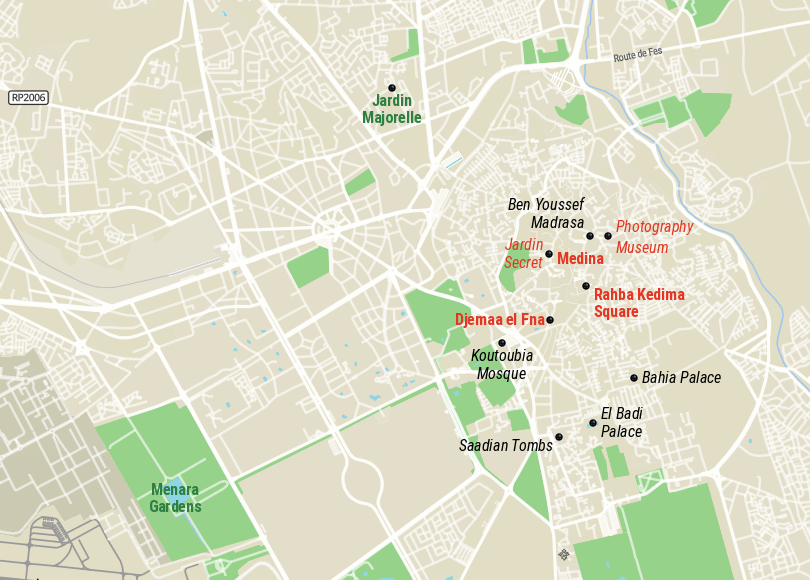
16. Rahba Kedima Square
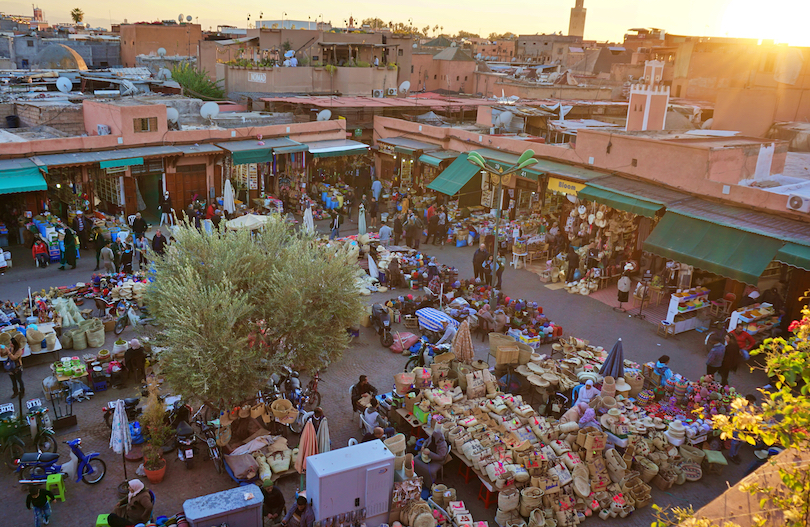
Dubbed the Spice Square, Rahba Kedima Square teems with vibrant sights, fragrant aromas, and bustling activity. A highlight of the square is the spice stalls that line the edges. Each displays an array of vividly hued spices, from golden turmeric to deep red paprika all available for purchase.
Beyond the spice market, Rahba Kedima Square is also known for its handicrafts. Local artisans showcase their skills, offering a wide array of traditional Moroccan crafts, such as hand-woven baskets, textiles, and babouches. Babouches are traditional slippers and make unique and thoughtful gifts to take back from your travels.
15. Yves Saint Laurent Museum
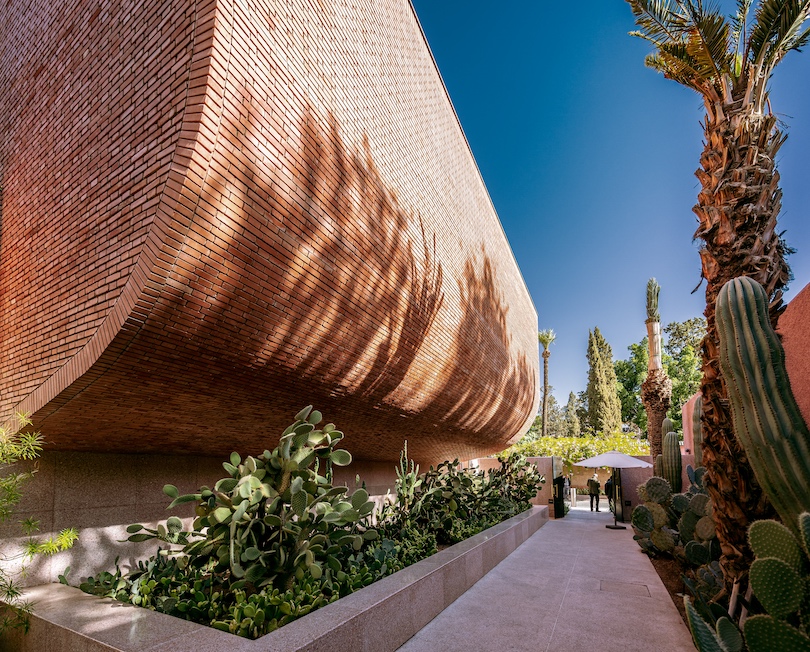
Immerse yourself in the legacy of YSL at Yves Saint Laurent Museum. This museum is a tribute to his haute couture and artistic brilliance. Housed in a stunning blend of Moroccan tradition and modern design by Studio KO, the building welcomes visitors into a realm of elegance.
Explore the designer’s iconic career through an impressive collection of garments, accessories, sketches, and photographs. All combine to show his innovative vision and lasting impact on fashion.
Make sure to spend some time in the museum’s research library. Here you can dive into Islamic and Arab-Andalusian culture, Berber traditions, botany, and local fashion.
14. Stay in a Traditional Riad
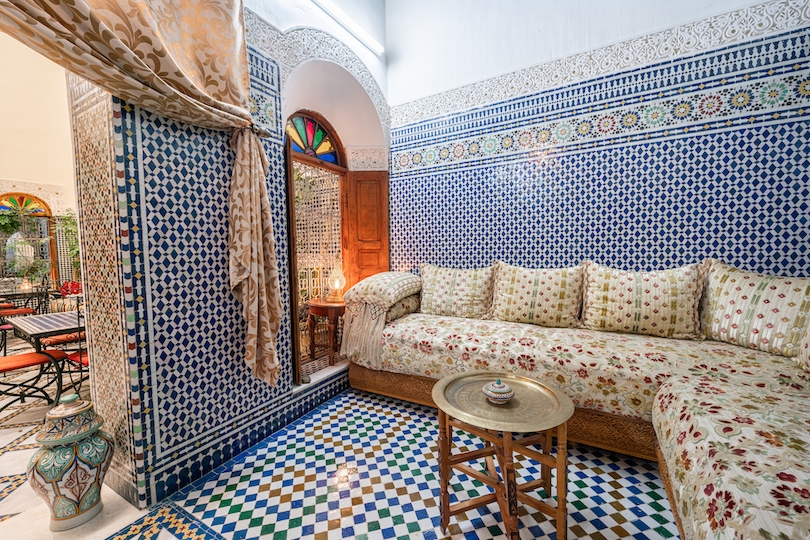
Experience Marrakech’s vibrant culture and rich history firsthand by staying in a traditional riad . This is a quintessential Moroccan house with an inner garden sanctuary. Decorated with intricate tile work, lush plants, and soothing water features, the inner courtyard is made to provide tranquility within the busy city.
Originally reserved for the affluent members of society, many now serve as guesthouses. A number of them are family-owned, providing an authentic experience where you can interact with the owners and learn about their traditions. Travelers can engage in conversations, participate in cooking classes, or simply soak in the ambiance, giving you a new insight into Moroccan culture.
13. Le Jardin Secret
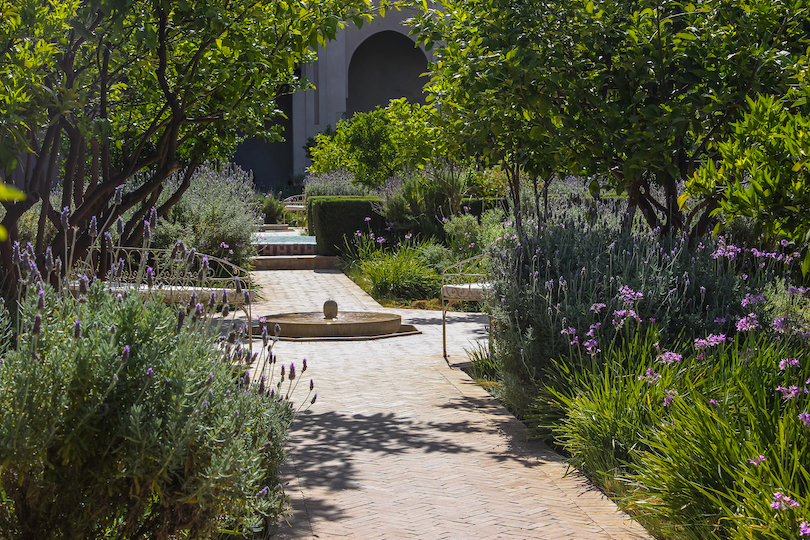
Tucked away from the lively streets of Marrakech lies Le Jardin Secret, a hidden oasis of serenity and natural beauty. Divided into two sections, the Exotic Garden and the Islamic Garden, Le Jardin Secret offers a tropical escape while showcasing traditional design principles.
Take time to view the films detailing the gardens’ restoration and water management. Next, relax in the shade with a coffee surrounded by opulent greenery and soothing water features.
Ascend the tower for panoramic views of the medina and Atlas Mountains. This is a rare opportunity in modern Marrakech. The tower stands as one of the few remaining structures of its kind, offering a unique glimpse into the city’s architectural heritage.
12. Maison de la Photographie
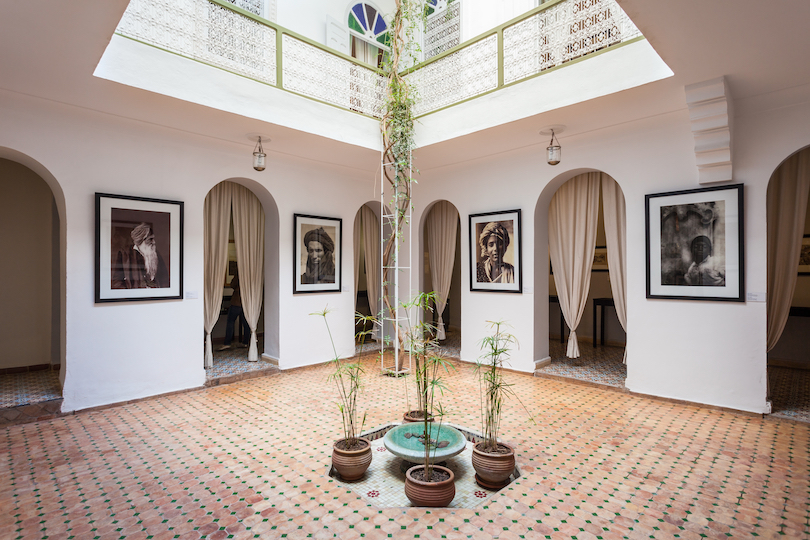
Standing as a tribute to the art of visual storytelling, Maison de la Photographie offers a captivating journey into Morocco’s cultural tapestry. All seen through its extensive collection of photographs spanning over a century.
Each image encapsulates a moment in time, reflecting the dynamic evolution of Moroccan society and culture. Delve into carefully curated exhibitions, including photographs, glass plates, postcards, newspapers, cards, and documentaries. Each will transport you across different eras and regions of Morocco.
From the museum’s rooftop terrace, enjoy a breathtaking view of Marrakech. In addition, it’s the perfect space to reflect on the vivid collections and exhibitions with a cool mint tea.
11. Visit a Hammam
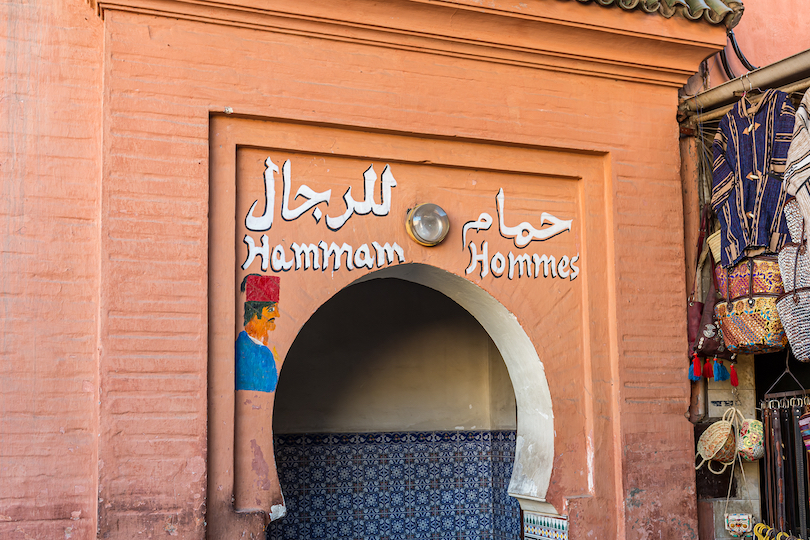
Find yourself in a sanctuary of relaxation and rejuvenation in Marrakech at a traditional hammam. Stepping into this time-honored tradition is like stepping back in time, immersing yourself in the rituals and customs that have been cherished for centuries. A place where locals and visitors alike come to cleanse their bodies and souls.
The warm, steam-filled room envelops you, easing tension from your body and calming your mind. The hammam experience typically involves a series of cleansing rituals, and a tellak can guide you through. This includes exfoliating your skin with traditional black soap and rinsing with warm water. Afterward, you can unwind in a tranquil space, indulging in a soothing massage or reclining on heated marble benches.
10. Menara gardens
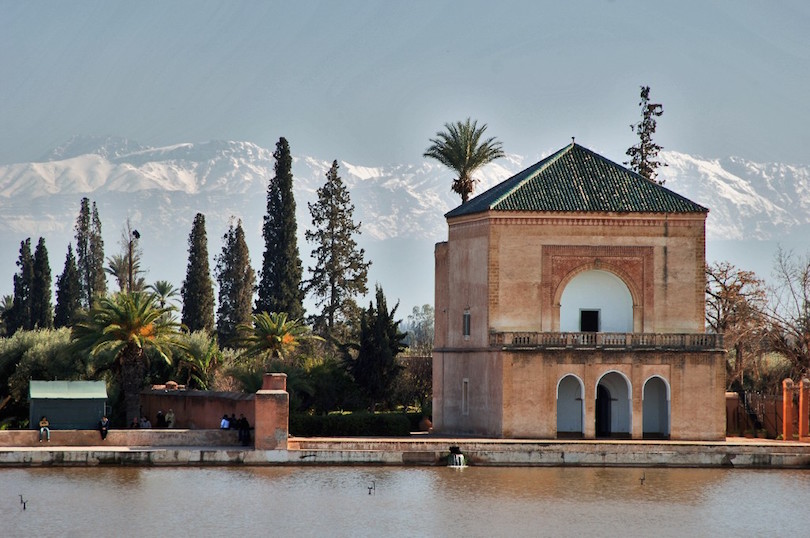
The Menara gardens are popular with locals and visitors alike since they provide a cool place to escape the heat of Marrakesh’s scorching summer days. The original purpose of the 12th century gardens was to provide a place for people to cool off and grow crops.
Smaller gardens are built around a large arterial lake that is fed by canals. Palm, olive and fruit trees grow in the orchards, so visitors can usually see pruners and pickers at work. A good place to view the gardens is from the pavilion or minzeh, once used by a sultan and his family, that overlooks the pool.
9. Saadian Tombs
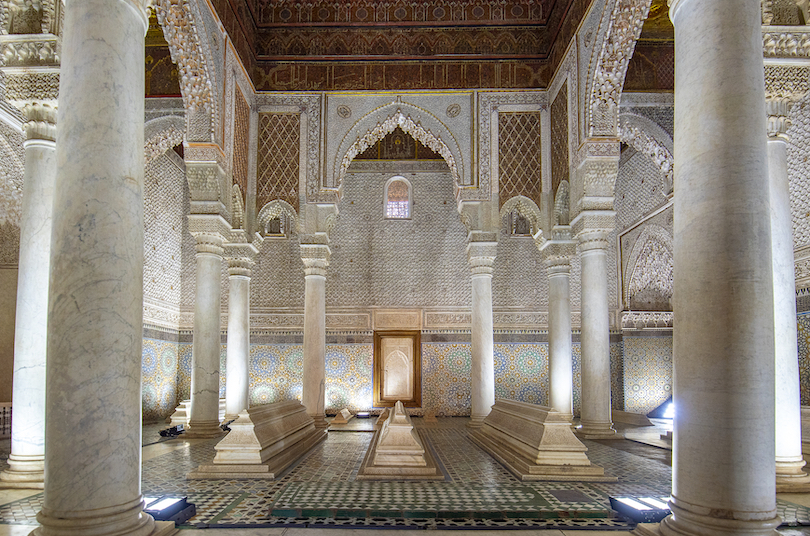
The Saadian Tomb were used as a burial place for royalty and nobility for a couple of hundred years starting in the mid-16th century. The last burial took place in 1792, and then the tombs were neglected, until they were rediscovered in 1917.
The tombs consist of two main mausoleums where 66 people are buried, while another 100 are buried in the gardens, with their gravestones covered in tile. The buildings are imposing, plain in some places and highly decorative in others.
8. El Badi Palace
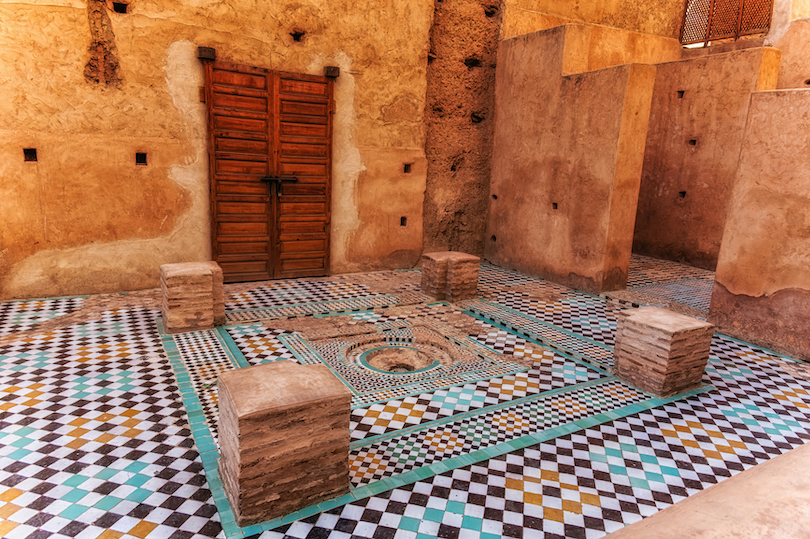
El Badi Palace may be in ruins today, but it was once an ornate palace that was funded by ransom paid by the Portuguese after the Battle of the Three Kings in the mid-16th century. Only the most lavish and expensive materials were used during the 25 years it took to construct the palace.
Gold and onyx were used throughout, with the sultan trading sugar for the Italian marble used in the columns. The palace had 360 rooms and several pavilions. A later sultan raided the building of its lush materials and furnishings for his own palace; as a result, only ruins remain today.
7. Koutoubia Mosque
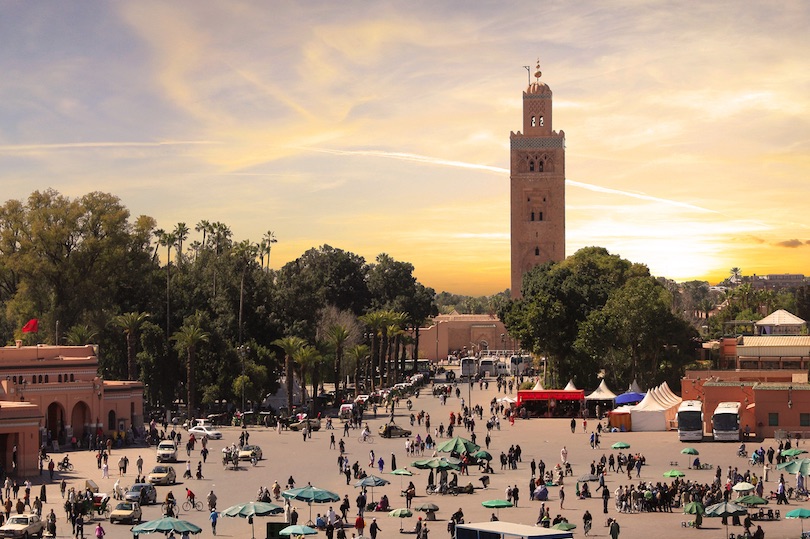
The Koutoubia Mosque is a Marrakesh landmark, towering over the southwest medina of the city. Dating back to the 12th century, the mosque stands out, easily since its minaret is 77 meters (253 feet) high, as Marrakesh’s largest mosque. While other roads may all lead to Rome, in Marrakesh they lead to the mosque.
During the French Occupation, the mosque was used as the central point for the network of roads. The red stone mosque has six rooms, one on top of another, so designed to keep people on the minaret from looking in on the king’s harem. Non-Muslims are not allowed inside.
6. Bahia Palace
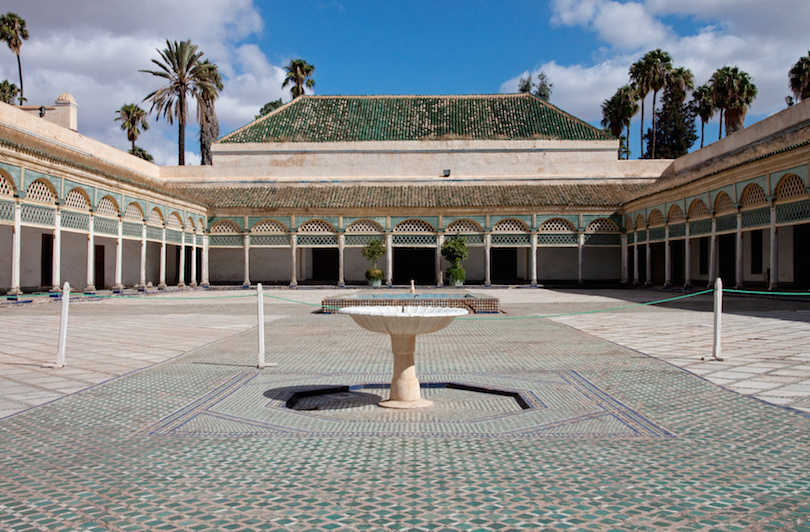
It took the best workers in Morocco 60 years to build Bahia Palace, found in the medina or old quarter of Marrakesh. The collection of one big house and several small ones into a palace was certainly worth the wait. Built in the 19th century for a grand vizier, it incorporates the best of Islamic and Moroccan influences.
The palace today receives state visitors to Morocco. Because it is a working government building, not all rooms are open to the public, but some of those that are include the harem quarters and gardens.
5. Jardin Majorelle
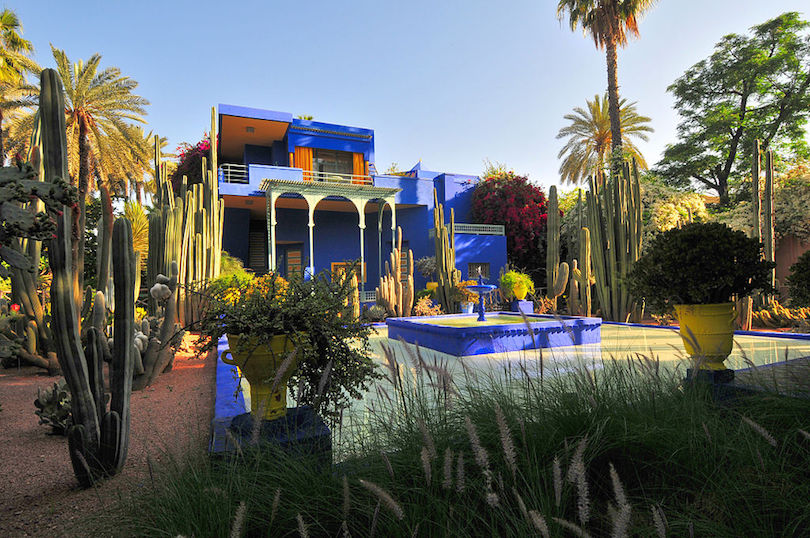
When it comes time to relax in busy Marrakesh, savvy travelers will head to Jardin Majorelle, an oasis of beautiful flowers, lush greenery and patios where visitors can sit and refresh their senses. The garden is named for the French painter, Jacques Majorelle, who spent 40 years creating it after he moved to Morocco.
Since 1980 the garden has been owned by Yves Saint-Laurent and Pierre Bergé. The garden is small by some standards, but is exquisitely designed with exotic plants, fountains and meandering pathways, all with the aim of reminding visitors of some aspect of Morocco.
4. Ben Youssef Madrasa
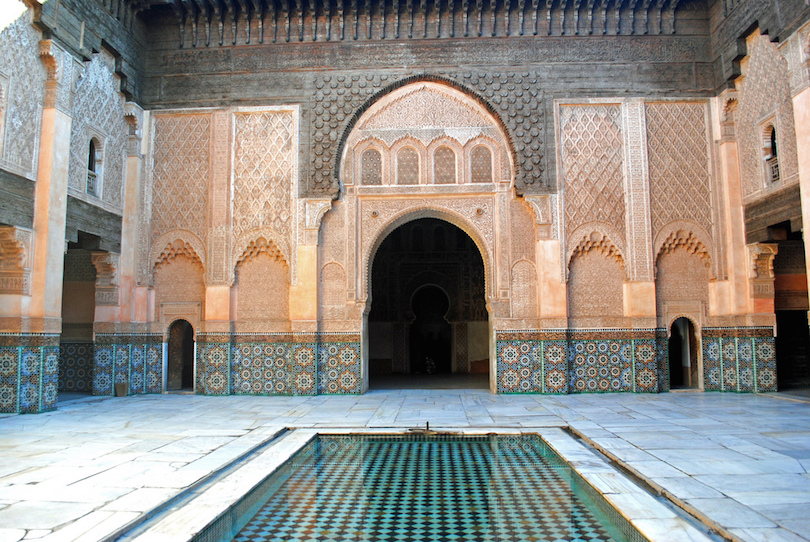
Ben Youssef Madrasa was once a theological college devoted to teaching of the Quran. Once the largest learning center in North Africa, it housed up to 900 students at a time. The madras is centered around a large courtyard, with an elaborately decorated prayer hall in back.
Now an historic site, the madrasa is marked by distinctive architecture, which is reminiscent of the Alhambra in Spain. Inscriptions in Arabic can be found throughout the complex. Visitors say it’s worth a visit to see the mosaics and 14th century architecture.
3. Marrakech Medina
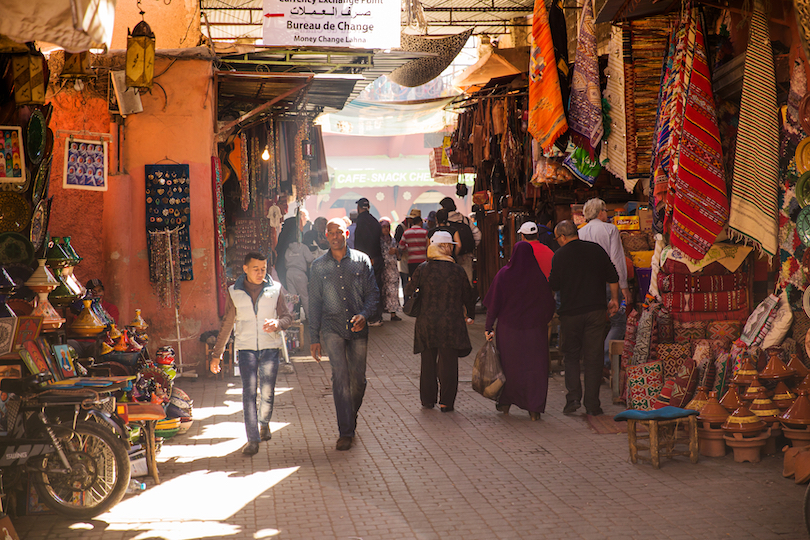
The old medina of Marrakech is full of intertwining narrow passageways and local shops full of character. The Medina is also the place to stay in a Riad, a Moroccan house with an internal courtyard.
Most windows are inward facing towards the central atrium. This design suits Islamic tradition, as there is no obvious wealth statement being made externally, no windows to peer through. They are great places to stay and offer an intimate and relaxing retreat.
2. Marrakech Souks
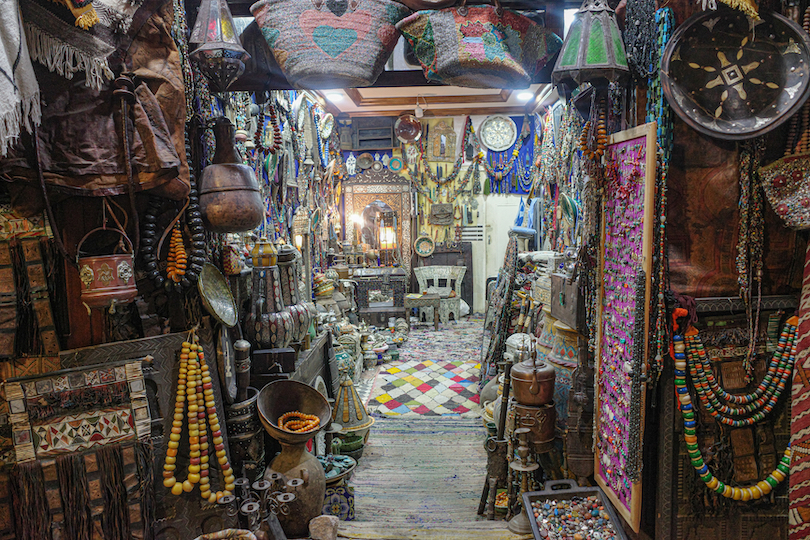
Shoppers in the souks of Marrakesh are in for a mind-boggling experience. The city has five main souks, each devoted to a single product. There’s one for carpets and another for traditional Moroccan leather slippers known as babouches; note bright yellow slippers are intended for men.
A third centers around metalworking, while another sells a fragrant array of spices. The Mellah or Jewish Quarter isn’t really a souk, but it’s a good place to buy fabrics, trims and notions. Haggling is expected; shoppers should start their initial price at no more than half what the merchant is seeking.
1. Djemaa el Fna
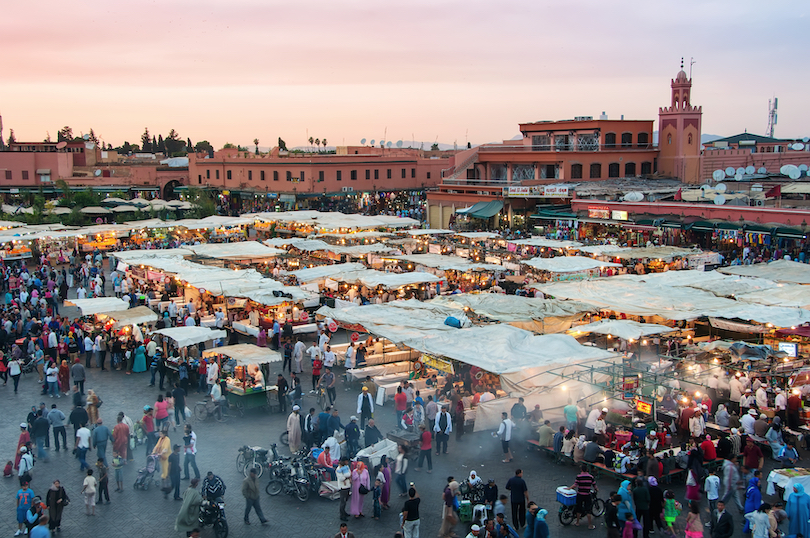
Djemaa el Fna, located in the medina, is the main square in the city as well as the most popular tourist attraction in Marrakesh. It also is a market, where travelers can buy orange juice or watch a snake charmer at work.
As the day moves on, the snake charmers are placed with traditional dancers and magicians, who are replaced themselves by food stalls. A souk selling daily necessities is on one side, hotels on another. The colorful market square may be familiar to moviegoers, since it was featured in the Hitchcock film, The Man Who Knew Too Much.
Share this post:
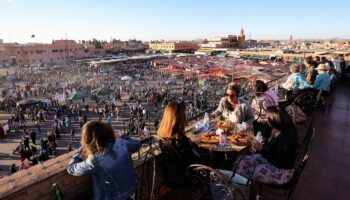
Where to Stay in Marrakech: Best Neighborhoods & Hotels
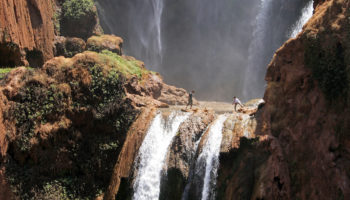
7 Best Day Trips from Marrakesh
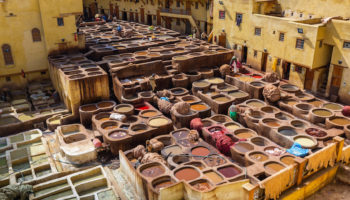
12 Best Things to Do in Fes, Morocco
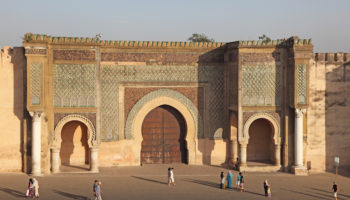
10 Best Things to Do in Meknes, Morocco
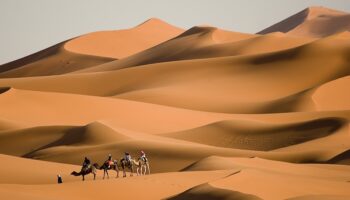
16 Best Places to Visit in Morocco
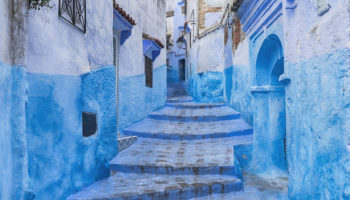
Inside Chefchaouen: Morocco’s Stunning Blue City

10 Best Beaches in Morocco
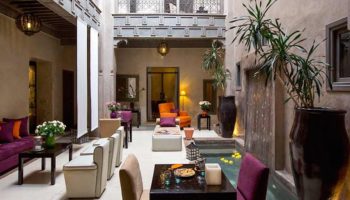
10 Best Morocco Luxury Hotels
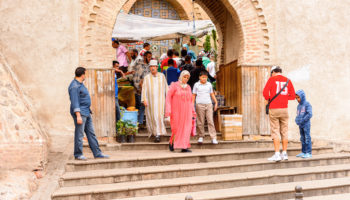
15 Best Cities to Visit in Morocco
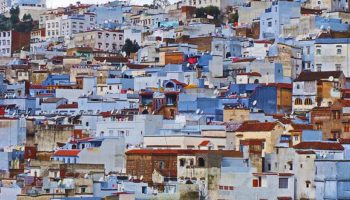
17 Top Attractions & Things to Do in Morocco
Reader interactions, leave a reply cancel reply.
Your email address will not be published. Required fields are marked *
This site uses Akismet to reduce spam. Learn how your comment data is processed .
We’re on the road right now – join in on the fun and follow @thebrokebackpacker on IG!
- Meet the Team
- Work with Us
- Czech Republic
- Netherlands
- Switzerland
- Scandinavia
- Philippines
- South Korea
- New Zealand
- South Africa
- Budget Travel
- Work & Travel
- The Broke Backpacker Manifesto
- Travel Resources
- How to Travel on $10/day
Home » Africa » Marrakesh
Is Marrakesh Safe for Travel? (Insider Tips)
Medieval mosques, tagine cuisine, crumbling minarets, crazy backstreets, tiled palaces, maze-like markets and a whole lot of colours, sights, smells, sounds, aromas, and spectacles to take in: it must be Marrakesh. This is truly a must-see destination.
However, it also has a reputation for being a frantic, frenetic city. Here you will find genuinely dangerous road conditions (the traffic is terrible), pushy sellers, scams, pickpockets, and there’s even the threat of terrorism to contend with in this city.
There is a lot about this city that puts people off and a lot of it based in and around the medina area. However, if you know the dangers, annoyances, how to not look like an unsuspecting tourist and not be targeted for scams in the first place, then you’ll know how to avoid them. In this guide, we’ve got a ton of tips, ways to not get scammed or how to deal with taxis!
You may be a solo female traveller worried about a trip to this city, or you may just be wondering about its food safety – whatever it is we’ve got all this covered and so much more in our handy guide, so let’s go!

Unlock Our GREATEST Travel Secrets!
Sign up for our newsletter and get the best travel tips delivered right to your inbox.
How Safe is Marrakesh? (Our take)
Is marrakesh safe to visit (the facts.), is it safe to visit marrakesh right now, marrakesh travel insurance, 20 top safety tips for traveling to marrakesh, keeping your money safe in marrakesh, is marrakesh safe to travel alone, is marrakesh safe for solo female travellers, is marrakesh safe to travel for families, is it safe to drive in marrakesh, is uber safe in marrakesh, are taxis safe in marrakesh, is public transportation in marrakesh safe, is the food in marrakesh safe, can you drink the water in marrakesh, is marrakesh safe to live, how is healthcare in marrakesh, faq about staying safe in marrakesh, final thoughts on the safety of marrakesh.
Marrakesh is a busy, bustling former imperial capital city that’s verging on manic. Labyrinthine lanes in the souks and the mad Jemaa al-Fnaa square. It’s definitely a cool place to visit.
However, Marrakesh isn’t always cool – far from it, in fact. And when it comes to safety, there are few things to be aware of.
There’s not a huge amount of risk for travellers who go to Marrakesh but there is definitely still a problem with petty theft and scams. Dangerous driving also poses a bit of a threat. It’s a shame to say it but women travelling alone may face some issues, too.
Morocco is a Muslim country and it’s important to remember that even visitors should be at least respecting Islamic law and local customs.
Hassling hagglers, unscrupulous touts, and a whole lot else to watch out for: let’s look in detail at what that all means.
There is no such thing as a perfect safety guide, and this article is no different. The question of “Is Marrakesh Safe?” will ALWAYS have a different answer depending on the parties involved. But this article is written for savvy travellers from the perspective of savvy travellers.
The information present in this safety guide was accurate at the time of writing, however, the world is a changeable place, now more than ever. Between the pandemic, ever-worsening cultural division, and a click-hungry media, it can be hard to maintain what is truth and what is sensationalism.
Here, you will find safety knowledge and advice for travelling Marrakesh. It won’t be down to the wire cutting edge info on the most current events, but it is layered in the expertise of veteran travellers. If you use our guide, do your own research, and practise common sense, you will have a safe trip to Marrakesh.
If you see any outdated information in this guide, we would really appreciate it if you could reach out in the comments below. We strive to provide the most relevant travel information on the web and always appreciate input from our readers (nicely, please!). Otherwise, thanks for your ear and stay safe!
It’s a wild world out there. But it’s pretty damn special too. 🙂
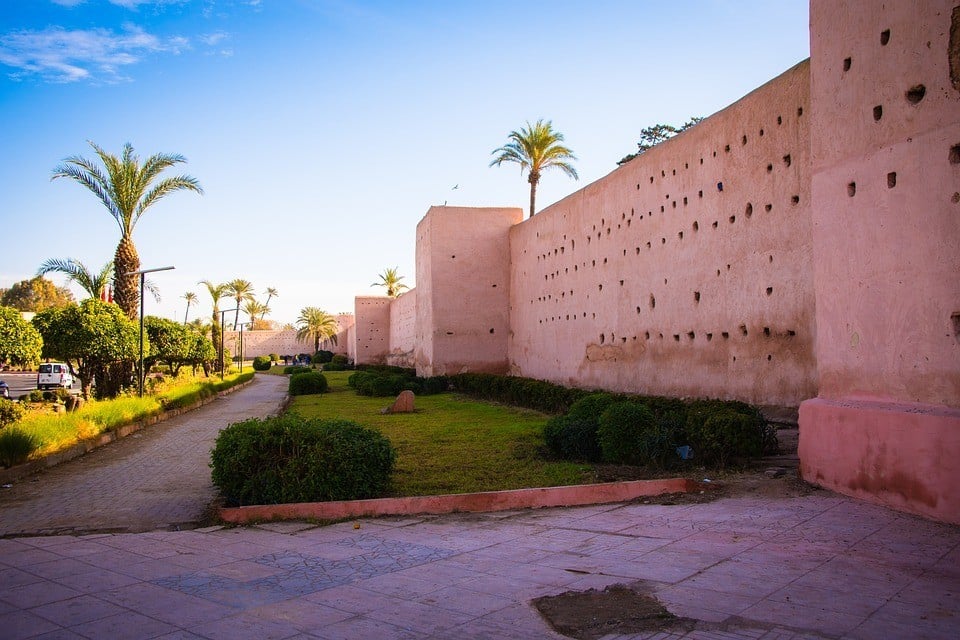
According to the tourist numbers Marrakesh is certainly still on the cards for a trip, which could mean that it’s a safe destination.
In 2017 Marrakesh broke its own record, crossing the 2 million mark for tourists in the city with more than 6 million overnight stays; that’s a lot for a city with a population of just under 1 million!
Tourist numbers are still on the rise. From January through November of 2018, Marrakesh recorded over 2.4 million tourists.
People heading to Marrakesh are overwhelmingly from Europe: France, Spain, and Germany, with a few from Eastern Europe, too. Chinese tourists are beginning to show up in the city as well.
Marrakesh is, in fact, the most visited destination in Morocco , which in turn is the most visited country in Africa.
Where does safety fit into all this? Marrakesh officials have responded to the increase in tourists by attempting to sort out the wild traffic, restoring monuments and giving certain districts some much-needed renewal.
Marrakesh has had its fair share of worries for tourists and visitors over the past few years; this does, unfortunately, include terrorism.
In fact, Moroccan authorities regularly report the disruption of terrorist cells and their threats across the country from extremist groups, some of whom align themselves with Daesh.
Crowded areas, transport hubs, global and western businesses, as well as government buildings, are all targets for terrorist attacks. Security measures, including security personnel, can be visibly seen in tourist sights. Though this looks scary, it’s better that they’re there than not.
There has also been a recent increase in the use of armed robberies against tourists, specifically knives. Petty crime in the medina quarters – things like pickpocketing, bag snatching, credit card fraud, confidence tricks, aggressive begging, and other travel scams continues to be a very real issue.
Protests and demonstrations take place quite frequently in Marrakesh. Usually, they are peaceful but these can definitely turn violent, but usually only with isolated incidents. Even so, these should definitely be avoided.
Overall, it’s pretty safe to visit Marrakesh right now, so long as you’re using your common sense.
ALWAYS sort out your backpacker insurance before your trip. There’s plenty to choose from in that department, but a good place to start is Safety Wing .
They offer month-to-month payments, no lock-in contracts, and require absolutely no itineraries: that’s the exact kind of insurance long-term travellers and digital nomads need.

SafetyWing is cheap, easy, and admin-free: just sign up lickety-split so you can get back to it!
Click the button below to learn more about SafetyWing’s setup or read our insider review for the full tasty scoop.
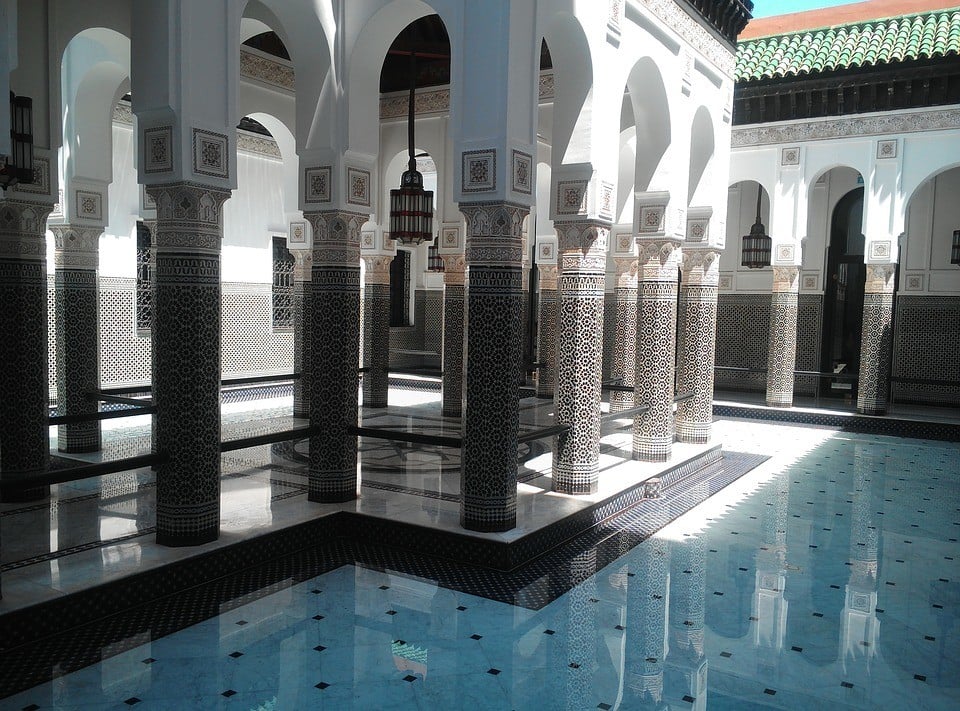
With all the level of petty crime, busy streets, unfamiliar terrain and a reputation for overzealous stallholders with forceful sales techniques – not to mention the threat of terrorism – no doubt you’re pretty worried, especially if you’ve never travelled alone. However, there’s a lot to do and see in Marrakesh and if you apply our tips, you can stay safe in this mad city.
- Streets are easy to get lost in – even if you ask a local for directions, it might not be helpful (especially in the medina area).
- Carry a business card from the hotel you’re staying at – this will help you ask for help; or show it to your taxi driver.
- Be super careful taking money out of ATMs – try and use the ones inside whenever possible.
- Only carry a small amount of cash with you – 1) no one can see a big wad of cash when you pay for something; 2) if your wallet goes missing, you don’t lose a load of money.
- Wear a money belt – this way, you can hide extra cash. More on this later.
- Be very careful of distraction techniques – a good rule of thumb: be suspicious of everyone who comes up to you unprompted.
- There are a high number of shady characters – it’s good to know this. We’re talking fake guides, hustlers, confidence tricksters, “I recognise you from the hotel” kind of lines; there are so many people like this to watch out for.
- Try to find the tourist police – these are set up around tourist sights. The aim is to try to curb that sort of scammy behaviour.
- Agree on a price for a guide before you leave – and know you will be taken around a load of tatty tourist shops.
- Head to a tourist office for an official guide – these tend to be much better and safer.
- Be humorous – bantering with people who want to sell you stuff is fine, but getting into a big conversation or (worse) disagreement with them isn’t recommended as you’ll either never getaway or cause a scene and unnecessary upset.
- Try to look like you know what you’re doing – looking like a lost tourist will get you so much more hassle: trust us.
- Don’t look wealthy – looking like a rich tourist is just going to make you a target for all sorts of thieves.
- Marijuana, kif, hashish isn’t legal – for tourists. Loads of old guys here smoke it, but it’s not worth getting involved as a tourist as the person you buy it from may rip you off and you may curiously find yourself pulled up by police very soon after.
- Respect local laws, customs, and traditions – if you’re going to a religious site in particular, especially during Ramadan.
- Public displays of affection are just not the done thing – sexual relations outside marriage are punishable by law and homosexuality is a criminal offence. It’s that sort of place. Be sensitive to that or you could end up in trouble.
- Drinking alcohol in public or unlicensed places is illegal – you could get arrested for doing so.
- Be very careful taking pictures near government or military sites – just don’t.
- Drone users, don’t bother – flying one without permission is illegal in Morocco and could get your actual passport confiscated.
- Walking around can be hazardous – paths are almost non-existent, the traffic is crazy, crossings aren’t used. Be careful!
- Learn a few words of Arabic – it’s not that hard and it’s great for a bit of joking around if you want to haggle!
- Try to blend in – men and women in Marrakesh don’t really wear shorts, maybe sometimes short sleeves. On the whole, the general rule is to show less skin. Stops you getting burnt in that horrific sun, too.
There’s a lot to think about in Marrakesh, especially when it comes to safety. Like every other city, you have to use your common sense – that’s a given. However in Marrakesh, there are a lot of people trying to sell you stuff, talk to you, get your attention, and yes: some might want to steal your stuff, too. It’s just important to take it all with a grain of salt and try to have a good outlook, otherwise, you could find yourself worn out quickly!
The best way to cut a trip short, or simply put a dampener on your holiday, is to fall for some stupid scam – or get money stolen from you. It’s really annoying having a pickpocket secretly pinch your cash and can change your perception of a country.
In Marrakesh, we’re going to level with you: there’s a lot of opportunities for petty crime. Potential thieves are everywhere and may try with words, or maybe by distracting you, to get to your money. There is a solution to this though and it’s a travel money belt .
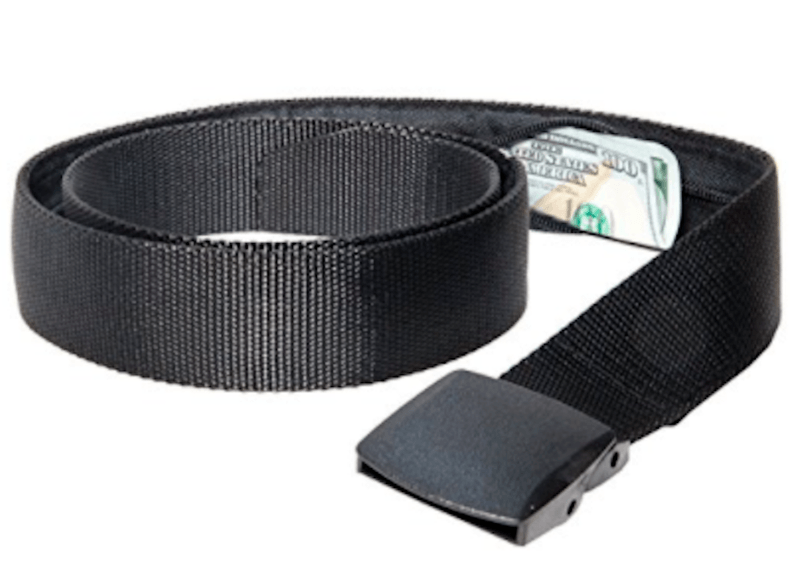
The Pacsafe Money Belt is our best bet. It’s affordable, it looks and acts like a belt, and it’s sturdy – what more could you ask for out of a money belt!
Unlike a lot of other money belts out there, there’s no big pouch to get in your way and look obvious under clothes, no extra belt to wear if you’ve already got a belt on, no discomfort. The Pacsafe Money Belt is a belt – it’s just got a secret zip pocket where you can stash your cash and keep it safe from prying fingers and sticky hands. We would recommend wearing this anywhere in the world!
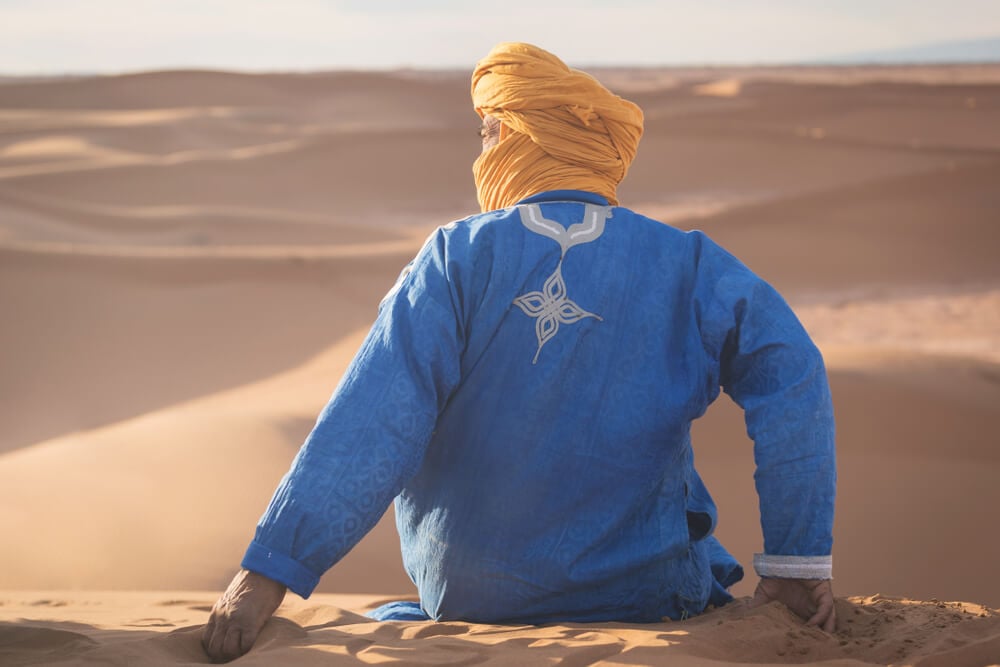
Solo travel is really cool – we love it. There’s a lot going for travelling the world by yourself. Mainly, being by yourself, you have only your own smarts to rely on, which usually means challenging yourself and reaping the rewards of levelling up as a traveller and as a person!
It’s definitely not always fun though and travelling to Marrakesh as a solo traveller may feel more than a little bit daunting. We think there’s nothing to worry about, though. Plus, to help your trip go as smoothly as can be, we’ve actually got a few pointers for you solo travellers…
- When you walk around the city, have your wits about you. This doesn’t mean that you should be walking around tense and paranoid all the time, but just, you know, have your guard up a little bit and know that not everybody who wants to talk to you is doing so for purely friendly reasons.
- Try to find some accommodation that works for your travel style. If you want somewhere to be super social and have a bit of fun, then look for a social party hostel in Marrakesh ; if you want something more chilled, then maybe go for something a little more high-end. The important thing (always) is to read reviews; make sure other solo travellers enjoyed their time at the place you’re going to book.
- At your accommodation, you should ask for local advice on what to do in the local area. Not only that, but you should also be asking where you shouldn’t be going either. Locals will know the sketchy areas of town where locals are most likely to be the victim of petty crime or get ripped off, so ask!
- Be wary of who’s approaching you. Being by yourself may mean that you can blend in with the crowd a bit more. However, if you’re being hassled it can be harder to get away sometimes, having no one else to have a conversation with or be dragged away by. Try to walk around with purpose and you’ll be less likely to get accosted.
- Wear dark glasses. Funnily enough, it can help with the hassle as eye contact is sometimes what will set someone off and have them following you down the street trying to get you to look at their monkey.
- Avoid wandering around down dark alleyways and around blind corners in quiet parts of the medina . Doing that is sort of asking for trouble.
- Keep track of your credit cards as well as your cash. Don’t keep them all in the same place; if that same place (a wallet, let’s say) goes missing, then you’ve lost everything. Try to spread your valuable, money-related stuff around. An emergency credit card may also be a good idea, too.
- When you go out at night be very careful and don’t drink too much. Being completely drunk is a good way to lose your common sense, make bad judgment calls, and generally get into trouble for stupid reasons. Have fun, of course, but getting totally trashed in Marrakesh isn’t something we’d describe as a good idea and not the best way to stay safe.
- Have emergency numbers or emergency contacts easily available. We’d recommend saving them high up in your contacts list, so you don’t have to scroll through every name in your phonebook. A sim card may be a good idea so you can use your phone in an emergency, use maps, and keep in touch with people.
- Travel light . Arriving with huge backpacks and a load of hand luggage is not going to be fun in Marrakesh, where it gets hot, but also you’re going to be more of a target: all that heavy luggage screams “TOURIST”. Try to travel as lightly as possible and stick to one bag if you can. Check out our Morocco packing list if you’re not sure what to pack.
So there you have it. Travelling solo in Marrakesh doesn’t need to be stressful at all, and overall you should be fine and safe, but you should be smart, assertive, letting people know you’re in control and know where you are (even if you don’t) without being weird or scary about it.
Keeping positive about stuff, even if you feel lost or overwhelmed, is a good way to go. Be smart and careful of your surroundings – no one else is there to look out for you!
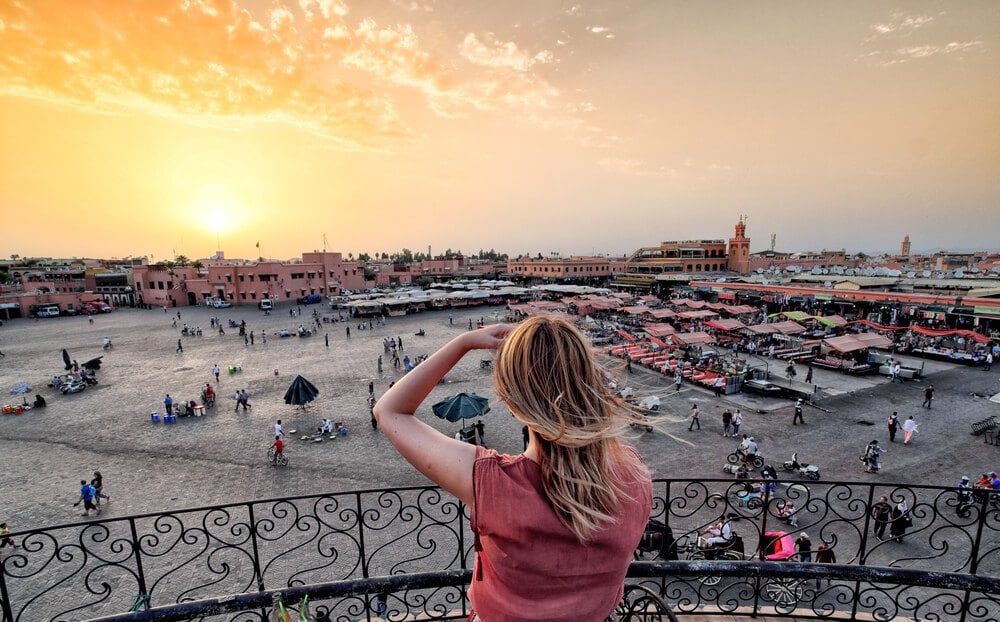
Women in Marrakesh is a whole other story. Solo female travellers thinking of a trip to this city are probably going to be nervous – and we can see why. There’s totally a risk going somewhere like Marrakesh by yourself, it’s not always very safe, but overall we think you’re going to be fine.
Other females travelling alone have a great time travelling Marrakesh and we’re confident that you could do that too. All you’ll have to do is follow your intuition and prepare yourself – and, of course, keep our tailored safety tips for solo female travellers in mind…
- Dressing modestly. Cover your shoulders, your knees, and don’t wear low-cut tops. Looser, baggier clothing is the name of the game. You’re going to be getting unwanted attention anyway, so try and limit it as best you can, which is why we don’t recommend tight clothing.
- Men in Marrakesh are usually quite harmless. You may get some catcalls, or comments, as you walk by men or groups of men. Just be smart and assertive; follow your gut on the best course of action for the situation.
- Understand cultural differences. Basically, men here have a different role to play in society than they do in your home country. Before marriage, Moroccan men don’t get much of a chance to meet single women, so usually, the comments and hassle won’t go much further than the sheer excitement of being able to interact with a female – and an exotic one at that!
- Don’t hesitate to ask for help. If you are lost or something stressful is happening, go to a woman, groups of women, or families, and ask for help. Do not approach young guys as this gives the wrong impression.
- It’s really, really not a good idea to walk around yourself at night time. This could be said for many other cities, but not only is it riskier than in the day, you just won’t feel comfortable.
- Find yourself suitable accommodation that has come favourably reviewed by solo female travellers before you. Budget hotels are usually no-go; cheap hotels above bars are usually brothels. So definitely do your research, find legitimate reviews that help you choose somewhere well located, where the staff has been praised for helpfulness, and with comments like “would go back” or something similar.
- Join a tour . Any sort of group activity (a walking tour, an excursion or day trip), either through your accommodation, or booked through an official channel, is going to be a good way to see the city and feel safe whilst you do it. There’ll be no opportunity for you to feel overwhelmed and you’ll get to chat with fellow travellers, too.
- Hire yourself a guide who can take you around the medina . Doing this will get you so much less hassle you wouldn’t believe; you’ll almost be able to explore as an insider, as the (probably male) guide you’re with will most likely be seen as your chaperone. Make sure the guide is reputable, however.
- Being a woman in Marrakesh gives you an insight into the world of women in the city. There are female-only spaces in the city, like sex-separated hammams and the top floor of teahouses, where you’ll get to rub shoulders with local ladies and see what life is like when the men aren’t looking!
- If you do go on public transport, make sure to sit next to another woman when you can. It’s just must safer and is basically the done thing anyway.
As a first-time solo female travel destination, we wouldn’t be recommending Marrakesh anytime soon. Unless you’re going to be spending time in a very expensive hotel, going on tours all the time and basically pampering yourself. We wish we could do that, to be honest!
We would, however, recommend Marrakesh as a place for solo females who have travelled places like this before. Many women make their way to the city, alone, and have a pretty awesome time. It’s true: it’s basically a fairly safe city to travel in, in spite of the reputation.
You just have to follow the same precautions you would do as a solo female traveller anywhere in the world. It’s just a little bit more mental in Marrakesh. There’s a lot of people, and a lot of men, but be confident , trust gut and you’ll travel like a pro in this city.
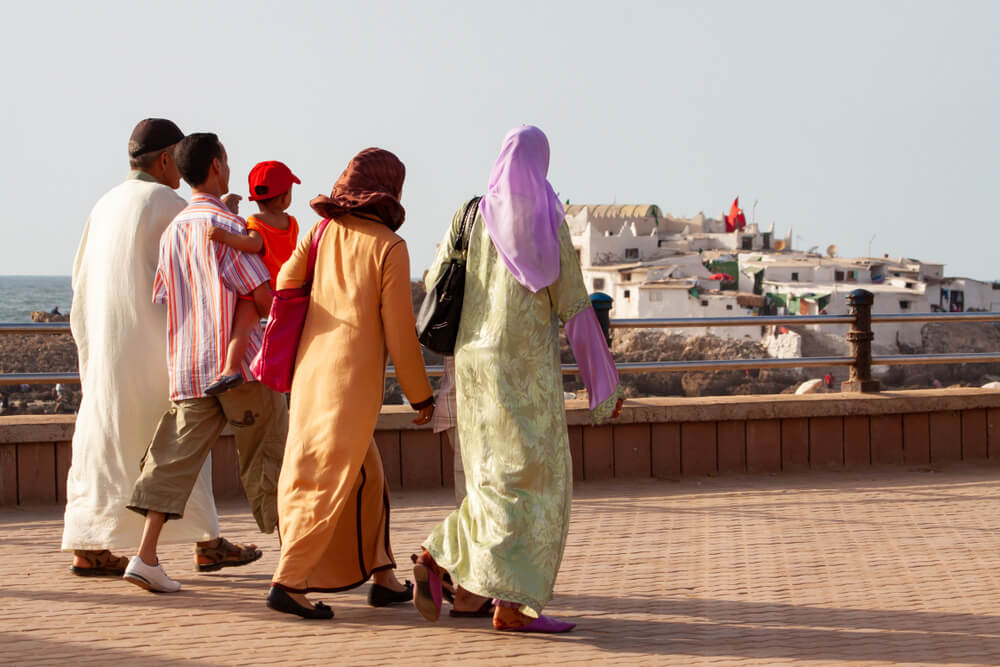
Marrakesh is totally safe to travel with families. It might be overwhelming at times and, yes, it can get pretty stressful, too.
However, in general, there’s nothing that is really going to apply to families that makes it any less safe than it would for any other type of traveller heading here. If you’re a travelling family anyway, or you are parents who have been to places like this before, chances are you’ll ace it.
We imagine you’ll be staying in one of Marrakesh’s family-friendly hotels. If so, there’s even more chance of your trip going totally smoothly. These hotels come with family rooms, family amenities, and people will generally be pretty happy to help you with any request.
Moroccans will welcome you with open arms in Marrakesh. In fact, you’ll probably get a lot of attention and having children, especially little ones, could help ease any potential tensions.
Children may find Marrakesh a bit overwhelming and you’ll probably want to take things at a slow pace. Don’t try to rush around the city seeing all the sights: it’s just going to make everyone stressed and tired – plus it can get super hot in Marrakesh.
Speaking of which: make sure your children are covered up between noon and 4 pm when the sun is at its strongest (sunscreen is a must).
If you’re travelling with teenage girls, take tips from teenage girls the same age in the city and try to follow what they’re wearing.
If you’re heading out to eat with your children, local restaurants usually welcome families. You’re probably going to want to be careful about food; make sure it’s been served to you hot. Salads should probably be avoided. Picky eaters will probably be ok eating things like bread and potatoes, but it’s a big city with a fair few international eateries, too.
Don’t expect to find facilities in most restaurants – we’re talking things like high chairs and children’s menus. However, they will accommodate you; big meals with all the family are very much the norm in Morocco and people will try their best to get you and your family seated in their restaurant.
With smaller children, you’ll probably want hand sanitiser, just so they have clean hands before they eat. Also, avoid dogs.
If you need things like nappies and baby formula in Marrakesh, you can find them but not everywhere. It’s a good idea to come prepared; pack things you and your children use daily, assume that you won’t be able to get what you need.
Overall, however, Marrakesh is safe for families.
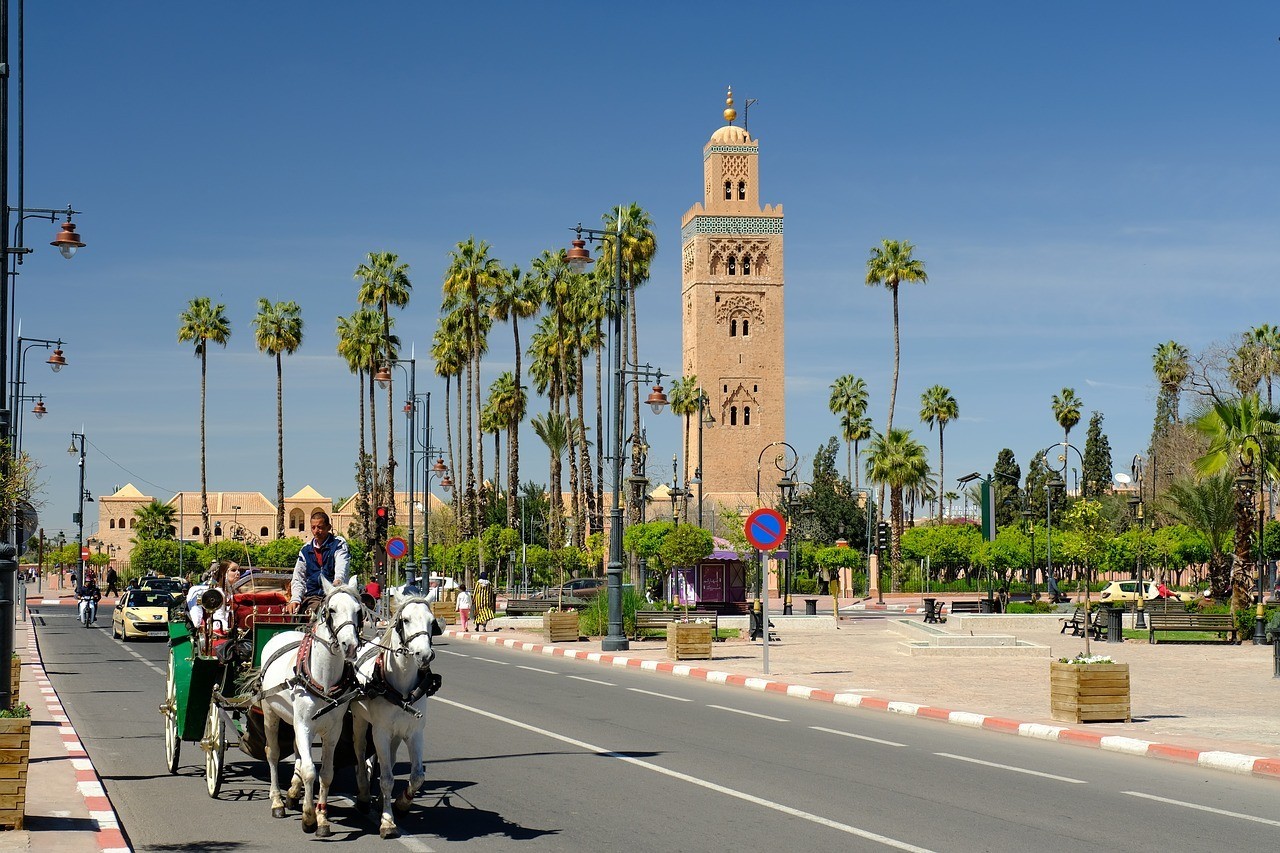
Driving in Marrakesh is crazy. Honestly, if you’re thinking about driving here think again .
Traffic comes from all directions. It’s very confusing. There’s no regard for signposts. Overloaded motorbikes zoom up. Taxi drivers will lean out the window and chat with passing drivers whilst speeding. People drive erratically. Parking is hard to find. It’s basically just manic driving in Marrakesh.
Driving into the centre of Marrakesh is tough too. If you aren’t in an accident yourself, you’ll probably see one yourself – if not, plenty of near misses.
Morocco, in general, has a poor road safety record.
To put that into perspective for you, in 2018 the road fatality rate was 9 times higher than that of the UK. 3,485 people were killed on the roads that year across the country; it’s thought that over 100,000 people were injured in road traffic accidents.
It goes without saying that you should drive very, very carefully if you want to drive in Marrakesh. You’ll need experience driving in a place like this and you should definitely be a confident driver at that.
Even if you’re just going on a road trip from Marrakesh to Fez, for example, there’s still so much to worry about and take into consideration on the roads. Hustlers exist on four or two wheels on the road (really); there are overloaded lorries; animals in the road; pedestrians on motorways. There’s just so much that makes even a potentially “scenic” road trip not fun at all.
All in all, we don’t think driving in Marrakesh is safe and don’t recommend it at all.
Uber is not allowed to operate in Marrakesh.
There was a bit of friction between Uber drivers and taxi drivers, the latter hassling the former, so needless to say, it’s just not available anymore.
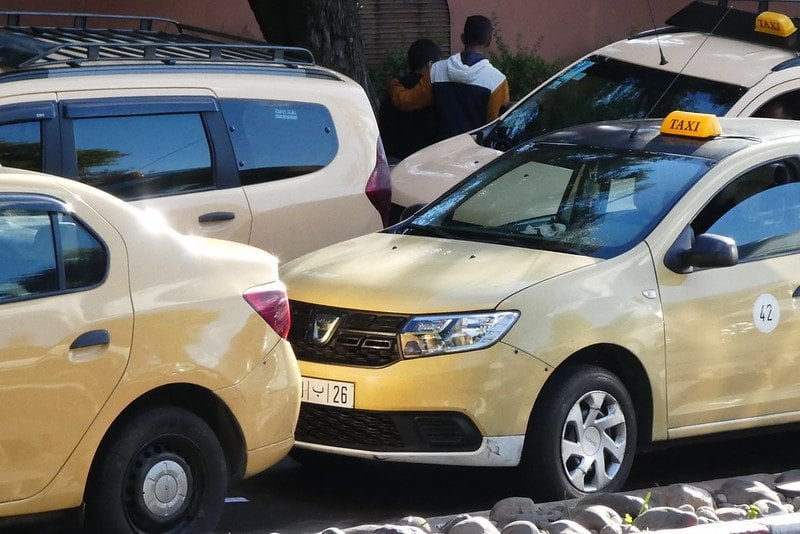
Taxis come in two forms in Marrakesh. There are petit taxis and grand taxis: small and big. Small do short distances, grand taxis do longer, but they can – at the whim of the taxi driver – pick up extra passengers, and drop them off wherever they need to go.
They can be found all over the place, 24 hours a day.
They all have meters but that’s not to say that every single taxi driver is going to activate their meter. They might want to negotiate the price of the journey instead – haggling is a national past time in this city, it seems. How do you get one? Just flag one down; there are that many.
To help you out on your taxi adventures in Marrakesh, we’ve got some pro tips for you.
- Small change. Going in with big notes is a rookie mistake. You’ll probably get ripped off, shortchanged, or given no change at all. Have 10 and 20 dirhams at the ready; it’s all about small change.
- Be friendly. The more chatty you are with the driver, the more you joke, whatever, the more it shows you as a confident, experienced person who is less easy to rip off. Talk less, and you’ll (most likely) be seen as a timid tourist who can be at least swindled of a few dirhams.
- Express your destination clearly. Have it written down, say it if you’re confident enough to say it, but make sure it’s right and follow the journey on Google Maps or equivalent maps app.
- Meter. If the driver doesn’t switch on the meter, ask them. If they refuse to turn it on, or suggest that it’s broken, ask them again. If they refuse a second time, just find another cab. This may make the driver change their mind, but either way, you’ll be able to find another taxi easily.
- Tip if you want. If you’re happy with the way the drive’s gone, it’s been funny, or the driver has been nice, knowledgeable, chatty (or all three), or you’re just feeling generous, it’s ok to tip. Don’t feel forced to do so, though, if the experience wasn’t good.
- Avoid conflict. Leave your principles at home: it’s probably not a good idea to get into an argument or verbal fight with your driver. Misunderstandings over what is probably a very small amount of money are just not the way to go.
- Arrange a taxi through your hotel. Usually, it’s more expensive, but you get a premium service, including one or more of the following: newer car, air-con, English-speaking driver, who knows where they’re going.
To sum up, the taxis in Marrakesh are pretty safe. Sometimes the cars are a bit not up to par with Western safety standards (missing window winders, cracked windscreens, questionable interior decor), the drivers may be super speedy, you might get ripped off. However, as long as you’re smart and confident with how you approach the situation, you should be fine. Taxis will get you from A to B most of the time.
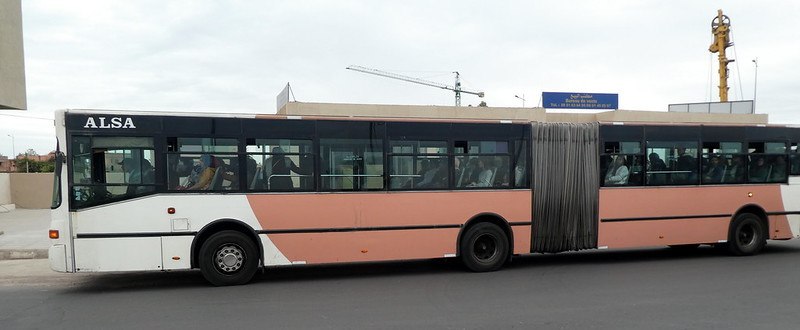
The public transport in Marrakesh is not the best – not much so much in terms of safety but just how not very good it is.
You might not even need to use it. The medina in Marrakesh is only traversable, really, by foot – maybe on a bike or a scooter.
For the rest of the time you can take taxis, which are generally inexpensive, but never fear: for the truly budget-minded there are local buses.
These are pretty old, they’re usually jammed full and make for a generally not very nice way to travel. Unless you’re used to this way of travelling around or fancy a truly local experience, then you might not want to use buses in Marrakesh.
The buses are run by a company called Alsa. There’s a route map on their website , which – we’re going to be honest – could come in handy. Running times are from around 6 am till about 9:30 or 10 pm. Most buses run every 20 to 15 minutes and are pretty cheap.
You’ll find the Central Bus Station in the heart of the Old City from where you will be able to catch buses on different routes all over the place.
There are also long-distance buses which take you out of the city to other destinations – they are usually air-conditioned and are not too bad.
Horse-drawn carriages can will and definitely want to take you around the city. They’re pretty popular, pretty traditional and kind of touristy. There are actually set prices for the routes, but there may be some bargaining involved: be prepared to haggle, sometimes with more than one person at once.
Basically, there’s not too much to worry about. The public transport in Marrakesh is safe-ish, but it’s not exactly world-class and you will have to watch your pockets and keep an eye on your luggage, too.
(PSSSST – Are you visirting Marrakesh? Well have a look at our Weekend in Marrakesh Itinerary)
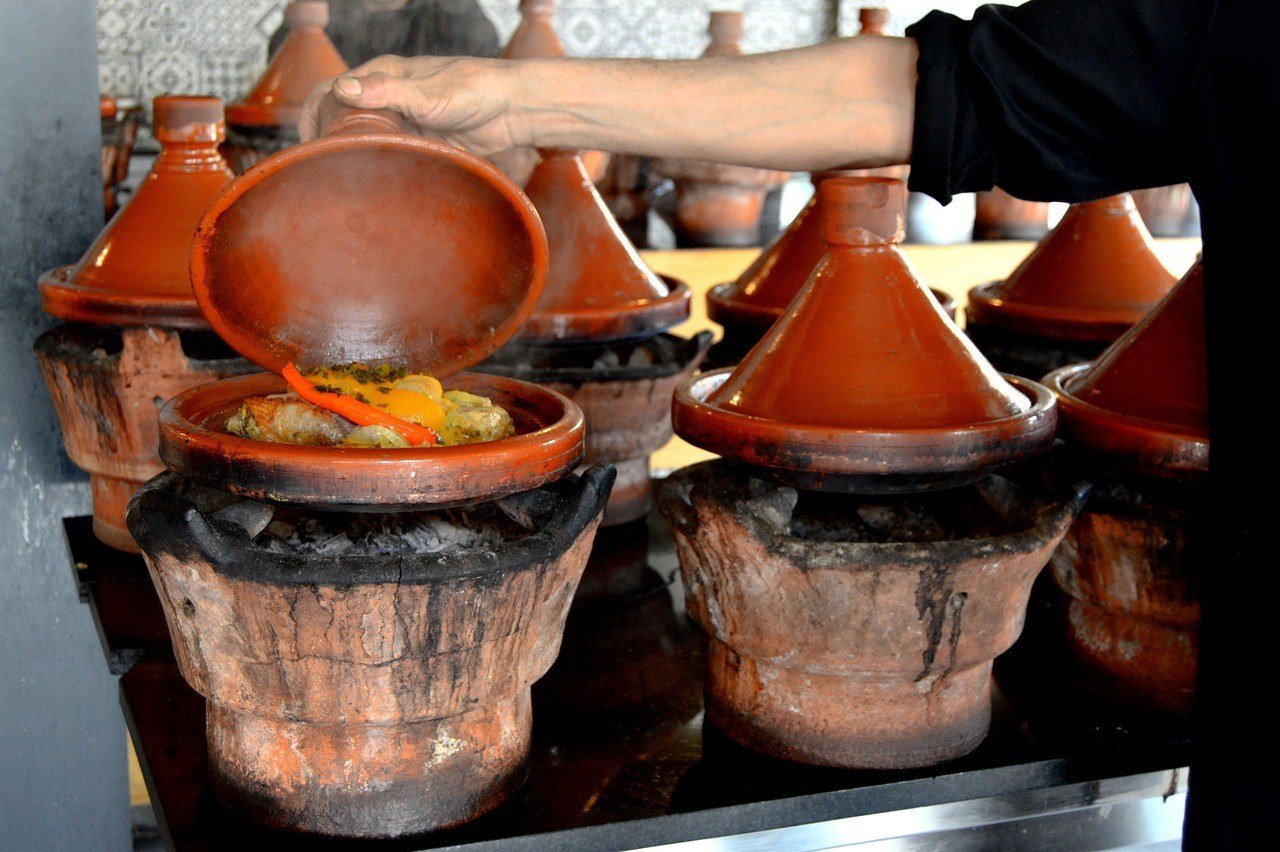
Food in Marrakesh means Moroccan food and that means tagine , tasty salads, flatbreads, and that ubiquitous Moroccan favourite very sweet mint tea. Don’t forget the sweet puddings, doughnuts and other delights that can make this city a veritable haven for foodies.
However, you should be careful. The food in Marrakesh is not always going to be up; it’s easy to get a stomach bug from something as simple as the cutlery that’s not been washed up so properly, so here are some pro tips to help you and your stomach have a good time here…
- Go where the locals go. If there is a local looking place that you want to try, there’s one main way to see if it’s a good place to eat and that’s the number of local people hanging around outside or eating inside – or both. If it’s busy, it’s popular; if it’s popular, it’s tasty and unlikely to be giving people upset stomachs.
- Eat at the right times. Chances are the food is going to be freshly cooked at respective meal times. That means you should be eating lunch when locals are eating lunch, going out for dinner when they’re eating dinner. It’s simple and means you won’t have leftovers or seconds that nobody wanted the first time around.
- Be careful with hotel buffets . They can be a great way to explore Moroccan food without being too scared of walking into a local restaurant. However, hotel buffets can be a hotbed of potential tummy troubles; make sure you eat (again) at the right time. If lunch runs from 12 to 3 pm, go at 12 – not 3; it’s more likely not to have been sitting around attracting germs and ceasing to be fresh and hot.
- Go slowly. It’d be a shame to miss out on all of Marrakesh’s tasty food, and a good way to make yourself ill is to overeat, which is easily done if it turns out you are a particular fan of Moroccan food. Limit yourself, especially on the spicy stuff, and you should be fine.
- Be careful with fruit and salads. You don’t know how thoroughly they’ve been washed, what sort of water they’ve been washed with, or if they’ve been washed at all. With no cooking involved, germs will stay on these fresh foods unless they’re cleaned properly; even then they can be sketchy. To be on the safe side, avoid.
- Keep your hands clean. At restaurants in Morocco there’s usually a sink to wash your hands, which is great, but don’t expect there to be soap; there often is none. This is because a lot of food is eaten with hands. You’re going to make sure they’re extra clean. Make sure they’re extra clean by using an anti-bacterial wash or hand sanitiser. Another thing related to hands is what each one does in Morocco traditionally. The right one is for eating, the left… well, you know. To keep yourself germ-free, maybe consider adopting the same policy!
At the end of the day, food in Morocco is tasty but it can be difficult to find the best places to eat. Luckily for you, there’s the internet. You can look at TripAdvisor for the best places to eat in Marrakesh , read reviews, and find somewhere that sounds as though it’s going to be amazing.
That said, sometimes you can just not be used to a change in diet. If you’ve got a particularly sensitive stomach, you may get ill just from eating anything; in this instance, maybe think about bringing anti-diarrhea tablets and re-hydration sachets, just in case. But overall, food in Marrakesh is safe and super tasty!
You may be thinking that you can’t drink the water in Marrakesh but you would be incorrect in thinking so.
Generally, the water in Morocco is safe to drink, but it is very chlorinated which you might not like at all.
If you’re not feeling chlorine-y water at all and would rather something, well, better, then bottled water is widely available – don’t worry. If you don’t mind it, you can bring a refillable bottle to save the planet and your wallet. If you’re overwhelmed with the number of bottle options, not to worry anymore, we’ve put together a guide for the best travel water bottles in 2024 .
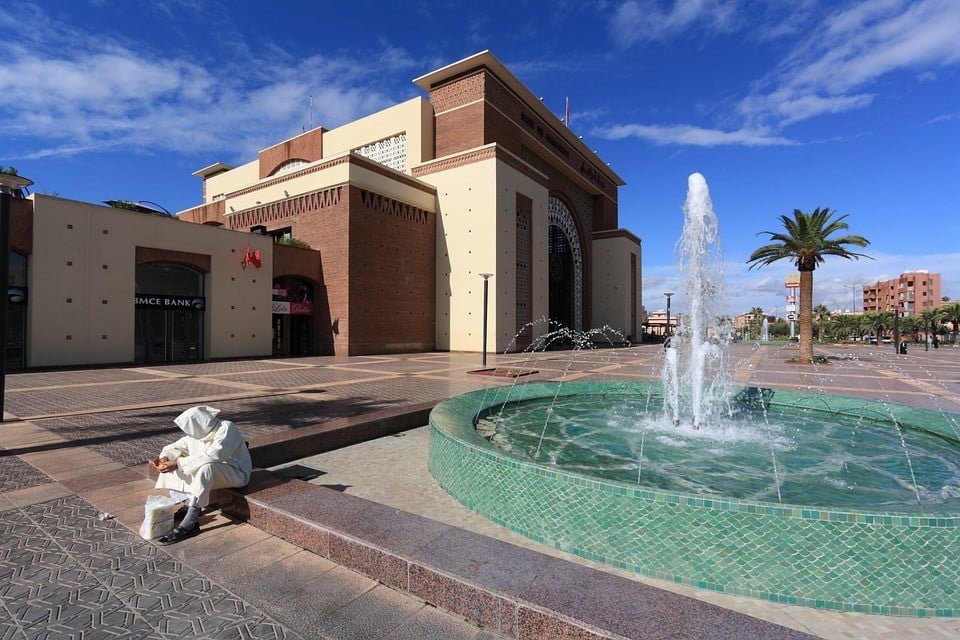
Marrakesh is a big, busy city – in fact, it’s one of the busiest cities in Africa. This is a massive tourist destination and a huge economic hub for Morocco as a whole and it’s a great place to visit.
If you’re thinking about living, however, there are probably a few concerns you have.
Obviously, there’s the romance of living in the walled luxury of a riad, but then again you really are going to be consistently and constantly challenged by simple, everyday life in Marrakesh.
The roads, we keep saying, are very unsafe, the summers are incredibly hot and the winters are cold – especially at night.
If you’re not a fan of being around so many people in your day-to-day life, then you’re going to find it quite stressful living in such a busy city. As a side note, things can get quite pricey in Marrakesh.
The levels of bureaucracy are actually pretty crazy in Marrakesh. Not only that, the annoyance of having to fill in forms for just about everything is heightened by not knowing either the culture or the language. Learning some Arabic is really going to help you out; not just speaking, but reading, too. If you approach it the right way, it might even be fun to learn a new language!
Another thing is that you’ll be living in a Muslim country. This may be fine if you’re a practising Muslim, but if you’re not you could find that it affects your everyday life in a way that you’ve never experienced. Everything from alcohol laws, to not being able to eat in public during Ramadan, can get tricky.
Living in Marrakesh, you’ll probably get used to the hassle; you’ll probably be able to, gradually, find your way around and walk around confidently. Even so, you will most likely be seen as a tourist and approached as such – if not, you’ll be seen as rich Westerner (if you are Western).
In terms of where to live, you may want to consider the suburbs. Summers here will be quieter, safer, with fewer tourists, but may lack the buzz and authenticity that drew you to Marrakesh in the first place.
Marrakesh isn’t a particularly unsafe place to live, it’s just that there are going to be a lot of adjustments that you have to make, including different social boundaries to be aware of.

A new country, a new contract, a new piece of plastic – booooring. Instead, buy an eSIM!
An eSIM works just like an app: you buy it, you download it, and BOOM! You’re connected the minute you land. It’s that easy.
Is your phone eSIM ready? Read about how e-Sims work or click below to see one of the top eSIM providers on the market and ditch the plastic .
Healthcare in Marrakesh is both public and private.
If you’re visiting the city, and something happens to you, you’ll most likely want to visit a private facility. The public healthcare in Marrakesh can suffer from underfunding, meaning a lack of staff and equipment, basic facilities and long waiting times.
If you want to see a doctor, you can usually just walk into a doctor’s surgery or clinic; for some, however, you may need an appointment to see a GP (general practitioner).
To get yourself to a good clinic or hospital, ask the staff at your accommodation – they’ll know the best ones in town.
When it comes to getting advice, picking up prescriptions, and buying over the counter medical supplies, pharmacies are all over the city and are identifiable by either a green crescent or a green cross. Pharmacies in the city are generally pretty well stocked with medication; advice can be supplied, but it will probably be in French (the “educated” language in Morocco).
You may be surprised to learn that you can buy things like anti-biotics over the counter at pharmacies. At first thought, that’s great! However, you should be very careful as you’re not a doctor and won’t know what you’re buying, that’s why doctors prescribe things and not you.
Basically, the healthcare system in Marrakesh isn’t that good in terms of public. Go private, we say, and make sure that the insurance you have covers you for this.
Here are some quick answers to common questions about safety in Marrakesh.
What should you avoid in Marrakesh?
If possible, avoid these things in Marrakesh to stay safe: – Don’t be careless when getting money out of the ATM – Avoid overfriendly or sketchy people on the street – Don’t look wealthy – Don’t show any sort of affection (unless you’re in a heterosexual marriage) in public
Is Marrakech dangerous for tourists?
Marrakech can be safe for tourists that respect the local culture, use their common sense and did a lot of research and preparation before their trip. Marrakech is beautiful but there are real problems with petty theft and scams.
Is Marrakech safe for female tourists?
Yes, Marrakech can be safe for female travellers, especially when accompanied by another friend. It really pays to do some research on the city, stay alert at all times and keep your wits about you.
Is Marrakech safe at night?
Since most sketchy characters come out after dark, we definitely won’t recommend going out at night – whether that’s for a couple of drinks or travelling to your next destination. If you need to go out, get yourself a reliable taxi.
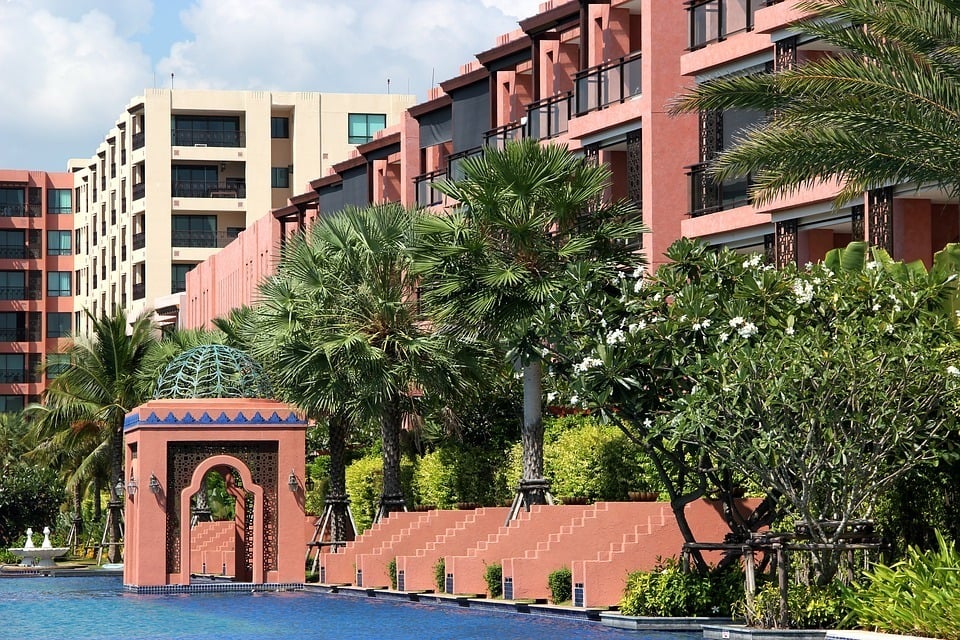
Sometimes the reputation of a place goes before it and, actually, the destination isn’t half as bad as you imagined. In the case of Marrakesh, however, we would think it’s pretty fair to say that this city is as mad as people say it is. Take it from us, if you’re easily overwhelmed, hate the hassle and feel stressed out in crowds, then you might find it a little bit difficult staying cool-headed in Marrakesh.
However, hassle and all that comes with it doesn’t mean that a city isn’t safe and that goes for this one. If you are the sort of person who just doesn’t know how to get rid of people trying to sell them stuff, learn to say ‘no’ politely and move on; have a joke with people and try not to get annoyed at being pestered. The whole buying, selling and haggling thing in Marrakesh is a game – it’s not very serious.
As we said, hassle doesn’t mean a place isn’t safe. If you can get over that, then there’s the safety points, the pickpockets and scammers, but if you look confident and walk like you’ve been to Marrakesh before, chances are people aren’t going to try any ‘unsuspecting tourist’ stuff on you. Lo and behold you’ll probably get hassled less – because you don’t look like you might crumble under a bit of persistence!
Disclaimer: Safety conditions change all over the world on a daily basis. We do our best to advise but this info may already be out of date. Do your own research. Enjoy your travels!

And for transparency’s sake, please know that some of the links in our content are affiliate links . That means that if you book your accommodation, buy your gear, or sort your insurance through our link, we earn a small commission (at no extra cost to you). That said, we only link to the gear we trust and never recommend services we don’t believe are up to scratch. Again, thank you!
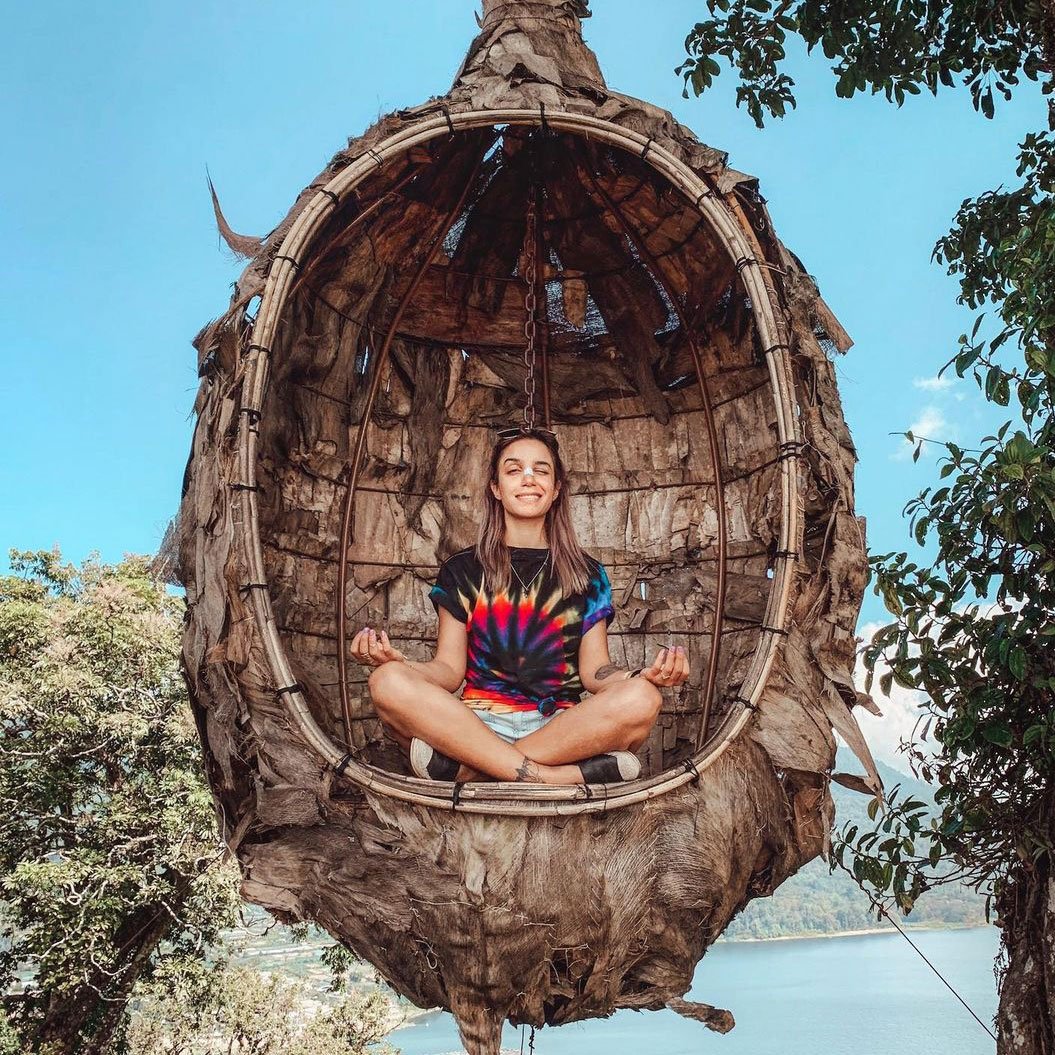
Share or save this post

Leave a Reply Cancel reply
Your email address will not be published. Required fields are marked *
Save my name, email, and website in this browser for the next time I comment.
Notify me of followup comments via e-mail.

Is Morocco safe? Yes, if you’re aware of tourist traps
I found myself in the bustling heart of Jemaa El-Fnaa markets, in Marrakech , when a wave of unease swept over me. It wasn’t the crowd or the blaring music that triggered it, but a cautionary tale from my Intrepid Travel guide, Brahim.
“Whatever you do,” he told our small tour group “never follow anyone anywhere unless they have a certified tourism operator lanyard,” he said, holding his up so we could see.
“People will tell you they know of a secret market, or special event or shortcut, but instead they will lead you to a quiet alley where others may be waiting, and mug you”.
The dread was because, just several days prior, I had been promised such a ‘shortcut’ by a stranger. Not knowing better, I had followed him.
I don’t consider myself a particularly naive traveller. Sure, I’m a Kiwi, so I’m likely more trusting than the average person but my gut is good when it comes to sensing when things are off. As I would learn, it saved me from a potentially dangerous but allegedly common tourist trap in Morocco .
Before visiting Morocco, friends expressed concerns about me exploring cities alone, but my initial day in Marrakech surprised me with the warmth of its people.
After mentioning having free days in Marrakech, a young concierge from my hotel spent 25 minutes writing me a detailed itinerary for Tangier , jotting down recommended beaches , hotels , restaurants and even trains I should take to get there.
Read More: Best things to do in Marrakech, Morocco
After visiting the famous Jardin Majorelle later that day, I decided to walk 25 minutes back to my hotel (still uncertain about taxi prices), when a small elderly man fell into step beside me and began chatting.
As it happened, he had worked as a gardener at Jardin Majorelle for decades and asked if I enjoyed the visit. He then cycled through the typical tourist questions (Where was I from? Had I visited Morocco before? Where do I plan to visit?) and the conversation flowed easily. As we strode along dusty footpaths, I asked what his plan for the rest of the day was, attempting to wrap up the conversation.
He said he was off to a special celebration in a nearby Mosque and invited me to come and observe. As someone who loves getting off the beaten track, I was intrigued.
He then asked where I was heading and when I mentioned returning to my hotel in the old town he said that, not only was the celebration only known about by locals but was also a shortcut to the old town, pointing to a warren of streets to the left. As we crossed a busy intersection, I glanced at the map on my phone, certain my route to the right was the most direct.
My gut softly twinged but I didn’t want to be close-minded or judgemental. I wanted to be carefree and intrepid, to open myself up to these twists of fate that can often turn into the best stories. At the time, I had my credit card, passport, driver’s license, DSLR camera and about one hundred dollars of cash on me.
So, we turned left, away from the start of a busy market and he began talking about his wife and young children. With every step, the little knot in my gut tightened until, two minutes later, I stopped and said I was turning back.
“No no,” he said, “trust me it’s going be incredible, you want to see it”. I paused, unconvinced. “I understand why you might not trust me but I have a job, I have children and a family, you can trust me,” he added.
- Morocco travel: Best things to do in Marrakech to help ...
- Meet the feminists living in the foothills of Morocco ...
- Is it safe to travel to Morocco? Tour operators pledge ...
I was torn. I didn’t want to stereotype an innocent guy who simply wanted to show me a good time in Morocco and I didn’t want my wariness to hurt his feelings.
But, his increasing urgency, repeating how I could trust him, only tightened my gut further. Suddenly, I reached for my phone, and pulled it up to my ear, as if receiving a phone call.
“Hi Dad,” I said, hiding my blank screen from the man. “Oh, okay, I can come back, yes I’m 10 minutes away, I’ll start walking now.” Putting my hand over the speaker, I told the man I had to return to the hotel, spun around and quickly strode back to the right. The man began shouting for me to come back but I continued, phone to my ear, continuing my ‘call’ with a parent who was most certainly in New Zealand.
Unscathed, I forgot the experience quickly, until a few days later, in Jemma El-Faa market, when Brahim delivered his safety advice.
It was daunting to imagine what may have happened if I’d followed that man into the labyrinth of streets. I was glad to learn of this tourist trap the easy way but it did remind me of the line between trust and caution; one every traveller must draw for themselves.
On one hand, you don’t want to travel perpetually terrified of threats and strangers. Some of my best travel memories were made after meeting people and jumping on bandwagons. On the other hand, risks do become riskier when you’re in a foreign environment far away from support and people aren’t always as honest as back home.
The trick, for me, is taking precautious first and then accepting opportunities second, as long as I’m free to tap out when my gut speaks up. Update friends and family if you accept spontaneous plans or travel with new people. Don’t walk around with all your valuables on you (as I did), and always prioritise your gut instinct above someone feeling judged.

Everything you need to know before going to Marrakesh
Nov 29, 2023 • 6 min read
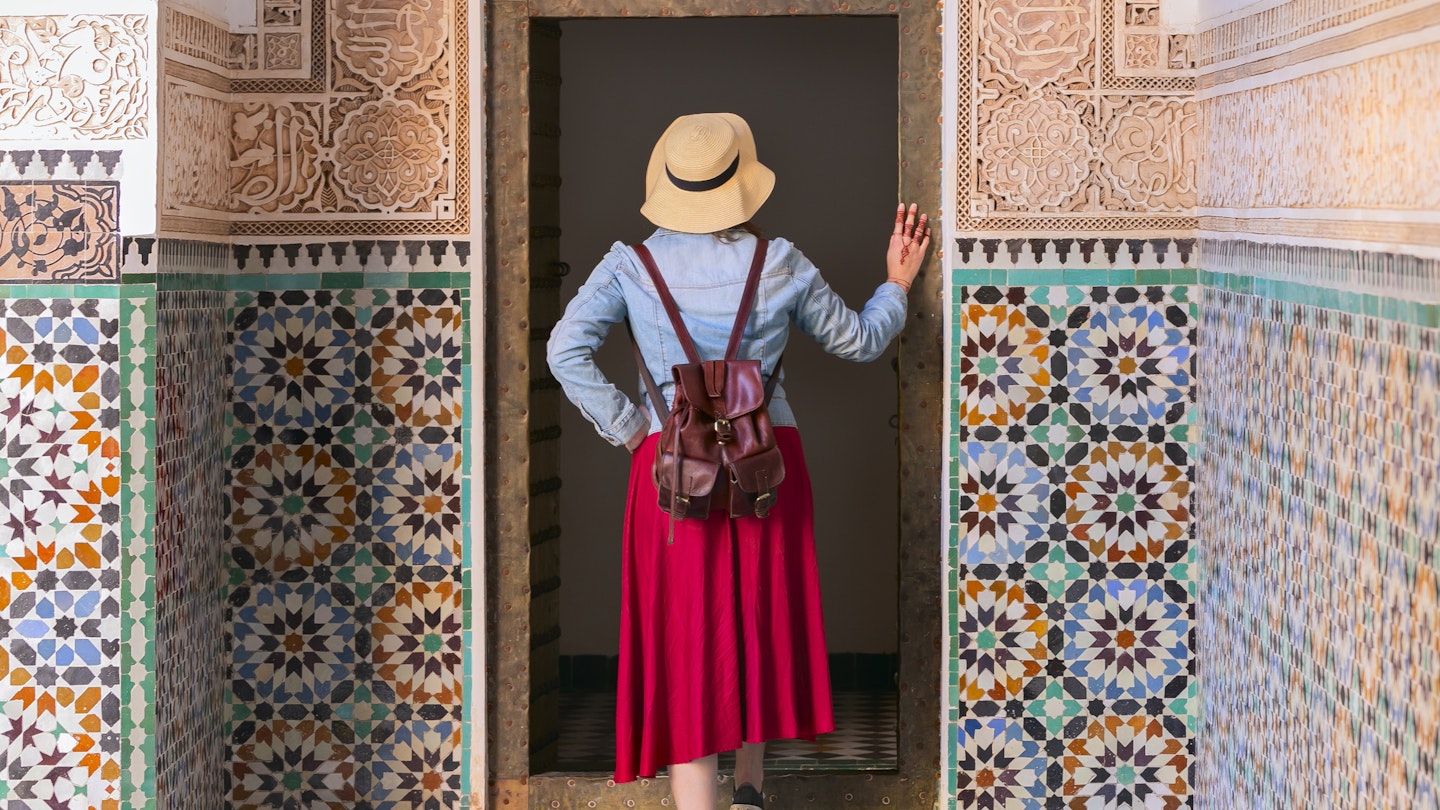
Marrakesh can be a sensory overload for first-time visitors so read on for some local advice before you go © minoandriani / Getty Images
I lived in Marrakesh full-time for almost 10 years with no intention of leaving. My life in Morocco was colorful, diverse and endlessly inspiring for a curious, creative soul like me. And today the city’s intrigue and magic continues to pull me back.
I will never tire of wandering the tiny alleyways of the Marrakesh medina, stopping for a nouss nouss at Cafe des Epices or gazing at the art deco architecture throughout my Gueliz neighborhood, stepping inside to discover independent art galleries .
Picture-perfect guest houses, and chefs putting a creative spin on local cuisine, are also part of the charm. The design scene in Marrakesh is second-to-none, and in my opinion unique in Morocco as traditional artisans sell their wares alongside contemporary designers, putting a new touch on the traditional techniques and crafts.
A visit to Marrakesh is not about ticking sites off a must-see list but rather meandering – stumbling upon a historic site and watching the world go by from a street-side cafe – the city itself is a sight. Allow three days to see the main historical sites, sample local cuisine and take in a bit of shopping, but design lovers could easily spend a week here.
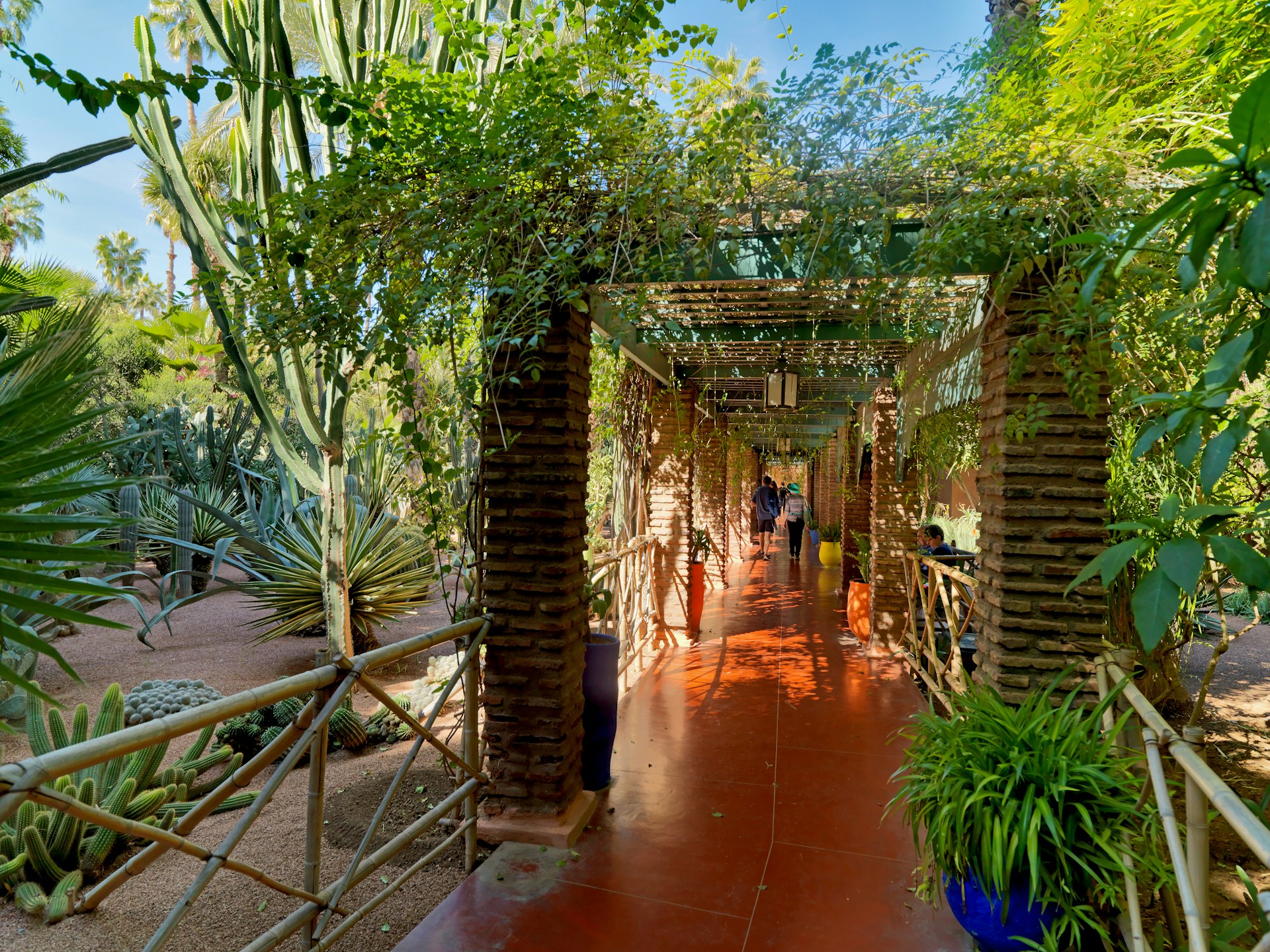
1. Plan your days prior to arrival
While there is something to be said for spontaneous wanders and chance encounters, Marrakesh is the country’s leading tourist destination and guides, experiences and restaurants book up days, weeks and months in advance.
Jardin Majorelle and the nearby Musée Yves Saint Laurent require online advance bookings via their website. To ensure a table at popular restaurants like +61 , La Famille and Nomad , book prior to arrival for best availability.
2. Book an airport transfer or catch the local bus
It’s best to organize an airport transfer via your accommodation provider for a smooth arrival. Taxis have a reputation for overcharging clients, despite posted rates. A city bus departs frequently from the airport to Djemaa el Fna and destinations throughout Gueliz for Dh30 (cash only). Find the bus stop beyond the waiting taxis, near the car rental offices.
3. Hone your negotiation skills in advance
From haggling in souqs to negotiating fares with taxi drivers, bargaining is commonplace in Marrakesh. Shopkeepers often state an offer and the buyer is expected to negotiate a price they are prepared to pay. I say: pay what the goods are worth to you . You may find the same item cheaper (or more expensive) elsewhere, but is that worth worrying about? It's all part of the Morocco experience.
Prior to hopping in a cab, negotiate a price in advance if the meter is not activated, or if it (notoriously) doesn’t work. The price within Marrakesh city limits shouldn’t cost more than Dh30 if the meter is activated. Daytime rates start at Dh1.70 – Dh2.40 at night – and increase based on distance. If the meter does not work, negotiate the price in advance and make sure you have small bills and coins to pay the exact amount agreed upon (the amount will already include a tip).
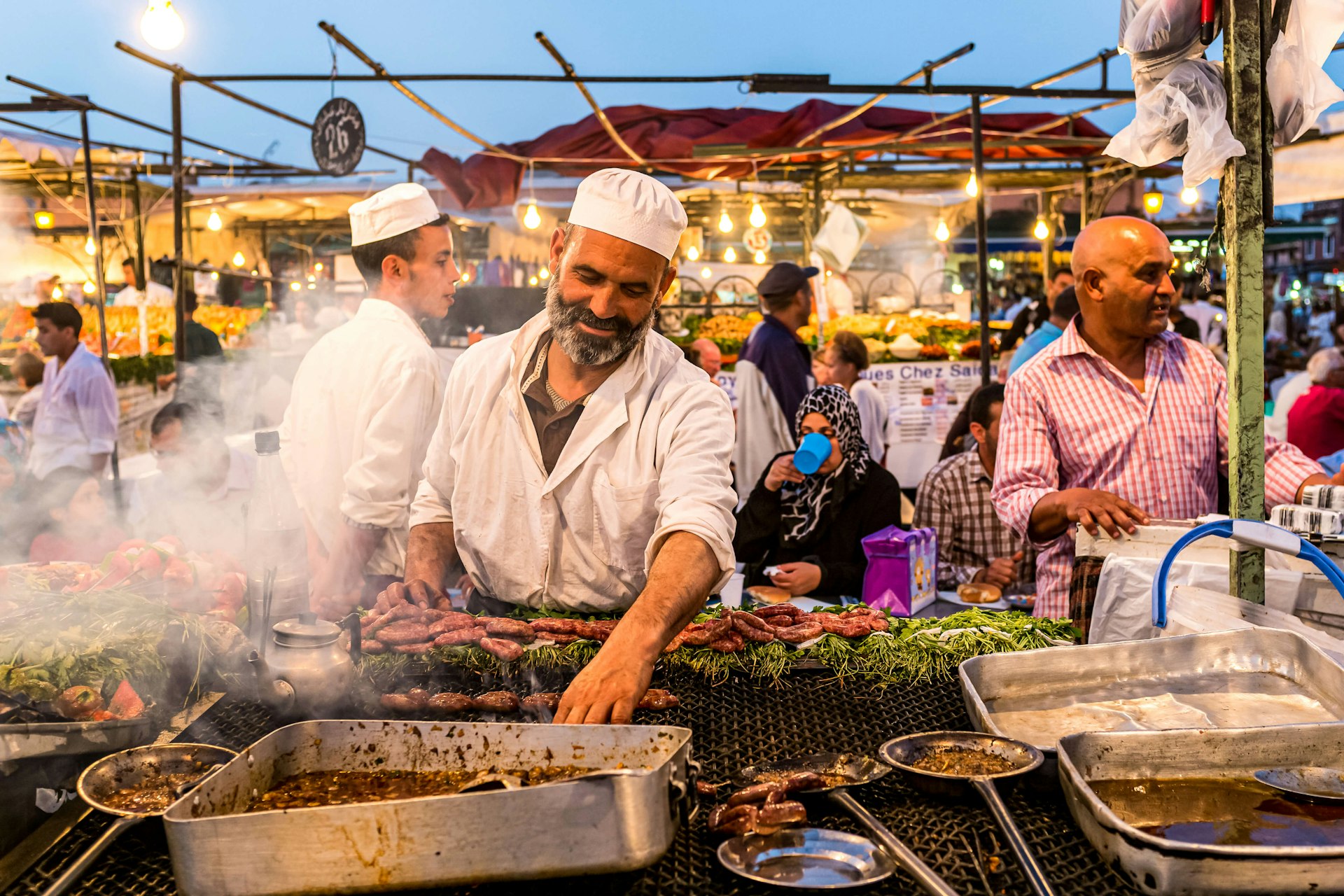
4. Be wise about the street food you eat
Some of the best food is served up street side in Marrakesh. When deciding where to eat, consider how many locals are pulling up a seat to tuck into the local delicacy like msemen (pancakes), harira (soup) or a tajine. In Djemaa el Fna , opt for stalls where the food is prepared in front of you.
5. Stay current
Morocco’s Dirham is a closed currency, and visitors are permitted to arrive and leave with a maximum of 1,000 Dirhams. Most ATMs distribute up to Dh2,000 per transaction to a daily maximum of Dh4,000 per bank card, though this varies by international bank. All banks will charge a fee.
For the best currency exchange, head to Hotel Ali in Djemaa el Fna or Hotel Farouq on Avenue Hassan II near the train station.
6. Dress like a local for a comfortable experience
For women, I suggest ditching any belly tops and short shorts while wandering in the Marrakesh medina, one of the city’s most traditional neighborhoods. Instead, opt for dresses that fall below the knee or trousers and a shirt that covers your shoulders. For men, knee-length shorts or trousers are advised. For traversing the cobblestoned and uneven footpaths, flats are best, ideally close-toed.
7. Don’t avoid visiting Marrakesh just because it’s Ramadan
Don’t put off a trip to Marrakesh during the month of Ramadan. It provides an insight into another aspect of this rich culture. Locals will expect that visitors will want to eat and drink, even while out in public. Guides may join you at the table and won’t want you to feel guilty about eating or drinking. During this holy month it is even more important that you're mindful about alcohol consumption.
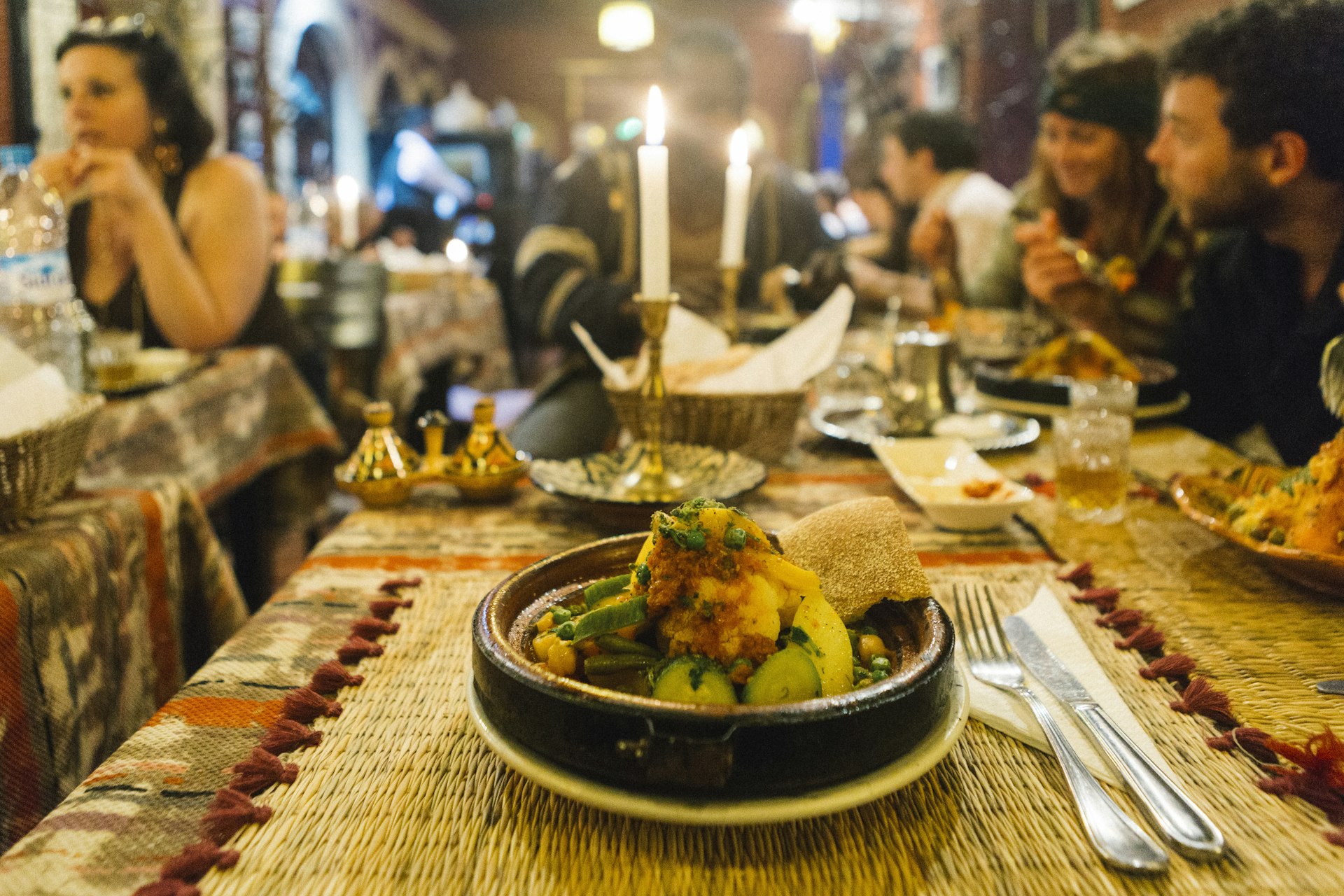
8. Local table manners
When accepting a sample of olives or dates in the souqs, or sharing a tajine with locals, always use and eat with your right hand. If invited into a local’s home, arriving with some sweet treats will be graciously received, and bakeries – Amoud, Pâtisserie Amandine and Café 16 – are local favorites.
9. When it comes to love, discretion is key
Sexual relations between non-married Moroccan men and women are not typically flaunted in public. It is illegal for an unmarried Moroccan to book a hotel room or self-catering apartment with a non-Moroccan. Discretion is recommended when it comes to flaunting one’s affection for their partner, regardless of nationality or sexual orientation.
10. Knowing a few words of Darija will earn you points
Though folks working in tourism often speak several languages, with English becoming increasingly common, learning a few words of Darija (Moroccan Arabic) will earn respect. Walking into a shop, it’s common to greet fellow customers and shopkeepers with an "Assalaamu alaykum" (peace be with you) and respond with “Wa alaykum ssalaam”. “Chakrun” for thank you, “la chakrun” for no thank you, and “afak” for please are also key.
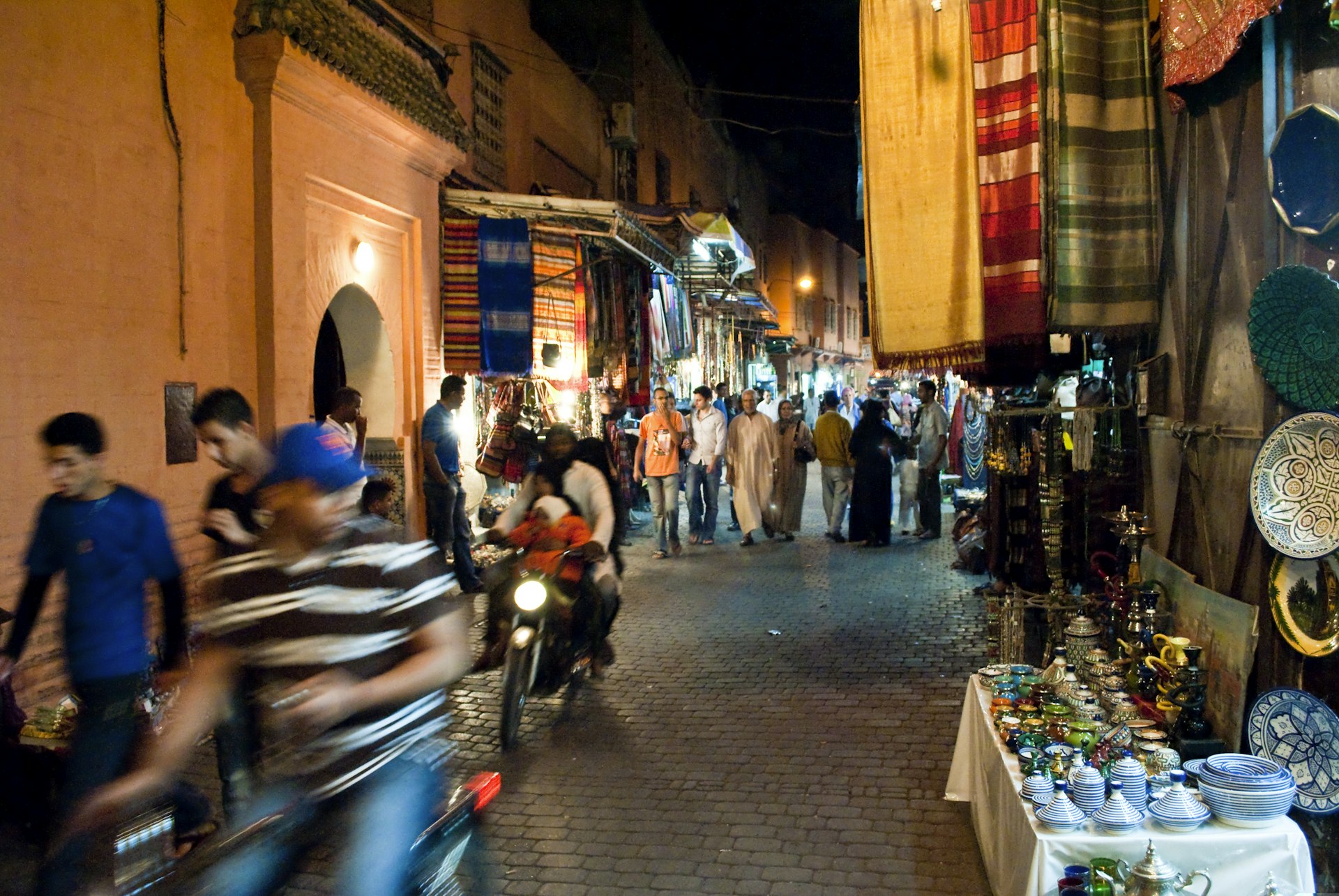
11. Problems you may encounter in Marrakesh
Stumbling upon a faux guide either on foot in the medina, or a man on a bike who claims to work at your hotel with offers to visit the Berber market or another special, can’t-miss event may result in being led to a family member’s carpet or spice shop. A firm, but polite “no thank you” is often sufficient as you walk confidently in the direction you plan to go.
While it may cause frustration, getting lost in the Marrakesh medina is part of the fun – until it’s not. If and when this happens, remain confident in where you’re going. Ask an older gentleman in the souqs for directions if necessary. If engaging a local lad to show the way, expect to pay for their assistance (Dh20 is reasonable).
Plain-clothes police officers roam the medina frequently and are there to help, taking tourist concerns seriously. A central police station is located in Djemaa el Fna.
Also note: Although Morocco experienced a magnitude seven earthquake in September 2023, with the area surrounding Marrakesh heavily hit, natural disasters within the city are rare.
12. Keep these must-have items in your day bag
Brushing one’s teeth with tap water is not likely to cause any health issues, but bottled or filtered water for hydrating is recommended. You’ll also want to pack hand sanitizer and wet wipes for days spent wandering, shopping and eating. Always keep a pack of tissues on hand for bathrooms which may not be stocked with toilet paper.
Explore related stories
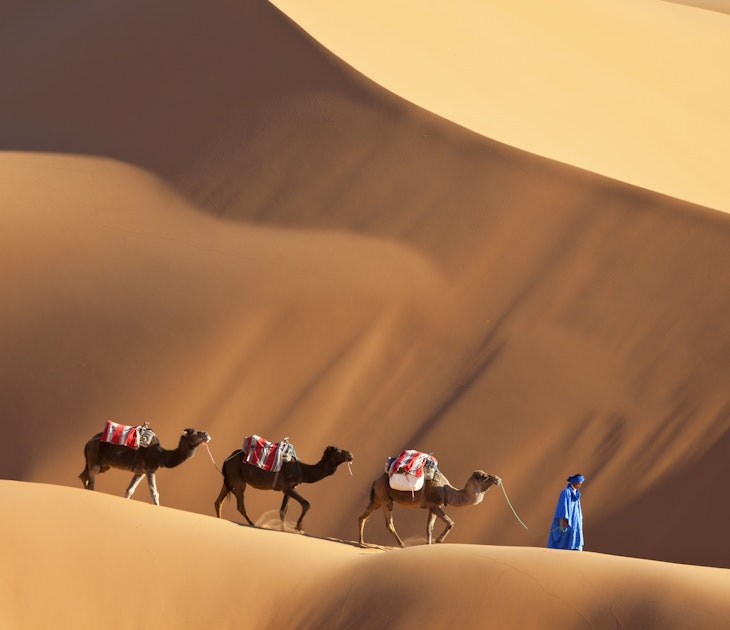
Festivals & Events
Mar 11, 2024 • 5 min read
Morocco is a fantastic year-round vacation destination, but the best time of year to travel will depend on your interests and holiday needs.

Feb 7, 2024 • 5 min read
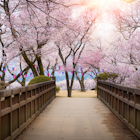
Jan 31, 2024 • 6 min read

Jan 27, 2024 • 15 min read

Jan 17, 2024 • 8 min read
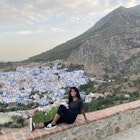
Jan 17, 2024 • 6 min read
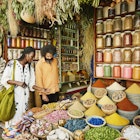
Nov 24, 2023 • 8 min read
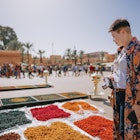
Nov 20, 2023 • 5 min read
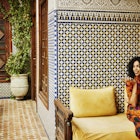
Oct 15, 2023 • 7 min read

Oct 11, 2023 • 7 min read
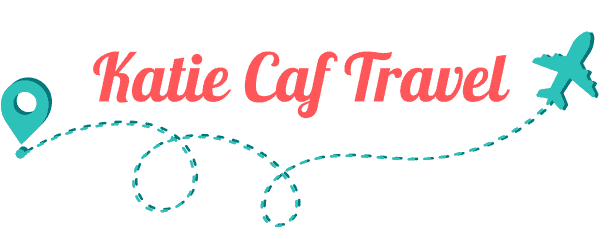
25 Essential Morocco Travel Tips for Your First Time Visiting!
Morocco is a tricky destination for travelers, it’s full of harassment, touts, and scammers, but also gorgeous architecture, great food, and kind people. I’ve been traveling to Morocco frequently over the past three years and here are 25 essential Morocco travel tips I wish I had known before my first trip!
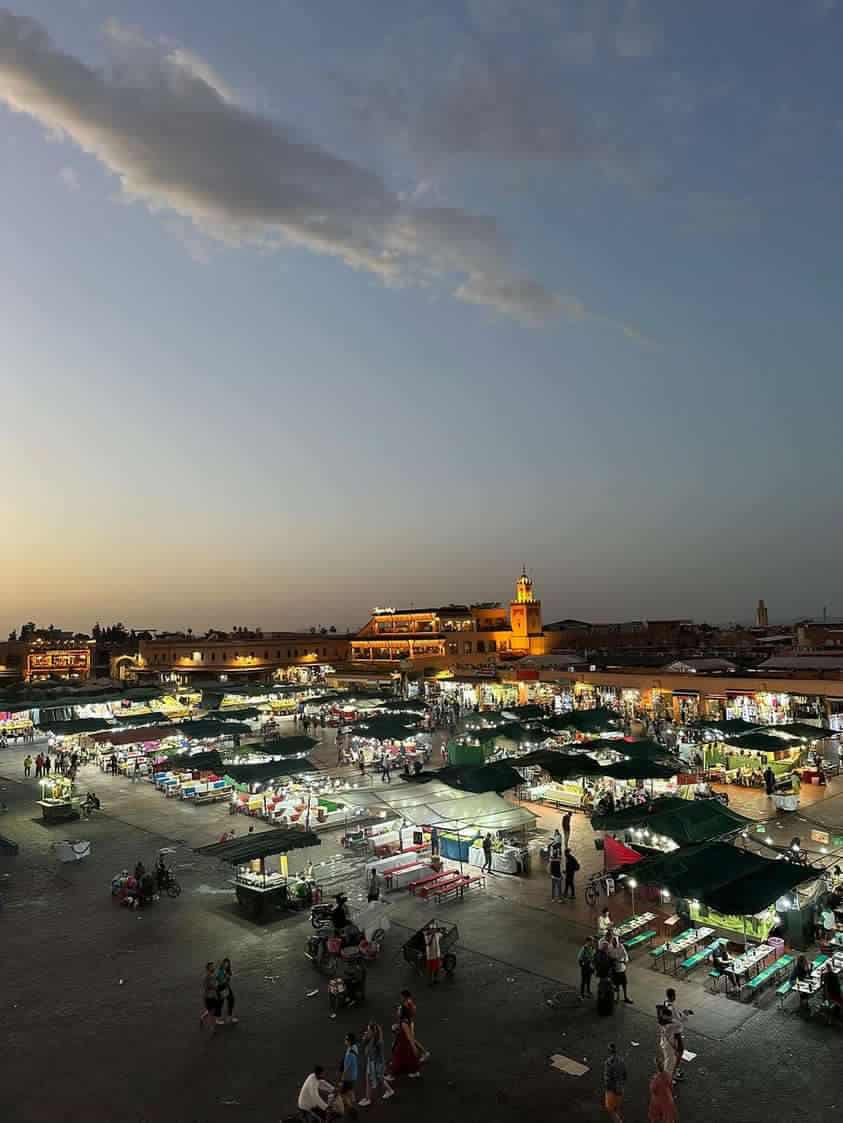
25 Essential Morocco Travel Tips
1. don’t listen to anyone who comes up to you on the street .
There are a lot of Morocco travel scams ! This is sad but really no one approaching you on the street in the bigger cities like Marrakech or Fez is doing so to be nice. Or at least, that’s the mentality you should keep. As a rule: don’t pay any attention to anyone coming up to you on the street. Just keep walking.
People will come up to you every three minutes saying “My friend”, “where are you from?”, “What is your name?”, “Where are you going?”, “you’re going the wrong way”, etc. You can’t interact with them all. If you need to ask for help, Moroccan people are really friendly, but anyone coming up to you on the street for any reason is likely a Tout and they’re just going to bother you and ask you for money at the end.
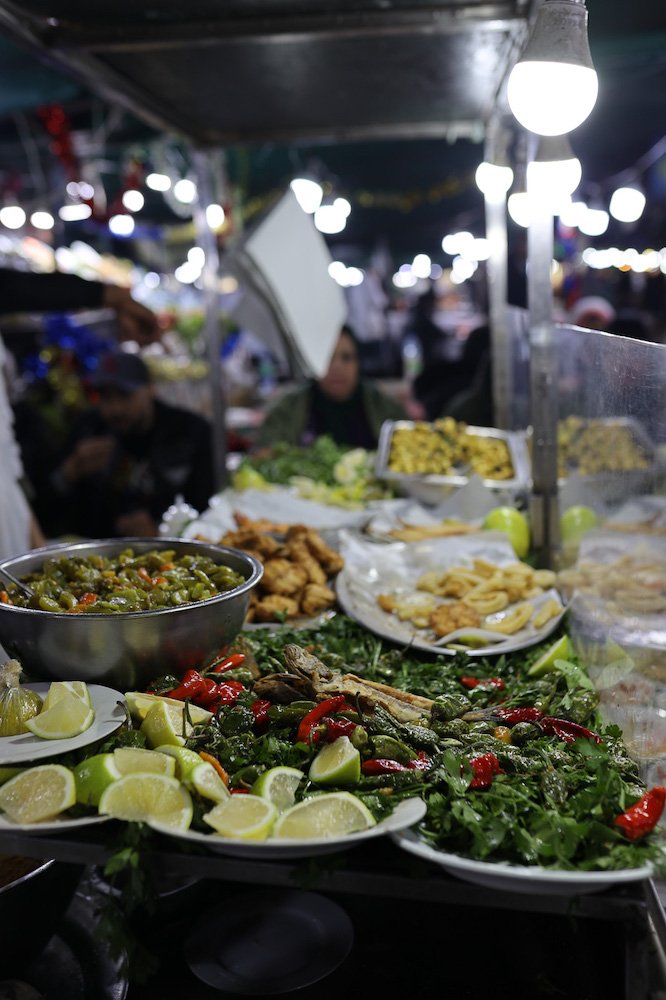
2. Try the Amazing Street Food! I Recommend a Street Food Tour in Marrakech
Moroccan street food is AMAZING and you can find a great variety of street food and fine dining in Marrakech. I think Morocco is my favorite food location so far out of everywhere I have traveled to! Going on a street food tour is the best way to try the most while minimizing harassment from the Touts and stall vendors – If you don’t have the time/budget for a whole street food tour I recommend trying the following shortlist:
- Tajine from Cafe Des Epices
- Couscous (but only on Fridays!)
- Calamari from stall #14 in Jemaa El Fna square
- Msemmen (Moroccan crepe)
- A mixed-meat sandwich from Chez Hicham
- Moroccan Escargot from any vendor in Jemaa El Fna Nightmarket
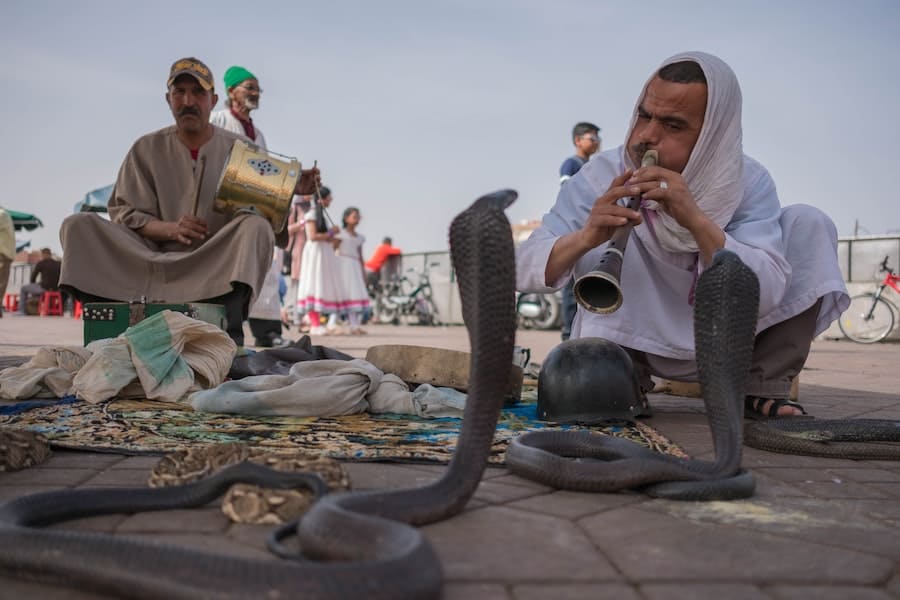
3. Ask Before You Take a Picture – It Might Be Illegal!
I was trying to record a little video of me disembarking the airplane when I landed in Casablanca and was totally shocked when one of the airplane stewards ran out and told me that it was illegal to film in public and I had to delete my footage!
I read into the laws in Morocco more after this and there are conflicting things online. Some sources state it’s only illegal to take photos and videos of police officers and other government officials, and some sources say it’s only illegal to record images of citizens if you intend to share them in a “defamatory way”.
It seems like the airline steward was incorrect and it’s not blanket illegal to take photos and videos in Morocco, but I was asking around after this incident and a lot of Moroccans think that is the law. So, if you’re running around taking photos and videos without asking, not only is it considered disrespectful but also illegal by a lot of Moroccan citizens. Make sure you ask first!
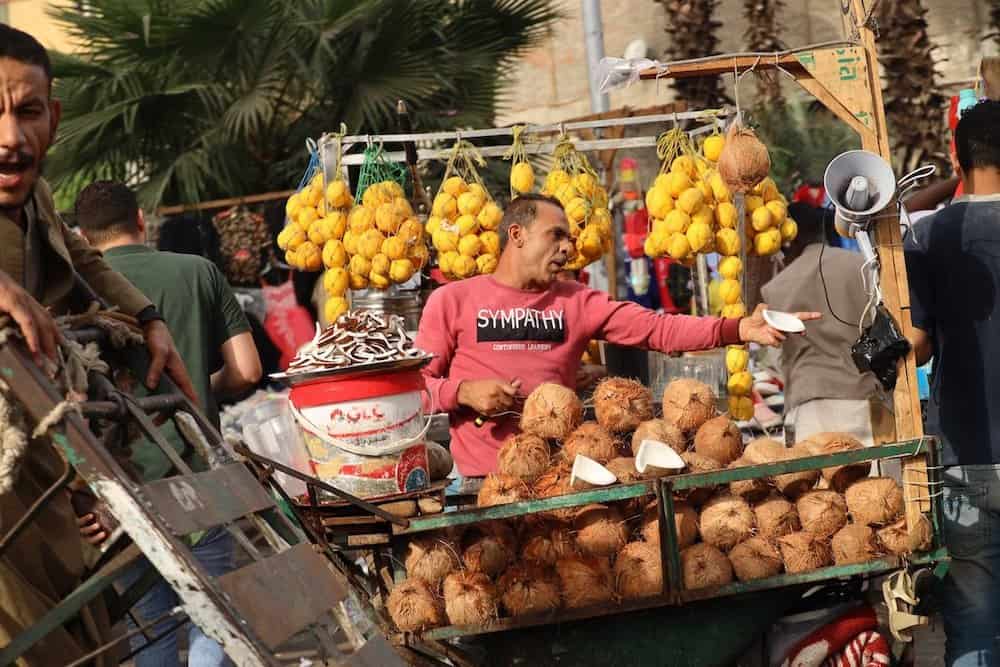
4. Be Prepared To Haggle (for Everything, Including Taxis)
I’ve been living out of a suitcase for the better part of a year now so I’ve gotten used to not being able to get souvenirs. But, if there’s one place I really felt like I was missing out on shopping, it would be Morocco. I’ve already promised myself that one day if I ever settle down I’m going to come back and buy everything for my home (yes, the shopping really is that good). It can also be a bargain IF you know how to haggle in Morocco .
I was with a friend in the souks who was about to go home and was filling up her suitcase first – she spotted some glittery kaftans and asked the shopkeeper how much, he said 500 Dirhams! ($50!). That is a LOT in Morocco but was even wilder was this place was clearly selling “Moroccan-themed items that looked like they had come straight from Shein.
After going back and forth with the shopkeeper she only got him down to 300 DH, or around $30, which was probably about 3X too much still. At the next stall, we stopped at I asked her to let me haggle for her – she was buying a little trinket and the shopkeeper wanted 150 DH, I said 50, he said he couldn’t do more than 125.
I said okay, thank you and walked away.
Then the shopkeeper came running after me saying “Okay, 50 for you my friend!”
That’s it. That’s the trick. That’s all you have to do.
I’ve seen people be ripped off in the souks paying 100x for what something is worth or wasting 45 minutes haggling away their vacation. The best way to haggle in Morocco is to just be very polite, say how much you’d like to pay for something – and if they say no, then move on.
All of the stores sell pretty much the same thing, and it’s the best way to get a rough estimate of how much things should cost. After you walk away, if they follow you and give it to you for the price you stated then you know you named a good price. If they let you go, then the price you named was too low, and you could either go back and agree to their price or just make a mental note going forward.
👉 Tip: The “correct” price in the souks is almost always at least less than half of the price originally named.
👉 Note: This is only for the markets, Restaurants usually will have prices posted/aren’t places for haggling.

5. Pack Light ! Many of the Streets in Morocco’s Old Towns Cannot Fit Cars
I’ve stayed in different cities and towns all over Morocco, and unless you’re staying at a large hotel it’s unlikely you’ll be able to drive up to the door of your lodging. A lot of streets in Morocco, especially in historical areas that get a lot of tourists, don’t have streets that were designed for cars.
For example, in Marrakech cars can only enter the windy streets of the old souks after sunset, and even then it’s unlikely you’ll be dropped off at the door of your Riad like in a modern city (these streets are older than cars, after all!). In the Old Medina of Fez, cars can’t enter at all, So be prepared to have to carry all your luggage to your destination by foot. If you’re staying in the old Medina in Marrakech (which I recommend, it’s a truly unique experience) you’ll likely be dropped off in Jemaa el Fna square and have to walk the rest of the way.
If you have more than you can personally carry you’ll be at the mercy of the Touts. The Touts are pretty much anyone off the street in the Old Medina who tries to “help” tourists and then demands a big fee at the end, and no matter what you give them they’ll make a stink that it wasn’t enough. It’s not the end of the world, but to ensure you have a good time visiting the city either pack no more than you can personally carry or arrange a pickup with your Riad/hotel.

6. Don’t Interact With Touts On The Street – AKA the People Asking “Where are You Going?”
What is a Tout? A Tout is an illegal guide common in a lot of touristy places but especially common in Morocco and Egypt. They’ll “help” you (sometimes not) and then demand a fee for their service. Often they approach tourists who don’t need help and guilt them into accepting their services.
The Touts really are the most unfortunate part of Morocco. I just put my headphones in, and sunglasses on, and walk when I’m in a city like Marrakech or Fez. Looking straight ahead. Not making eye contact with anyone.
It’s the only way to keep from getting roped in a 20-minute struggle with someone demanding money for no reason, and then chasing you down the street saying “F you woman!” (yes. that actually happened to me on my last trip). Why do I keep going back then? Because Morocco is amazing. The food is terrific, and the people are SO kind, but the Touts are a huge problem.

7. Don’t Hail A Taxi On The Street From The Airport – You’ll Most Likely Get Scammed
Unfortunately for travelers, Uber in Morocco hasn’t caught on yet – so you need to negotiate taxis off of the street. The taxis from the airport charge 10-100x as much as they should. Taxis are VERY inexpensive in Morocco ( a 10-minute ride is about $2 ) but the ones at the airport know you don’t have any other options. Either take a train (the trains in Morocco are fantastic) or bus to the city center and take a cab from there or arrange a pickup with your hotel.
If you really have to take a taxi in Morocco from a train station or airport I’ve also used a trick where I have my Riad host talk to the taxi driver over Whatsapp. They’ll do the bartering for you and you’re more likely to get the local price this way. Make sure to ask your host first if it’s okay with them, but most Moroccans I’ve met really want you to have a good time in their country so you should always be able to find someone to help.

8. Take Out Cash As Soon As You Can – Morocco is a “Cash is King” Country
Morocco is a “cash is king” country so taking out a chunk of change at the airport before you go anywhere will help you out in the long run. Just make sure to use an ATM connected with a bank, and also be sure to decline the conversion fee the ATM offers you. Usually, the ATMs in Morocco will charge 30-50 dirhams ($2-$5) per transaction and will ask you to approve this fee. After you hit “yes” a second screen will pop up asking you to accept their conversion.
If you read the fine print on this page, which not a lot of people do – a lot of people just hit “yes” instinctively, you’ll see they’re adding a 6-12% markup (!!!!). You don’t have to accept this, if you hit “no” on this page the transaction will go through, but you’ll get the better deal.

9. Stay In A Traditional Riad (It’s Cheaper Than a Hotel & a Cultural Experience)
A Riad is a traditional Moroccan bed and breakfast. It usually is a home with multiple stories centered around a courtyard, and most also have a rooftop terrace. Riads are unique to North Africa and are synonymous with a trip to Morocco. While Moroccan luxury tourism is world-renowned, Riads actually don’t have to be that expensive.
What really blew me away was that it was the same price per night to stay in a Riad as it was to stay in a hostel! For only around $30 a night I was able to stay in this gorgeous home with hand-carved doors and a courtyard garden, as well as have a huge homemade breakfast. Marrakech and Fez don’t have much of a hostel culture, so even if you’re on a budget I would recommend springing for at least one night in a Riad.

10. Help The Stray Cats & Dogs
One of the things I love about Moroccan culture is how wonderful everyone is towards animals. During my time in the Old Medina, I noticed there are a lot of cats and dogs around mosques, this is because all the locals pitch in to help care for them. I always walk around Marrakech with a few tins of cat food in my pocket just in case I see some hungry fur babies, and this is encouraged by the locals! So don’t feel like you’re feeding someone’s pet when you’re not supposed to be.
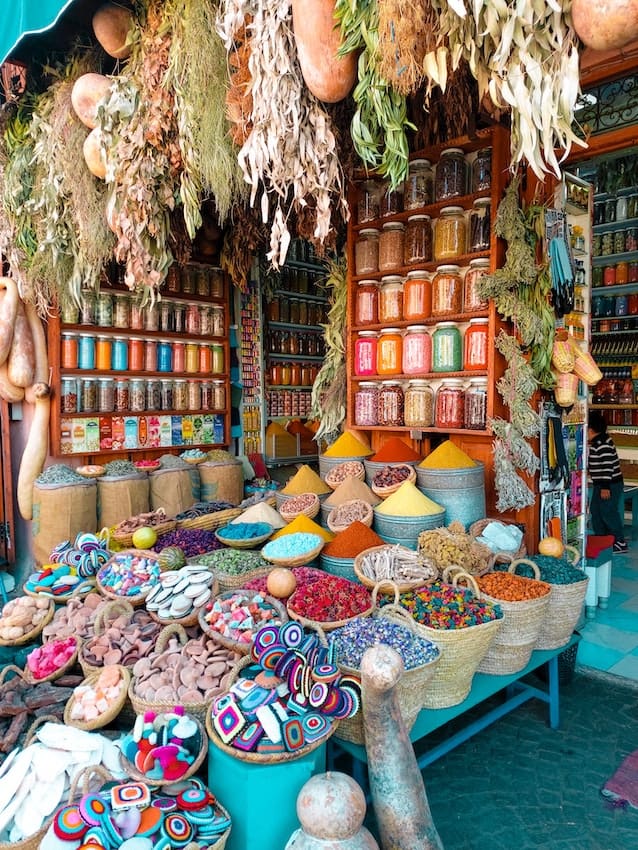
11. Don’t Shop With A Guide – You’re Not Going to Get a “Better Deal”
Sigh. Just don’t. I took a lot more organized tours in North Africa than I usually do because I was with my friends, and it always grinds my gears the wrong way when you pay for a private tour to a certain historical site (usually I only do this when something is hard to reach, or I legally have to have a guide) and they take you to various gift shops selling wayyyyy overpriced goods.
You’d think that if you’re paying a guide to help you do the haggling, you’d get a good deal but it’s almost always the opposite. Instead, your guide is taking you somewhere they’ll get a fat commission for everything you buy – all the while the guide is saying “That’s a great price!”.
If you like your guide, tip them! But don’t encourage this! Shopping alone and bartering, unless you’re going with a close friend, will almost always get you a better deal and help you get higher-quality stuff. There are a lot of tours of the Old Medina that are really just shopping trips – being with a guide will help you a lot with the harassment but if you want to purchase something I suggest coming back alone.

12. Brush Up On Your French! Morocco is a Bi-Lingual Country
Arabic, for a native English speaker (like me), is hard . I tried my hardest to learn a bit of Arabic in Egypt, and never really made it greetings. Luckily, in Morocco, they speak Arabic and French, and French is a lot easier to pick up a few phrases just to get around. In the bigger cities, where lots of tourists are, you’ll hear more French than Arabic in general, so unless you’re going to be visiting more rural parts I’d say you’re safe just brushing up on your bonjours.
Fun fact: I was talking to an anthropologist on a train in Casablanca who said there are over 100 different dialects spoken in Morocco by the indigenous Amazigh people, some of which haven’t even been written down yet!

13. Don’t Go On A “Tannery Tour” In Marrakech
In Fes, another popular city to the north of Marrakech, the tannery is a famous tourist attraction. This is not so in Marrakech. If you see someone advertising tours to the Marrakech tannery or trying to take you there unprompted, it’s a scam. What usually happens is they take you to the tannery and then demand payment for “guiding” you there, even if you didn’t ask them to.
The Tannery is in a secluded area and I’ve heard of tourists being pressured to give up more and more money once they’re there, so just don’t go! No real tour guides in Marrakech will offer to take you to the tannery.
14. Don’t Drink The Tap Water
You see more people drinking tea over water in Morocco and that’s in part due to the way boiling water cleans it for consumption. Even the locals that are used to the tap water sometimes get an upset stomach depending on the area. The first time I traveled to Morocco in 2019 I was schlepping 20-packs of water bottles through the streets, but to save my back (and the environment) now I always travel with my GRAYL bottle that cleans out any viruses or bacteria in water.
💧 Tip: Using my GRAYL bottle I was able to drink the tap water all over Morocco without any problems!

15. Do Download Google Maps Offline
The Old Medinas in Morocco are windy mazes of footpaths that it’s very easy to get lost in. Luckily, even if you don’t get a local sim card or have cellular service while you’re in Morocco, you can download the map of the souks offline on Google Maps and always know where you’re going!
I’ve used Google Maps on my past two trips to Morocco and while it misses some tinier alleys it’s been very reliable. Downloading a map of the medina offline is the best way to avoid touts trying to convince tourists they’re going the “wrong way” (and then demand money for bringing them the “right way” 🙄.

16. Don’t Believe A Street Is “Closed”
The Touts in Morocco can be Oscar-worthy actors at times. One time a tout started crying while telling us a street was closed when it was clearly a well-trafficked main road! A “wrong way/ street is closed” scam is basically when someone sees a tourist and asks them where they’re trying to go.
No matter what the tourist says, the answer is always the same: “oh no, you’re going the wrong way, here follow me”, and the scammer will proceed to lead the tourist to their shop/restaurant, or in more sinister cases somewhere secluded where other guys are hiding to rob them. In Morocco, Touts bypass the formality of asking “Where are you going” and just skip to telling every tourist they’re going the wrong way.
Walking down the lanes of the souk as an obvious tourist you’ll hear: ‘wrong way miss, wrong way please follow me” every 10 feet. It’s exhausting, especially if you’re not in on the secret and wind up being led in circles. Sometimes they’ll say “The main square is this way” to people walking in the souks. It doesn’t matter to them if you’re going to the main square or not.
Then you’ll respond “Oh, I’m not going to the main square” and then they’ll say “Oh where are you going? Where are you from?” and they’ve got you.
If you interact with any of the touts it’s super hard to get rid of them, but even knowing this it’s really hard for me to just ignore people who are trying to talk to me. It’s human instinct to respond! The biggest tip is to just ignore anyone who comes up to you on the street – but barring that, don’t believe anyone when they tell you you’re going the “wrong way”! Trust Google Maps over the touts.
17. Dress Appropriately (Both Men & Women)
While Morocco is safe for women travelers, remember it’s a conservative country where women are expected to cover up. A lot of women know that you should dress modestly in an Islamic country like Morocco, but did you know men should as well?
Nothing bad will happen to you if you show up to Marrakech with a suitcase full of mini skirts, but as a sign of respect it’s best to keep your shoulders and knees covered, this goes for women AND men. In the old Medina, you’ll notice a lot of men and women are completely covered – regardless of the temperature.
There is no legal dress code for tourists in Morocco, but to be respectful to the country you’re visiting for both genders to cover up. For women, I’ve heard shoulders and knees should at least be covered, and for men, if you’re going to wear shorts they should be longer than knee-length.
There will also be an expectation that women have their heads covered if they’re going to be entering a mosque, but not many mosques in Morocco are open for tourism. I’ve seen some tourists in the souks in skimpy clubbing outfits, and while it might increase the amount of harassment you receive, Morocco is pretty safe. Covering up is more of a sign of respect for the culture you’re visiting than anything else.

18. Visit the Crazy Jemaa el Fna In Marrakech
There’s nothing like Jemaa el Fna square in Marrakech! It’s crazy, noisy, and infinitely interesting. Jemaa el Fna is the only place I’ve seen where you could get a roasted sheep’s head, fresh juice, and a BIG bowl of Escargot for under $10 – all while watching a snake charmer! During daylight cars are allowed to transverse the square, it’s still a nice place to get some shopping done in the daytime but around 5 PM when the sun sets is when Jemaa el Fna really starts to come alive.
👉 Tip: Skip Cafe de France, which is a bit of a tourist trap, and visit its next-door neighbor Café de la Place. Not only is Café de la Place cheaper (20 DH ($2) for a tea, 80 DH ($8.50) 3-course menu du jour), Café de la Place also has a better view of the Koutoubia Mosque. Go at sunset and climb the 4 flights of stairs to the patio at Cafe de la Place for the best view of Jemaa el Fna square!

19. Get Out Of The City (At Least Once)
A lot of people come to Morocco and book a week-long stay in one of the cities like Marrakech, Fez, Casablanca, or Agadir. The cities and the historic Old Medinas are amazing – but they’re definitely not the best thing to do in Morocco. Going into the countryside in Morocco you’ll meet the indigenous Berber (also called Imazighen) people; everyone is always exceptionally kind, and the nature is gorgeous.
On my first trip to Morocco, I fled to Imlil, a village in the High Atlas Mountains, after Marrakech became overwhelming, and on my second trip, I got to visit the hippy chill beach town of Taghazout. Morocco truly is such a diverse country in terms of climate and activities, there’s something for most types of travelers. If you’re coming to Morocco for more than three days you should take at least one day trip outside of the cities into the countryside.

20. Don’t Stay In One Place The Whole Time!
It’s best to see Morocco by hopping from one place to another. If you spend a whole week in Marrakech, Fez, or Tangier, you will probably get a bit bored. I love planning my own itineraries and traveling without a tour. However, in Morocco, the public transportation system isn’t the best. Also, most of the popular tourist attractions don’t even have public transit options available!
If you’re spending 2 weeks or less in Morocco I highly recommend taking a guided multi-day tour to save on stress and get the most out of your trip. Bonus, a lot of the time multi-day guided tours in Morocco are cheaper than if you were to plan all the activities separately! This is because transportation, which is the biggest expense, is already included.

21. Learn How To Eat With Bread Instead of Forks Like The Locals
Bread is a way of life in Morocco (to this day it’s the most amazing bread I’ve ever had). Meals like Tajines are usually eaten not with utensils but with a small piece of bread in the right hand (never the left!) used as a “scooper” for all the good stuff. This takes some getting used to, but if you’re invited into someone’s home for a meal it’s the polite thing to do.
💡 Note: Meals in Morocco are usually eaten communally with everyone huddled around a big plate, using bread to dip into the main dish.

22. Know Mosques Aren’t Open for Tourism
Unlike other places I’ve visited, like Turkey and Rome, the places of worship in Morocco aren’t usually tourist attractions you can go inside of. There are some exclusions like the Hassan II Mosque in Casablanca, but by and large Mosques in Morocco are not open to non-worshippers. Tourists sometimes get confused because mosques are open to the public, so you’ll see people entering freely, but there are some horror stories of tourists wandering in and being quite embarrassed when they get escorted out: so unless otherwise specified just don’t enter a mosque in Morocco!
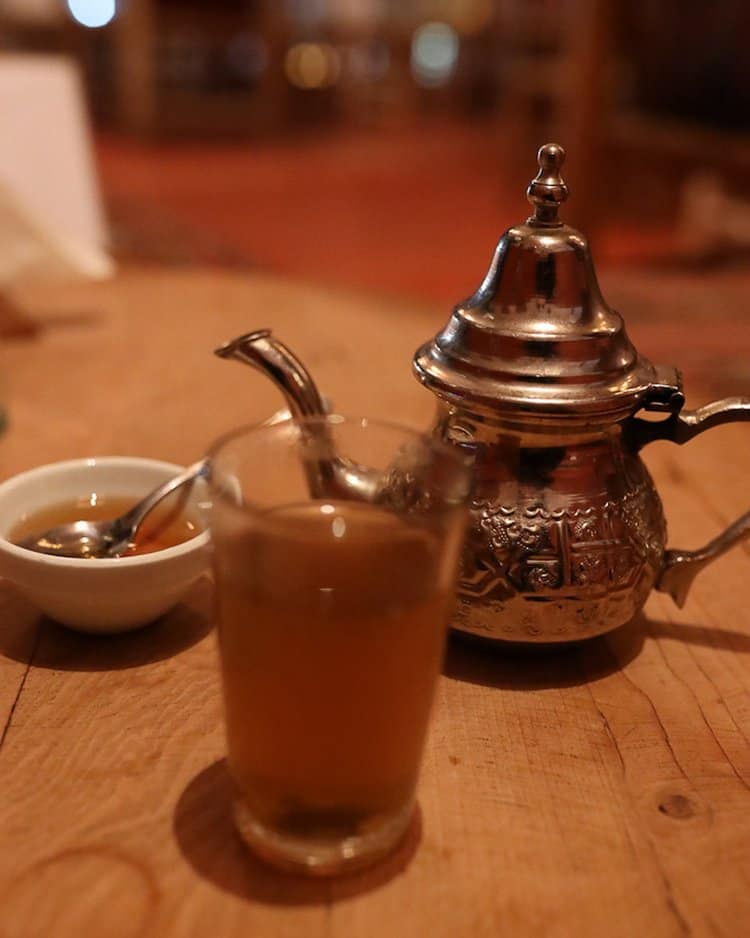
23. Get Ready for A Lot Of Mint tea! It’s Served With Every Meal
Mint tea is served with every meal in Morocco & Egypt, when I came back to the United States I felt weird without having it! There’s a special way Mint tea is served, and once you get it down you’ll impress all your Moroccan friends: First, dried mint and black tea leaves are soaked in hot water in a silver teapot. Then, a bunch of sugar is added to the pot, and the mixture is poured from up high (the rule is “4 fingers” height – I think that’s about 8 inches but the higher the more impressive it is).
And then you pour the tea from your cup back into the teapot and repeat this around 3 times. Apparently, this aerates the tea, and it makes the sugar frothy which is the desired quality (and also makes for a great show).

24. Be prepared To Wake Up Early For Prayer Call
In Islam call to prayer is done 5X a day, with the holy day being Friday. It usually only goes on for a few minutes, but on Fridays, the whole prayer service is broadcast depending on where you are. Even though I don’t know the language, I’ve always found the prayer calls to be very beautiful. Most restaurants, train stations, airports, etc will also have prayer rooms for people to meet the 5x a day quota if they so wish. There is no set time (from what I could tell) for the prayer calls – instead, they go at dawn, noon, mid-afternoon, sunset, and nightfall, and that changes throughout the year.
Tip: I never found the prayer calls to be so loud I couldn’t sleep through them, but I know some people do. If you’re a light sleeper I recommend bringing earbuds to Morocco since the earliest call is at sunrise.

25. Don’t Get Scammed!
Really! I LOVE Morocco but I hear of people getting scammed in the bigger cities like Marrakech and Fes all the time, and it just ruins their travel experience. I really only fell for a Tout once on my last trip, and I didn’t really fall I just didn’t have enough energy to tell him to leave me alone. I was trying to buy food for some cats and a tout on the street asked me what I was looking for.
I said I was going to buy food for the cats: “Mangia pour chat” (Which is half in Italian, not even French, but I was making eating hand motions to go along with it and he seemed to understand – gotta do what you gotta do!).
The guy saw where I was heading and pointed at the stall up the road I was already heading to, I said thanks and went on my way. It didn’t take long to realize he was following me there, and then once I got to the stall he spoke over me and was making a big show of ordering it for me, even though I didn’t need or ask him to.
For example, if The shopkeeper asked me how many items I wanted, I held up my fingers and said “cinq” (five in French) – and then the tout would make a big fuss of loudly asking me how many tins of cat food I wanted in English, and then translating that to French.
Again, without me asking him to.
In the end, he asked for payment. I said no. He didn’t actually help me do anything to deserve a payment.
Up until this moment, he was all nice and smiling, and then after this, he yelled “F**k you, fat woman!” In my face and then proceeded to yell it after me all the way back to my Riad!!!!
Don’t give money to these guys.
If you pay Touts you’re just supporting the practice, which hurts tourism in the area and gives foreigners a terrible idea of Morocco when really it’s a wonderful place full of amazing people.
Also, if you DO give the touts money, you’ll probably have the same result. Even if I had paid him we would have had the same argument, but this time it would have been over the amount. Just don’t pay these guys any mind.
If I were to be in that situation again I would have landed him a firm “La” (no in Arabic) and not accept any “assistance’ from him in the first place.
Katie Caf, founder of Katie Caf Travel, is a seasoned travel expert who has explored North, Central, and South America, Europe, Africa, and Asia for many years. Originally from New York, she shares travel insights from her experiences in the USA and around the world. Now residing in Bali, Katie specializes in Bali and Indonesia travel, aiming to assist her readers in traveling better and more frequently. Through her blog, she provides quality travel resources and firsthand accounts.
Leave a Reply Cancel reply
Your email address will not be published. Required fields are marked *
Save my name, email, and website in this browser for the next time I comment.

How to Avoid Tourist Traps on Your Travels
A guide on how to truly immerse yourself in a new place..
- Copy Link copied

Tourist traps are everywhere tourists can be found, and they can ensnare us all. But what exactly is a tourist trap?
Illustration by Melanie Lambrick
Like many of you, I’ve been caught in the occasional “tourist trap” over the years. I’ve found myself waking up in a cookie-cutter hotel room, with a generic print of a local landmark over the bed, or on a street full of gift shops selling puntastic T-shirts. Then I ask myself, “How did I get here? Aren’t I a better traveler than this?”
Tourist traps are everywhere tourists can be found, and they can ensnare us all. But what exactly is a tourist trap? And how should we think about them?
What constitutes a tourist trap?
A tourist trap is, by definition, a place that attracts and exploits tourists. But Merriam-Webster doesn’t leave much room for nuance. After all, one person’s trap is another person’s treasure.
A tourist trap is often cast as the opposite of an “authentic” experience. It’s somewhere we skip if we’re looking for the “soul” of a destination. But what makes, say, visiting a hidden supper club in Hackney more true to London than watching the Changing of the Guard at Buckingham Palace? Who’s to say what is truly “authentic,” anyway?
There’s also a distinction between a tourist hot spot and a tourist trap. Many hot spots—for example, the Eiffel Tower—are marvels of engineering, nature, or culture that are kept standing, alive, or protected for visitors. The trinket stalls that surround them, however, err on the side of traps.
Instead of asking how to avoid tourist traps, perhaps a better question is: How can travelers more deeply immerse themselves in a new city—to experience both its beloved landmarks and the places less familiar to the average visitor?
Seek out local experts
“Avoiding ‘inauthentic’ experiences requires research and advance planning,” says Lindsey Tramuta , a Paris-based writer who offers small group tours of the city. “However, it can be as simple as scoping out who the local, trustworthy voices are.”
She recommends reading the work of writers who live in the city you’re visiting, as well as following chefs or restaurant owners on social media.
Tune in to the local frequencies
Mary Rickard, a semi-retired journalist who leads walking tours of New Orleans through Context Travel , suggests tuning in to the local radio station and reading the newspapers to get primed before your trip. You’ll also find out about concerts, art exhibitions, and other community events.
In New Orleans, for example, musicians are often guests on WWOZ radio shows leading up to performances. Attend a gig and you might strike up a conversation that teaches you something new about the city and the people who live there.
Step away from the tour bus
Coach tours can play a valuable role in facilitating travel if you’re unable or unwilling to make your own way in unfamiliar territory. But renting a car, Rickard says, can offer “a more leisurely experience of less-visited sites and roadside restaurants.”
The same is true for other, more independent, forms of transportation—like walking, cycling, and taking public transit. If I’d done that in Marrakech a few years back, I’d have spent less time in my taxi driver’s cousin’s perfume shop.
Seek out new neighborhoods
A city’s heart may be found among its lesser known arteries. Joan Roca, CEO and founder of Essentialist , a private members’ service for travelers, recommends doing a little research in advance—but also, when you feel safe to do so, letting yourself go with the flow in the present.
“Take that map out, and make note of where the big attractions are and what is familiar to you,” he says. “Then look to the other spaces on the map. Perhaps it’s a green space . . . perhaps it’s a maze of streets away from the well-known areas that’s caught your eye.”
Consider when you travel
Meaningful interactions can be had at quieter times of day and year, as a dawn visit to St. Peter’s Basilica in Vatican City with an infant once taught me. “Traveling in the low season,” Roca says, “will help avoid both tourists and traps alike.”

Marrakech: 10 things you need to know before visiting Morocco’s Pink City
After spending a lovely time in Essaouira – did I already mention how relaxing this place is? – we took the bus to Marrakech. This was our last stop in Morocco and we felt that it was a nice combination with relaxed Essaouira. We spent two days in the pink city of Morocco, by far not enough time to see everything there is to see. So, I am not going to tell you about the best things to do in Marrakech. My stay was just too short for that. Instead, I focus on my impressions of this city. What struck me, what surprised me and what were the things I did not like. Here are 10 useful & fun things to know before visiting Marrakech.
1. An Artistic welcome awaits at the bus station
Let’s start with something light. Marrakech has street art! One of the best murals can be found in front of the train station in Marrakech. A life-size black and white portrait of an Aziz trader against an orange background, painted by the German artist Hendrik Beikirch. His work is part of a series of wall paintings under the name ‘Tracing Morocco’. Beikirch immortalized the faces of the Moroccan men and women he met during his stay in the country. The artist has not only worked in Morocco, you can find his ‘faces’ all around the world. Also in the Netherlands, I have seen his work in Goes .
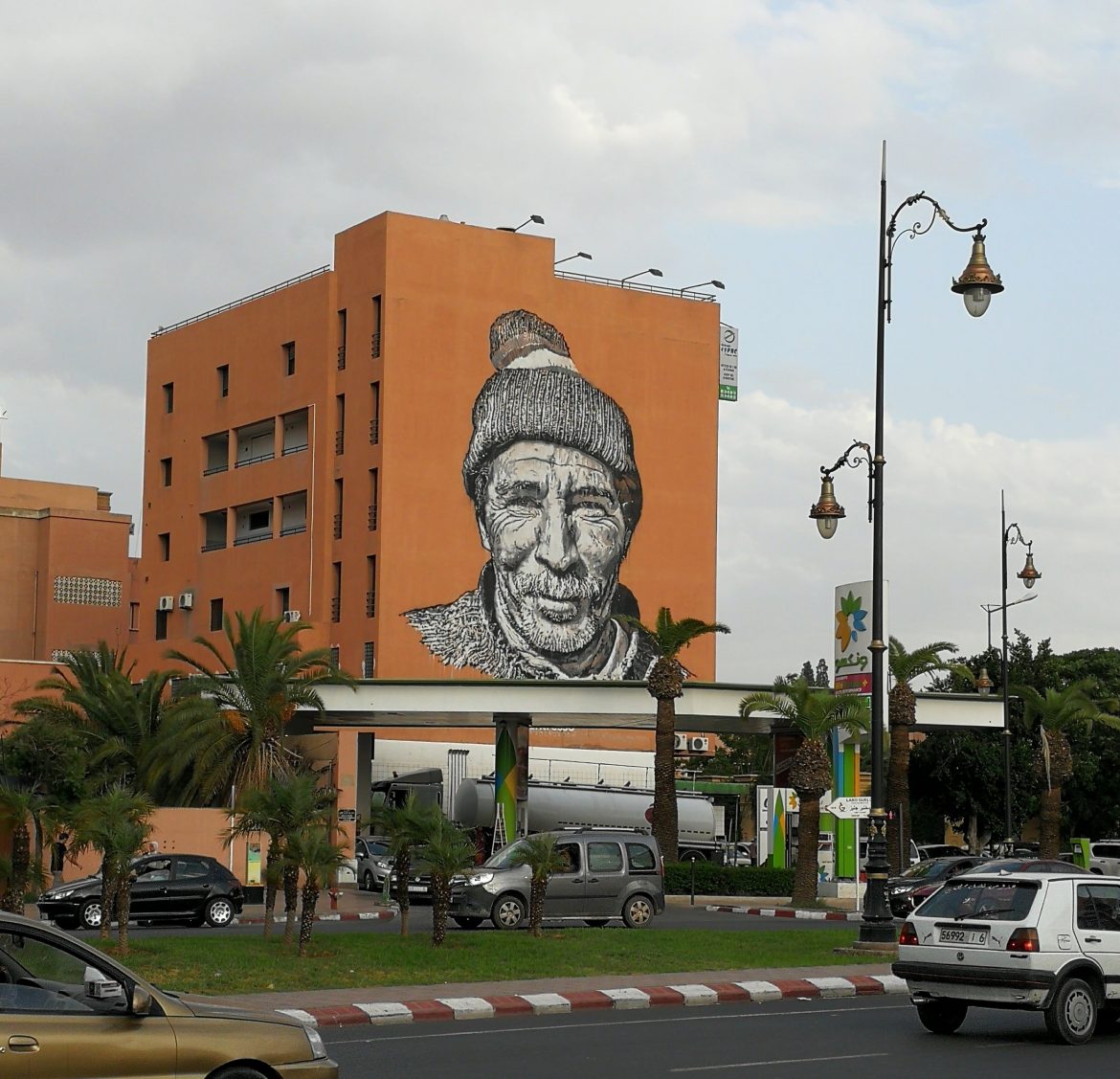
2. Parlez-vous français ?
I do not speak French and that is a huge disadvantage in Morocco. Apart from Darija (Moroccan Arabic) French is a popular language. It is almost expected that every tourist is able to speak this language. A lot of people hardly speak any English. Basic knowledge of French can definitely help with ordering dishes in restaurants or shopping in the souk.
3. Jemaa el-Fna is horror for animal lovers
Maybe this sounds a bit harsh, but there is no other way to put it. This square annex market square is a weird combination of innocent juice sellers and shameless animal entertainment. There seems to be no limit to what you can do with animals. Monkeys on a chain, a dozen snakes on picknick blanket, horse carriages lined up too close behind each other to fit more carriages in. All with the purpose to entertain tourists, but at the expense of animals. After five minutes looking around, I decided to get the hell out of there. I did not want to be part of this tourist trap.

4. Avoid taking photos of locals
Taking photos in Marrakech can be challenging. Locals often do not want to be in your photo at all. They will protest or, even worse, ask for money for the picture (I did not experience this myself, but I’ve heard about it). I like taking photos of street scenes, alleys, and historical buildings. But that is hard if you have to avoid snapping locals in your photos. This means that you have to wait, and wait even more, for the perfect moment. I actually have never been to a country where taking a normal photo was so challenging. As soon as someone thinks that he or she is in your picture, they will cover their face, wave, and start shouting ‘No!’.

5. Expect queues in Marrakech
Maybe I was spoiled by Essaouira, but what struck me the most in Marrakech were the large groups of tourists. And of course, all those tourists want to go to the same sights, so we spent a lot of time standing in queues. Queued up to buy tickets, queued up inside to actually see the sight. During our stay, we visited the Majorelle Garden and the Saadian Tombe. Both beautiful sights, but filled with tourists. At the Garden, I even saw garden staff offering their service to take photos, from a spot no one was allowed to go to.
I get that more and more people are traveling and I am also one of those tourists, but for me it ruined the experience a bit. Then again, we were there at the end of peak season (September), so maybe when you visit it in winter or spring it is better.

6. Advice for the ladies: dress appropriately
Marrakech is a popular destination, but sometimes it feels like tourists forget in which country they are. Morocco is a predominantly Islamic country. This means that people dress conservatively: covered shoulders and legs. Ladies, you can leave your short pants and tank tops at home. Instead bring thin shawls and long pants with you. As a tourist you already attract a lot of attention, don’t stand out in a negative way.
7. the Medina of Marrakech is a mental challenge
Dusty roads, narrow city gates, a continuous stream of scooters and a lack of sidewalks or evening lightning. The medina of Marrakech sometimes reminded me of India. Busy, chaotic and a bit overwhelming, but without the cows. In the medina you always have to be alert and pay attention to everything around you. If you don’t, you risk getting hit by a scooter. It does not help that the medina, and especially the souks, feels like a maze. Luckily, offline navigation apps like Here Maps or Maps.me offer some relieve. The downfall: you spend more time looking at your phone instead of monitoring everything around you. My boyfriend almost walked into a snake charmer when he was looking on his phone.

8. Unsolicited friendly advice (scams)
The most unpleasant side of Marrakech: the young Moroccans offering ‘free friendly advice’. It is not friendly and not free. It is a tourist trap and it goes like this. Young guys approach tourists to help them to find the sight they are looking for. They will say: ‘I am not a guide, I don’t want to sell you something. I want to help you’. But they do not want to help you, they want money. They will take detours to lead you to the sight and then they demand money. If you don’t give money or you refuse their help, they will get angry or pushy. And this is not the only one, these are the other tourist traps that we have experienced:
- The road is shut: young Moroccans tell tourists that the road they want to take is shut, but they know an alternative. The idea is that they will guide you and then demand money for the service.
- Practicing English: someone approaches you in a friendly way and tells you that he wants to practice his English. After a short chit-chat, he takes you a mini private tour around the medina and drops you off at a shop. Here you will receive tea and the owner will show the best products. The idea is that tourists buy something and the ‘guide’ will get a commission.
Simple solution for all this: use the offline navigation apps on your phone, say ‘no, thank you’ to the boys and keep on walking. They will get angry and start shouting, because they don’t accept no, but at a certain point they will walk away.
9. The Medina rewards the ones who power through
Once you get more and more used to the chaos, you will start to see the beauty of Marrakech. The medina actually does have a beautiful side. For instance, the beautiful red-orange colored streets with fairytale-like doors. Or the typical green, yellow and blue floral tiles that you see at every sight, no matter if you visit the Ali Ben Youssef Madrasa (temporarily closed) or the Saadian Tombs. And don’t the forget the amazing wood carvings on the bows that reminded me of the Alhambra in Spain. Marrakech is truly charming.
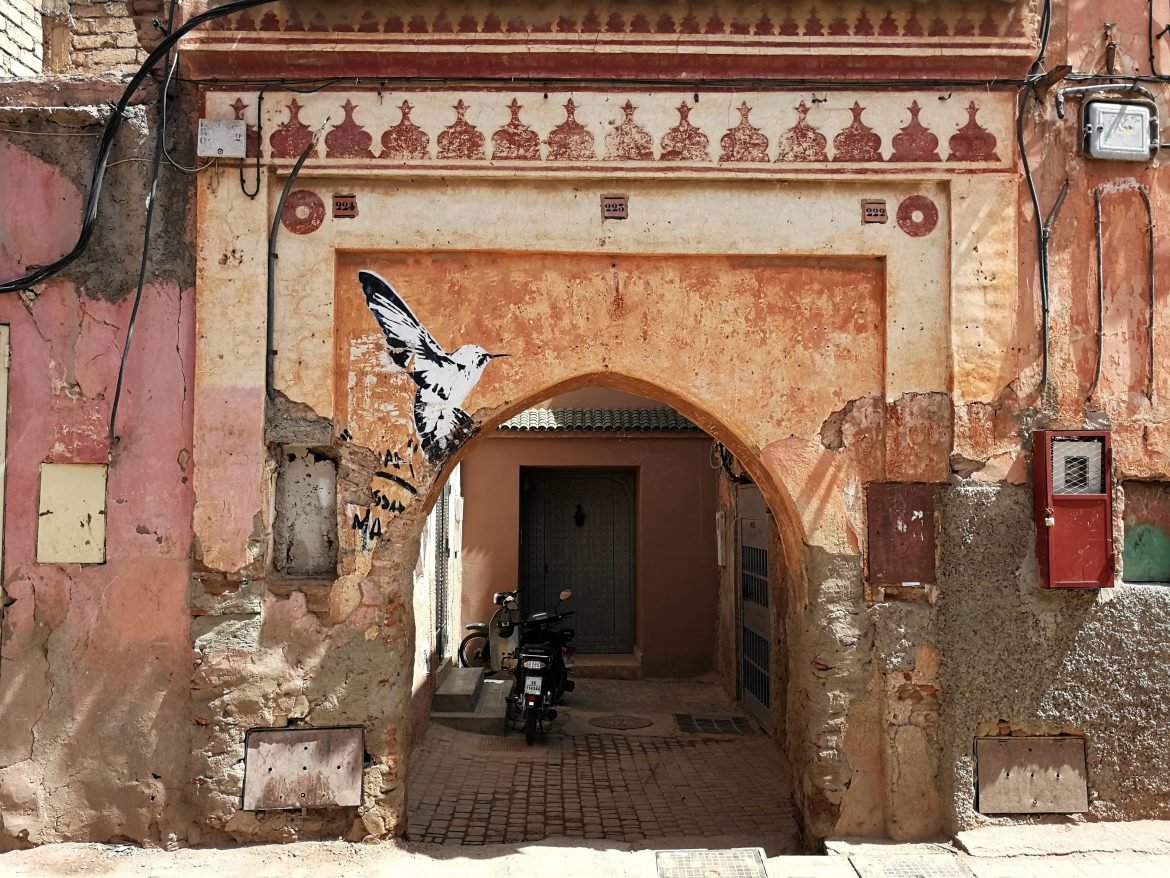
10. Give yourself a break and recharge at a Riad
Marrakech can be overwhelming for your senses. Choosing the right accommodation is crucial. A place where you can leave everything for what it is, take a step back, and relax. My advice: go for a riad. This is a traditional house built around a closed-off courtyard. And that courtyard makes the riad an ideal accommodation, because you can still be outside in the medina but without the hustle and bustle of the streets. A perfect spot to recharge, read a book, or drink endless cups of mint tea. We stayed at Riad Villa Almeria and I can highly recommend it.
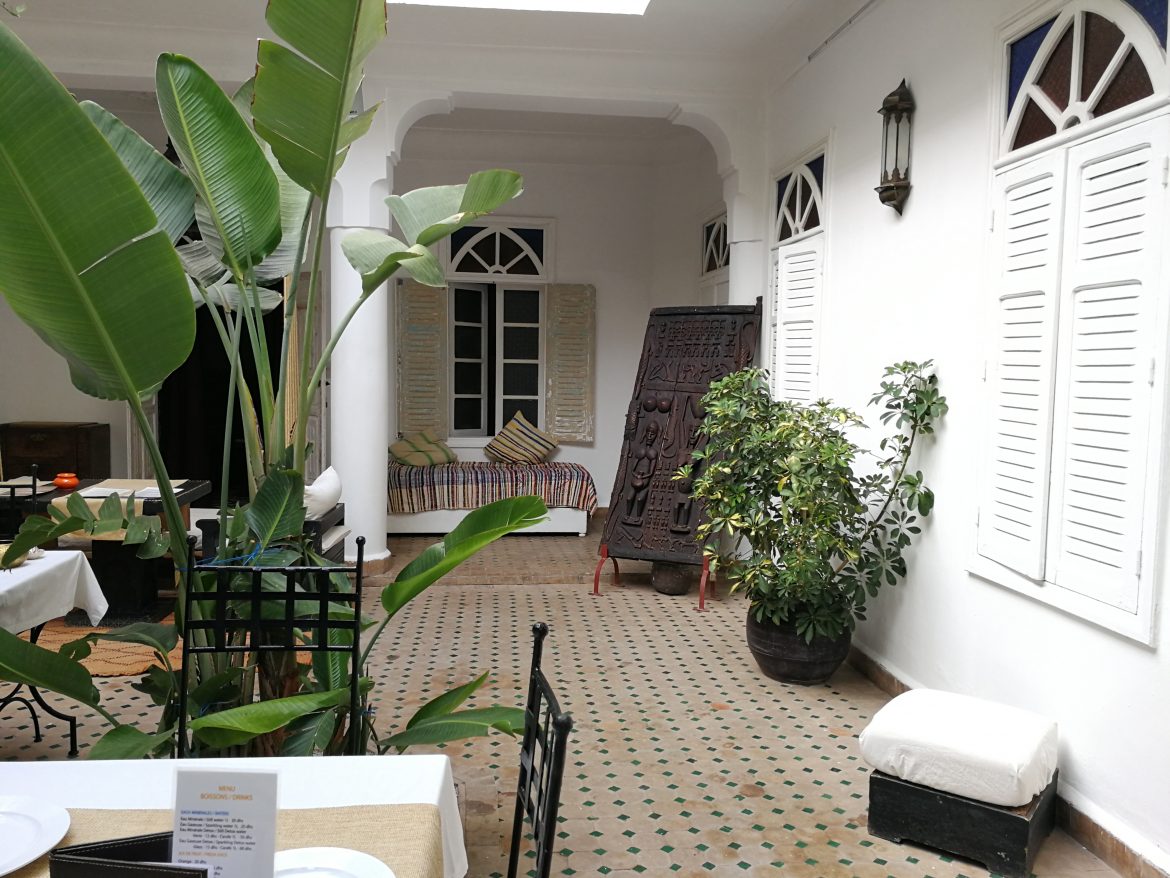
Do you want to go to Marrakech?
This post contains affiliate links. If you click on the link and make a purchase I get a small commission to help me keep this blog running. For more information click here .
"Don't let your dreams be dreams. Go live your dreams. Go travel".

Morocco: vegetarian & vegan guide for Essaouira and Marrakech

Comuna 13: how street art transformed this Medellín district
Related posts, essaouira: 10 things to do in the most relaxed city of morocco, write a comment cancel reply.
Save my name, email, and website in this browser for the next time I comment.
This site uses Akismet to reduce spam. Learn how your comment data is processed .
- Bosnia and Herzegovina
- Great Britain
- Netherlands
- United States
- Privacy policy

Budget Travel With Gabby
Travel tips, budget travel guides, volunteering stories, more!

13 Best Things To Do In Marrakech, Morocco
The best things to do in Marrakech Morocco for budget travelers.
Very few travelers visit Morocco without stopping in Marrakech.
Although it’s not the capital (Rabat is), it’s the most popular city for tourists to visit.
Marrakech lies in the center of the country, so it’s a great place to base yourself for outward tours to the Sahara Desert, the Atlas Mountains, and coastal towns like Essaouira , Agadir, and Taghazout.
Read next: How To Visit The Atlas Mountains on a Budget
I’m not going to sugar-coat it; Marrakech can be hectic .
It’s loud, dirty, and sometimes smelly. The locals are always yelling at you to buy their things. Walking through the city is never easy due to the crazy traffic (of people, cars, and motorbikes).
But this is all part of the experience, and you just have to embrace the chaos.
Though some areas of the city scream “tourist trap”, you can still find some of the core aspects of Moroccan culture here.
I’ve compiled a list of some of the best things to do in Marrakech. Some reveal the authentic Moroccan lifestyle and some celebrate the popular tourist attractions.
Visit Skyscanner to find the cheapest flights to Morocco!

The 13 Best Things To Do In Marrakech Morocco
From exploring the bustling Medina, to learning about the city’s history in museums, to admiring the Moroccan architecture, here are the best things to do in Marrakech.
How many days in Marrakech is enough?
3 days is enough in Marrakech if you want to see all the highlights. Most things to do in Marrakech are within walking distance of the city center.
If you want time for some day trips, maybe extend it to 5 days. Seeing the Sahara Desert and Atlas Mountains are must-dos in Morocco, so make sure you have time for those during your stay.
We spent about 3 weeks in Marrakech because we were living and volunteering in a hostel. This was a bit too long as we were over Marrakech by the end. But we had time for some amazing trips outside the city and we appreciated staying with locals who showed us their culture.
So no matter how much time you have in Marrakech, here are the 13 best things to do!
1. Buy fresh produce in a street market
You won’t find many big grocery stores in Morocco, as most locals buy their food at the street markets.
Whether it’s a truck bed piled high with melons and plums, a blanket on the ground covered in potatoes and zucchinis, or an actual shop with overflowing boxes of colorful fruits and veggies, there is no shortage of fresh produce in Marrakech.

Locals usually give you a basket to fill yourself, which they weigh and price accordingly. This makes shopping easier if you don’t speak French or Arabic, and the prices are usually so cheap as well.
You can also buy eggs, seafood, grains, bread, and spices in the street as well.
Be sure to try the peaches, nectarines, oranges, and figs , as they are exceptionally sweet here in Morocco.
Also try the strange-looking cactus fruit , which is green and prickly on the outside but tasted like a watermelon made love to a passionfruit on the inside.
My favorite street market in Marrakech is on the street called Derb Demnat , right behind Saadien’s Tombs. It’s a bit more chilled out here than other, more central areas of the city.

2. Visit Saadien’s Tombs
One of the best things to do in Marrakech is visit the tombs of the Saadien Dynasty, which ruled Morocco during the “Golden Age” of the 16th and 17th centuries.
The family tombs are preserved in a way that reflects their wealth and power.
The halls of Saadien’s Tombs are masterpieces of Moroccan architecture, with high domed ceilings, regal pillars, and intricate carvings.
Even the ceilings and floors are adorned with tiled artwork and beautiful designs. Beautifully landscaped gardens also surround the tombs.
- Address: Rue de La Kasbah, Marrakech Morocco
- Hours: 9 am to 5 pm
- Cost: 70 Dirhams
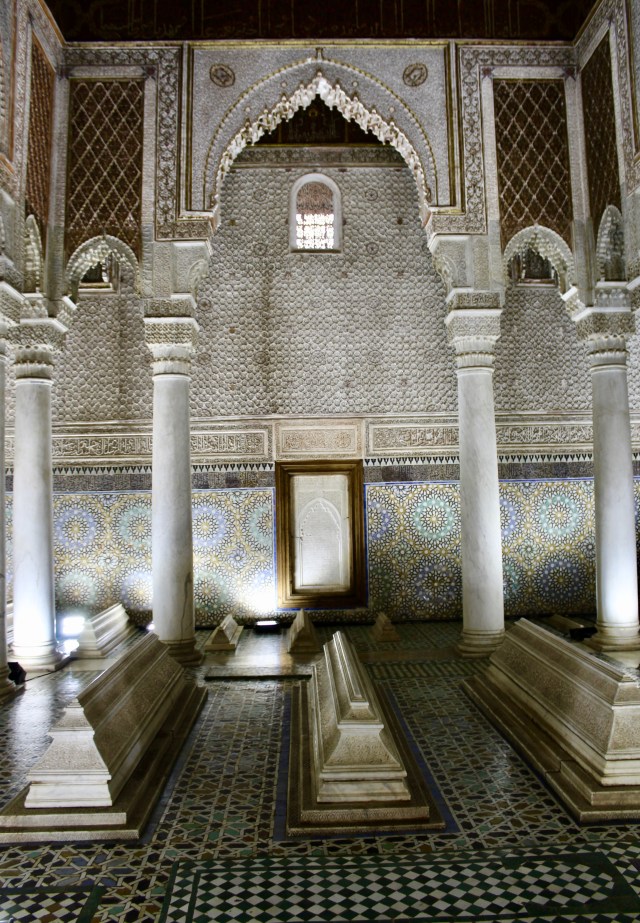
3. Sip mint tea
As the staple beverage of Morocco, mint tea is consumed at all hours of the day, either at home or in cafes and restaurants.
If you don’t want sugar, let the waiter know beforehand. Otherwise, they might shove 5 sugar cubes into your silver teapot.
But this tea is simply a handful of fresh mint leaves steeped in boiling water, and it’s delicious.
Indulging in plenty of fresh delicious mint tea is one of the best things to do in Marrakech Morocco!

4. Educate yourself in a natural medicine shop
You’ll definitely see lots of natural medicine shops in Marrakech. They often have baskets of fragrant herbs, colorful spices, wellness teas, and other unknown objects piled out front.
When we finally entered one and asked about the weird stuff on display, we were amazed by how interesting all the natural products are.
Common finds in a medicine shop include sandalwood for incense, argan oil for cosmetic and culinary uses, and black nigella seeds which can be sniffed for asthma and sinus relief.
Some of the stranger things I was introduced to include slimy olive soap that looks like brown goo but actually cleans your hands really well, and crystalized mint flakes that you can sprinkle in tea to help clear the sinuses.
Just one tiny flake of that mint and I had to close my eyes to drink the tea because the mint fumes were so strong.

5. Eat olives as often as possible
Morocco is home to the most delicious olives I’ve ever tasted. You’ll find them thrown into salads, tagines, and couscous dishes, or scattered on top of pizzas and omelettes.
Eat them at every opportunity, as you won’t find olives this flavorful anywhere else.
You can buy them at street markets in Marrakech for super cheap, only a couple Dirhams for a scoop.
There are lots of different flavors and sizes and colors, so try them all! Stop by a traditional spice souk as well to buy cheap spices and ingredients for cooking.

6. Stroll through Jardin Majorelle
Jardin Majorelle is one of the top Marrakech attractions.
Designed by French artist, Jacques Majorelle, in 1923, the garden has tall bamboo framing the walkway and lush plants, botanical gardens, and cacti scattered around. It is also home to a vibrant blue villa, designed by French architect, Paul Sinoir.
Jardin Majorelle is a beautiful spot, and it would be a tranquil oasis without the crowds.
I didn’t realize how Instagram-famous this garden was until I witnessed about twenty different tourists posing for photos in the span of five minutes.
I recommend visiting early in the morning to beat the crowds. But at any time of day, the Moroccan architecture and vibrant blue buildings are cool to look at.
- Address: Rue Yves St Laurent, Marrakech Morocco
- Hours: 8 am to 6:30 pm

7. Shop in the Medina
Marrakech has the second oldest Medina in Morocco ( Fes has the oldest ).
Visit this historic area of the city and get lost wandering through the narrow alleyways.
You will definitely get lost. Just enjoy the sensory roller coaster while walking through the maze and you’ll eventually wander out by accident.
The Marrakech Medina is full of food stalls, Moroccan arts, and more. It’s also a great place to buy souvenirs, including rugs, traditional clothing, ceramics, paintings, jewelry, and other handicrafts.
When you ask shop owners the price, assume you’re being told the tourist price , and try to bargain for a bit cheaper.
Just be respectful when haggling and shop owners will almost always lower the price.
Also, consider booking a guided Medina tour if you want a local to show you around!

8. Drink fresh juice in the street
You can’t walk two blocks in Marrakech without seeing a local selling fresh orange juice from a stand in the street.
Sipping on a cold orange juice is one of the best things to do in Marrakech, especially on a hot day of sightseeing. A glass usually costs 5-10 Dirhams .
I’ve also found ginger juice for 5 Dirhams , which is zingy and cleansing, and refreshing.
Just beware of the juice stands in the main square with fruits piled up so high that you can’t see them making the juice. Sometimes they dilute it with sugary bottled juice.

9. Visit a rooftop cafe
The phrase “panoramic view” or “rooftop terrace” is common to see plastered onto the front of a cafe or restaurant, especially near the Jemaa El Fnaa square .
These places tend to be quite touristy, but it’s nice to just order a mint tea or a coffee and enjoy the view.
I recommend visiting rooftop bars in the early morning or evening when the heat has subsided a bit. But sunset can be a very busy time near the square so you may need to wait for a table.
No matter what time you visit, this is one of the most popular things to do when you visit Marrakech.

10. Feast for super cheap in a local restaurant
Many restaurants in Marrakech charge tourist prices , meaning around 40-60 Dirhams or more for one meal.
This is still pretty cheap compared to other countries. But if you look hard enough you can get massive meals for much cheaper.
Look for the cafes that aren’t very flashy, are far from the main square, and have lots of locals drinking tea or coffee in the front.
We visited a cafe for breakfast and paid 39 Dirhams (almost $4 USD) for a massive breakfast including coffee, 2 omelettes, bread, Moroccan salad (chopped tomatoes, onions, olives, and seasonings), and a huge crepe with chocolate.
I wish I could remember the name, but there are plenty of local cafes with similar prices.
There is also a little pizza shop across from the Bubble Cafe (again I can’t remember the name) which sells a delicious margarita pizza for 10 Dirhams .
These hidden gems are super affordable and sell some of the best food in Marrakech.
Read next: 50 Budget Travel Tips

11. Brave the madness of Jemaa El Fnaa Square
The central square of Jemaa El Fnaa is one of the top Marrakech attractions, but it’s quite intense. (Also can be spelled Djemaa El Fna)
Street performers, snake charmers, and henna painters fill the grounds of Jemaa El Fnaa, begging for tourists to toss them money.
The crowds here are ideal for pickpocketing, so come with few belongings and watch them carefully.
You’ll also see lots of men carrying poor little monkeys on chains, usually wearing a silly outfit for tourists to take photos with.
I didn’t really like the commercialism, animal abuse, and tourist traps that lurk in the main square. But it was interesting to see this famous spot in Marrakech and wonder why so many tourists fall for the facade of true culture.

12. Book a Sahara Desert Tour
One of the best things to do in Marrakech Morocco is visit the Sahara Desert .
This mysterious and stunning spot on our planet is very accessible from Marrakech. So if you have 3 days to spare you should definitely book a tour to the Sahara Desert.
Drive through the Atlas Mountains on the way, enjoy camel rides, admire the rippling golden dunes, and camp under the stars.
Visiting the Sahara Desert is a must-have experience to have in Morocco. Most tours also pass by the ancient city of Ait Benhaddou , which is also a UNESCO World Heritage Site.

13. Take A Day Trip
There are plenty of wonderful day trips you can do to escape the craziness of Marrakech.
My favorite day trips from Marrakech are:
Essaouira: This gorgeous, relaxing beach town is the perfect easy day trip from Marrakech.
Atlas Mountains: This stunning area is a must-visit in Morocco. I would recommend visiting the Atlas Mountains for 2 days , but it is possible to do it as a day trip.
Ouzoud Waterfalls: Most day tours cost around 200-250 Dirhams (20-25 USD). They include round-trip minivan transfers to the falls.
There is no direct public transport to Ouzoud Waterfalls, so a tour is the easiest option for a day trip.
The journey is about 3 hours each way, and you get a few hours to swim and enjoy the magnificent waterfalls.
Book your day trip to Ouzoud waterfalls here.

Other Things To Do In Marrakech – Tourist Attractions:
Here are other popular Marrakech activities that I’ve been recommended but didn’t do myself:
Marrakech Museum of Photography
To escape the blazing sun, or the inclement weather, venture inside the Marrakech Museum of Photography to see Moroccan culture captured in photographs. The entry fee is 40 Dirhams, open from 9:30am – 7pm.
El Badi Palace
An old royal palace of the Saadien Dynasty, El Badi Palace is a great stop for people who love history and the cool ruins it leaves behind. The entry fee is 70 Dirhams, open from 9am until 5pm.
Ben Youssef Madrasa School
The Ben Youssef Madrasa Islamic school is full of gorgeous Moroccan architecture and has lots of cool sights and photo opportunities. It’s open from 9am – 6pm and costs 50 Dirhams to enter.
Bahia Palace
Bahia Palace is a gorgeous 19th Century palace in the city center. It is a popular stop while visiting Marrakech. The entry fee for Bahia Palace is 10 Dirhams and it’s open from 9 am until 4:45 pm .
Stay in a Traditional Riad
A Riad is a traditional Moroccan house , usually including a nice terrace, lush gardens, courtyards, and a pool.
They are supposed to be very beautifully designed and offer a classic Moroccan breakfast, but even the cheapest Riads are a bit out of our budget.
If you are willing to splurge a bit on nice accommodation, a traditional Riad can be incredible.
So those are the 13 best things to do in Marrakech Morocco! I hope this article was helpful!
Morocco is a stunning country in North Africa, and visiting Marrakech will give you an insight into the local culture, tasty Moroccan cuisine, and Moroccan arts.
From seeing iconic sights like Bahia Palace and Jardin de Majorelle, to a day trip visiting traditional Berber villages in the mountains or in the desert, the bustling city of Marrakech is unforgettable.
Before traveling to Marrakech Morocco…
- Visit iVisa.com to check visa requirements.
- Consider getting travel insurance. I recommend Squaremouth Insurance for the best, affordable travel insurance plans.
- Check Hostelworld for the best cheap accommodation all over Morocco!
For inspiration on where to go after Marrakech, check out my other Morocco articles:
Chefchaouen Photo Diary
Budget Travel Guide to Essaouira, Morocco
How To Visit The Sahara Desert From Marrakech, Morocco
How To See The Atlas Mountains On A Budget: Imlil, Morocco
Important Things To Know Before Traveling To Morocco
Is Fez, Morocco Safe? 10 Safety Tips To Know

This post may contain affiliate links. Read more about this in my About Me page!
Share this:

Leave a Reply Cancel reply
Discover more from budget travel with gabby.
Subscribe now to keep reading and get access to the full archive.
Type your email…
Continue reading
How to Avoid the Top 8 Moroccan Scams

Travelers looking for an adventurous and unique culturally immersive experience can find it in Morocco . Located in North Africa, Morocco offers gorgeous scenery, like red dirt roads winding through its desert landscape and bustling cities teeming with ornate hand-crafted goods and the aroma of fresh spices on every street. Travelers will encounter hospitable locals who are always happy to welcome visitors and share a cup of tea or coffee.
However, as with most places, there are some risks that travelers in Morocco should be aware of. These include the risk of being scammed by locals. In this post, we’ll tell you about some of the most common Moroccan scams and how to avoid them. Keep these tips in mind when taking a trip to Morocco , and you’ll have a safe and enjoyable time!
Moroccan scam #1: The Direction Giver

When visiting Morocco, especially Marrakesh, you may encounter locals who are insistent on giving you directions. Once they’ve guided you to your destination (whether or not you agree to let them do so), they may demand sums of money from you that weren’t agreed upon. This scam often happens in Marrakesh — one of the most popular tourist destinations in Morocco. Within Marrakesh, there is a place called The Medina. It is a large market, a UNESCO World Heritage site, and considered the old part of the city. It can be hard to navigate The Medina because Google Maps do not work very well within its walls and there are very few street signs. If you’re like me and have trouble with directions, it can become a stressful situation.
Here’s how the scam works: The Marrakesh Medina is full of scammers who are looking for lost tourists. When they see someone who looks like a tourist, they’ll often approach them and ask if they need help finding something. If the tourist says yes, the scammer will walk with them to their destination and then demand money – sometimes requesting every bit of cash in their wallet. Even if the tourist doesn’t engage or request any help, they may still walk with them until reaching the destination and then claim that they helped guide them there. Moroccan scammers can be very persistent and like to put their targets in difficult situations.
Here are some tips on what to do when you encounter the “Direction Giver” scam:
- Never go with someone who asks if they can direct you. If they ask, it is more likely that they will scam you.
- If you let someone who lives in the area show you around, always be sure to negotiate the rate of pay before walking with them. 20 Dirhams ($0.25USD) is a good amount of money to offer for a short walking trip within the Medina.
- If you are lost, go into a store and ask the shop owner for help. Shop owners can’t leave their store, which lowers the risk of them being able to scam you.
- If someone asks you for more money than you want to give them, be strong and say no. They may be persistent and continue to ask for more money – ignore this and confidently walk away.
Moroccan scam #2: The Henna Lady

When I was in Marrakesh with my friend Jon, we were walking around The Medina at night when a woman who drew henna approached us. She asked if we wanted some, and we said no. Even though we said no, she grabbed our arms and hastily drew henna on us. The designs looked like slop. When she was finished, she demanded money from us. We said no and walked away. The lady followed us for about 30 minutes, requesting that we pay. We eventually caved and gave her the equivalent of $20 so that she would leave us alone. In hindsight, we should have given her less money or none at all, but we weren’t thinking clearly when it happened.
Here’s how to handle the Henna Lady Scam if it Happens to You:
- Real talk: there’s not much that you can do to prepare for this. We researched Moroccan scams in advance and were aware that this could happen and it still hit us like a lightning bolt. The first step is knowing that it can happen.
- If you are targeted, then stay strong. The henna lady is harmless; she will persist but she won’t hurt you. Walk away from her and eventually, she will leave you alone.
- If you cave in and pay, be sure to hide all extra money out of the Moroccan lady’s sight. As with the other scams in Morocco, she will demand all that she sees.
Moroccan scam #3: Carpet Shops & Tea

There are many carpet shops in Morocco. When you walk through the market, the shop owners will invite you in and offer you tea. While you’re drinking their tea, they’ll take out their carpets and show you a bunch. If you don’t want a carpet, they will persistently ask why. And, if you decide to buy one of their carpets, be prepared for them to offer it to you for more than it is worth. Also, be mindful of the fact that you’ll always have to pay for your tea; in Morocco, very little is free-even if you’re led to believe that it is.
Here’s how to handle your experience in a Moroccan Carpet Shop:
- If you drink a shop owner’s tea, the culturally correct thing to do would be to pay them. 5 Dirhams ($1USD) is an acceptable amount of money to give per cup.
- If someone tries to sell you a Moroccan carpet, and you don’t want one, confidently say no, thank them for their time, and leave.
- When you go to buy a carpet, know the market value of the item. Carpet sellers in Morocco typically price their carpets at up to 75% more than what they expect to sell them for. This is especially true in carpet stores. So always try to negotiate and go lower than you think is possible. You won’t offend them—negotiation is a part of their culture.
Moroccan scam #4: The Fake Beggar

As is the case in many other countries, some people will pretend to be poor or suffering from an ailment in order to make money. Sometimes, children will come up to you to ask for money and their parents will hover nearby to ask for more after you donate. This happened to us numerous times throughout our trip and it’s a heartbreaking situation to witness.
Here’s how to handle this scam:
- You must say no and walk away from all beggars. It’s very likely that they are faking it for money.
- Do not ever give money to a begging child in Morocco—their parents usually hover nearby and when you pay, they will come to you and demand more money.
Moroccan scam #5: The Photo Opp

People often try to scam other people by asking for money after taking pictures. This usually happens with pictures that look like they are staged, like pictures with snake charmers, magicians, and camels. Be careful if someone asks you to take a picture like this. They might ask for all of the money that they see in your possession once you’re done taking a photo.
- The best way to avoid this scam is to not take staged photos.
- If you want one of these pictures, then negotiate the pay before taking the photo.
- You should not let people see how much money you have in your wallet when you are paying for a picture. If they know how much money you have, they will ask for more.
Moroccan scam #6: The Tannery Trap

Leather in Morocco is some of the best in the world, and one of the most popular things that tourists do in Morocco is visit a tannery. There are some legitimate Moroccan tanneries, but there are also some tourist traps set up—especially in Marrakech tanneries. There are two ways tourists can end up at a tannery against their will. A local can offer them directions that take them to a tannery, or the tourist might stumble upon a scam tannery. Once at the scam tannery, the scammers will ask for money in order to let the tourist leave. If the tourist doesn’t pay, they won’t be allowed to leave. This becomes a no-win situation for the tourist and they usually end up having to pay a lot of money for a tour of a mediocre tannery.
- There are some great tanneries in Morocco, but it can be hard to know which ones are real and which ones are scams. To minimize your chances of being scammed, go with a trusted tour guide, and never walk into one alone.
- If you find yourself in the middle of a tannery scam, then pay the scammers as little money as possible and leave. A negotiation tip is to always lead with paying them less than what you want. For example: if you want to pay a maximum of 20 Dirhams, start by giving them 5 Dirhams and then slowly increase the amount until you reach 20 Dirhams (the final payment). They will think that they have “won” in this situation—but really, you’re the winner.
- One golden rule to remember is to never keep more money where people can see it. This makes you a target for scammers, who will want to take all your money. Always hide large sums of money in places that are not visible to thieves.
Moroccan scam #7: Restaurants with Hidden Prices

Some Moroccan restaurants add hidden costs to your final check. This can include items like food you were told were complimentary or things you didn’t eat.
Here’s how to handle this scam:
- Always look at your check before you pay it.
- If a waiter offers something for free, just say no, unless you’re okay with paying for it.
- If you find a charge on your bill that is not correct, tell your waiter. They will likely remove the charge for you when asked.
Moroccan scam #8: Fake Fossils & Minerals

Morocco is known for having authentic fossils and minerals for sale. However, a lot of the products sold in the souks are fake. Sometimes, tourists will pay a high cost for something that isn’t real.
- Make sure you know how to identify a real fossil or gemstone before you purchase one.
- Before purchasing a gemstone or fossil, do the research to find out what the market value is. This includes researching online, asking locals, and looking at the cost of similar products in multiple shops.

23 thoughts on “How to Avoid the Top 8 Moroccan Scams”
This is such a helpful post… full of valuable tips. We’ve been to Tangier for a day and found it quite intense. We are also supposed to be travelling through Morocco long-term when the borders re-open. I will be saving this post for then, thanks for sharing.
Glad it was helpful! Morocco is really awesome. Hope you have a good trip when you go! I plan to go back too.
I was in Morocco last year and experienced some of them on my own. One time some children told us the street ahead of us is a dead end and they’ll show us the way. Of course it wasn’t a dead end 😀
haha yeah, stuff like that happened to us there too! We had a great time but stuff like that happened a lot.
Loved reading this and thank you for all of the helpful tips!
I’m glad you found it helpful! 🙂
I feel like you had a terrible experience in Morocco and I’m so sorry to hear that! We have been “stuck” in Morocco for 4 months because of Covid-19 and the closed borders and we have met some really wonderful people and we’ve experienced very few of these “scams”.
I think a lot depends on where you go. We’ve been in Marrakesh, Rabat, Casablanca, and Tetouan. In Marrakesh we did have a lot of people try to direct us, but we just didn’t listen and most people left us alone with a pretty firm “no thank you”. It is true though that if someone that you don’t know walks up to you on the street and says they will guide you for free, they will likely ask you for a tip at the end.
People will absolutely walk up to you and ask you for money here- but part of the culture for Moroccans is charity so it’s a normal thing for people to give them a dirham or two (a dirham is .10 USD).
In our experience, you have to be on your guard whenever you’re traveling, in any country. We were harassed more by beggars in Spain than we have been in Morocco.
We actually had a great experience in Morocco! It’s definitely just a part of the culture, the post is just to inform travelers that have never been in an environment like that of the way that things can go there (specifically in Marrakesh). Morocco’s a really lovely city and I plan on going back. It sounds like you’re having a great experience there – that’s wonderful! We met some really kind locals there, too. And yes, totally agree – travel can always hit you with a scam or something hard if you’re not alert. I never had issues in Spain but I do agree that other places are equally, if not tougher! Thanks for the comment. : )
Super helpful tips! I like to scope out popular traps prior to travelling somewhere and I’m glad I read this – I had no idea about the tannery scam – and quite frankly ick haha. I’d love to buy a carpet but I’d have no idea how I would get it home!
we almost bought a carpet! they offer to ship it to your house for you 🙂
These are super helpful tips for first-timers. I would add to the list taxis – I had a situation where the taxi who went round and round the block to finally take us to a shady restaurant with extortionate prices. It wasn’t even the place we’ve asked him to take us. Obviously they were working together. Having said that, I’ve had both great experiences and bad experiences in Marocco.
Ah, yeah – good call. We had an issue with a taxi driver in Marrakech. He took us to a guy that he said would walk us to our hotel. He obviously knew the friend because his friend asked us for a large tip which was equivalent to what the taxi driver gave us back for change. So, the driver must have told him how much tip money we had on us. Ah, well! We had really great experiences in Morocco too … but yeah just wanted to list these tips out for first-timers as you said.
I’ve never been to Morocco but it’s definitely a country I would love to visit one day. Thanks for sharing, these tips are great. Always good to be on the lookout.
Thanks for sharing the details – it’s key to be prepared for what could happen. I had an amazing trip to Morocco myself but did run into the henna scam. I had been prepared for the photo ops, direction giver, and the necessary haggling. But having my hand grabbed and henna applied without consent was intense – you described it well as being hit by lightning.
Thanks for sharing your henna experience, it’s good to hear from someone who had the same exact thing happen to them! It was def shocking.
On the travel wish list! Would love to visit Morocco. So good to go prepared with a list of scams to watch out for. I must admit that we have seen most of these scams with local flavours in other countries. We have successfully managed to avoid trips to tailors and rug shops. So hopefully would not get conned into visiting a tannery! A good post to keep as a reminder!
Thanks for the comment! I Hope you’re able to visit some day. 🙂
The country I come from, it is not uncommon for the locals to scam tourists and thus, to a great extent, I am always on the lookout for scammers when I am travelling. However, there are some countries which have a higher chance of scammers and Morocco definitely seems like one. This is a fantastic list of things one needs to be aware of before travelling so that it can be avoided. Most of the ways of scamming sound quite ‘usual’ in the sense that they do not surprise me, but the fact that restaurants might end up adding items in your bill which you didn’t even order or consume, is shocking! I’d expect local shop keepers or people in the street to do such things but establishments such as restaurants, wow!
That’s great that you already know what to look for. I grew up in a bit of a bubble so being exposed to scams like this was new to me. Morocco was one of my first trips abroad, so candidly I think that the scams there got to me a little more back then than they would if I re-visited today. Thanks for sharing your comment!
We just went on a day trip to Tangier from Spain. Going on a group tour helped us avoid these. I can imagine how it would be if you are.all alone.
It’s a harder country to navigate alone, but not impossible. I’ve heard Tangier is a cool place to visit!
Great tips here to avoid scammers in Morocco! It is scary that the henna-lady just pulled your hand and applied henna. It takes weeks to get rid of henna color. I have heard of scams like this in Barcelona and Madrid too. As tourists, we have to be conscious of our wallets and valuables while walking around busy places and say no to possible scammers. Thanks for an informative blog post. 🙂
Yeah! We were so worried that we’d have disgusting henna blobs (of nothing) on our hands for a few weeks. Luckily, we were able to quickly scrape the henna off with the help of a local. That’s interesting, I’ve never heard of scams like this happening in Madrid and Barcelona and spent two months in Spain…but, you’re not the first person who’s said that!
Leave a Comment Cancel Reply
Your email address will not be published. Required fields are marked *
Save my name, email, and website in this browser for the next time I comment.
- The Netherlands
- Switzerland
- The Philippines
- South Africa
- The United States of America
- New Zealand
- French Polynesia
- Our destination wedding
- Budget tips
- Travel photography
- Packing lists
- Hotel guides
- Travel guides
- Itineraries
- Work with us
- Search for: Search Button
Marrakech blog: tips, the best restaurants and 5 awesome things to do in Marrakech!
This Marrakech blog is packed with tips for Marrakech! Including the five most awesome things to do in Marrakech, a beautiful riad and the best restaurants in this magical city in Morocco. Everything for a wonderful holiday to Marrakech, an imperial city in Morocco!
Marrakech blog: What to do in Marrakech?
cooters drive around like crazy, passing right and left you are being pulled by shop owners who are trying to convince you to enter their store. In the meantime, a group of cheerful children rush past you and you hear the prayer call from the mosque in the background. Welcome to the hectic Medina, the centre of Marrakech. Marrakech is one of the four imperial cities of Morocco. The other three are Fez, Meknès and Rabat. These cities were once the capital once in the history of the kingdom.
Is Marrakech too touristic?
After a week of road-tripping through the south of Morocco and the Atlas mountains, we now have four days to relax in Marrakech. A bit sceptical we enter the city, after so many beautiful things in the rest of the country, the touristy Marrakech can only be disappointing. Or not …? From the first moment, we feel at home here. The crowds, the pleasant temperature but especially all the beauty makes Marrakech magical. The city is beautiful, every corner is Instagram worthy with its pink buildings, colourful herb towers and amazing mosaics. We shoot over 500 photos in these four days, not bad.
Do you want to know more about our itinerary for our road trip in Morocco ? Then read this blog: 10 days of road tripping through the south of Morocco!
Marrakech is touristy, you can’t ignore this. But I did not find this disturbing at all. People speak here, in contrast to the rest of Morocco, pretty good English. Be alert for the typical “tourist traps”, watch your things and negotiate about almost everything. And yes, be prepared for crowds, especially in the Medina. Furthermore, just enjoy all the nice shops, amazing food and colourful moments.
Did you know: Marrakech is also called Marrakesh? Morocco itself uses the spelling ‘ Marrakech ‘, which is the French name of the city. In English, the sh spelling is used and it is ‘ Marrakesh ‘!
5 awesome things to do in Marrakech!
Besides enjoying the vibe, Moroccan food and your amazing riad, there is much more to do in Marrakech. Below are 5 favourite things to do and activities for a city trip in Marrakech!
1. Stroll (and shop) through the Medina in Marrakech
There is happening something everywhere you look and there is so much to see. You will find beautiful leather, lots of jewellery, carpets and Moroccan tableware. But also herbs, meat, fish and fruit are things you can buy here. I bought argan oil, saffron, a hammam towel and cute leather sandals. Bargaining is a must, where walking away is sometimes part of the game. Tired of shopping? Then relax with a cup of mint tea on one of the many rooftop terraces in Marrakech. Go in the morning to do your shopping in peace, and in the evening to see a thousand-and-a-night scene.
2. Visit the YSL museum and the Jardin Majorelle in Marrakech
Just one and a half kilometres from the Medina you will find the Yves Saint Laurent Museum and the Jardin Majorelle. The YSL museum was unfortunately closed when we were in Marrakech but contains an exhibition about clothing and architecture. The adjacent Jardin Majorelle is really beautiful. Between the high cactuses and the bamboo forest, there are fountains made of mosaics and beautiful buildings in bright blue and yellow. The entree fee is 70 dirhams per person (+/- 6.5 euro).
3. MUST do in Marrakech: Drink mint tea on a rooftop terrace with views over Jamaa el-Fna
This enormous square on the edge of the Medina comes to life, especially in the evening. It is not that great, neither is it fun, with all pickpockets, cheaters and sellers with monkeys on a chain. But it is a place that belongs to Marrakech. We viewed the spectacle from above, on one of the roof terraces on the square, and that is very nice!
4. My favourite activity in Marrakech: Visit the Maison de la photographie
This small private museum has a nice collection of photos taken in Morocco. It is absolutely worthwhile to visit this if only to drink mint tea on the roof terrace. This is perhaps one of the most beautiful rooftop terraces in Marrakech. The entrance fee is 40 dirhams per person (+/- 4 euros).
5. Stroll through the Palais Bahia
I can highly recommend this palace, because of the peace and beautiful mosaics that you see everywhere. Wander from room to room and sometimes sit down to view the beautiful colours in the courtyards. As long as you are already there, also visit the nearby Tombeaux Saadiens , a beautiful garden where the tombs of the Saadian dynasty. The entrance to both the palace and the tomb is 10 dirhams per person (+/- 1 euro).
Are you planning a holiday in Morocco? Check out our favourite hotels in Morocco !
The best riad in Marrakech!
When we want to recover from the crowds, we return to our hotel, Riad la Parenthèse on the border of the Medina. We can honestly say that for us, this is the best riad in Marrakech! It is an oasis of peace and we are pampered by Patricia, the Belgian owner who fell in love with Morocco more than 20 years ago. Seven years ago she decided to make her dream come true, and she bought this riad, where eleven families used to live. After almost a year of hard work, the house was transformed into a modern riad, with 6 spacious suites and a beautiful swimming pool in the courtyard. A riad is a typical small Moroccan hotel.
Most of the riads are old houses that provide coolness and shelter from the sun through their inner garden and way of construction. Almost all of them have a terrace on top. There are hundreds of different riads in Marrakech, in every price range. What makes Riad la Parenthèse different and special is the modern decor and large windows looking out over the inner garden that provides light in the rooms. The rooms contain the right balance between typical Moroccan elements and sleek designer furniture.
Warm welcome in this Riad in Marrakech!
In addition to the beautiful appearance, the hospitality and bond that we build with Patricia, Pierre and the other people who work in the riad are special. They do everything possible to make your stay the best. Cups of tea with homemade cookies are brought without you asking for it, a delicious three-course dinner is prepared for you with lots of love. Patricia has great tips about the best hammams and other fine places in the area. Riad la Parenthèse is definitely recommended. Overnight stays from 55 euros per night, including breakfast. Booking can be done via the website , by e-mail or booking.com .
Do you want to see more of Marrakech? Check out our photo blog on Marrakech , full of our favourite photos of the city!
The best restaurants in Marrakech!
You do want to eat at a beautiful and hip restaurant? Here are, according to us, the best restaurants in Marrakech!
Le Jardin . Everything is green in this beautiful restaurant, from the tables to the lamps and the menus. Surrounded by many plants you enjoy healthy Moroccan food. They use a little less oil and butter here than at most restaurants.
Nomad . This restaurant is owned by the same owner as Le Jardin . Spread over four floors you can enjoy the ‘Modern Moroccan cuisine’, as they call it themselves. The rooftop terrace gives a nice view.
Max and Jan is a fun concept store and restaurant in one. The organic and local soul food is served on the rooftop terrace.
Henna Cafe , is different from the three restaurants above. For example, you can also take a Henna tattoo, get a language course, or have an afternoon of cooking class with local women. It is a lot less commercial and very cosy.
Marrakech tips: how do you not fall into a tourist trap in Marrakech?
Finally, in this Marrakech blog you will find some useful tips for your holiday to Marrakech!
Marrakech tip 1: pusher sellers
We sometimes went crazy with the people who tried to sell us stuff, because they can be very persistent. What helped me tremendously was getting rid of them in a respectful way by saying very enthusiastically, and exaggerated, that I love their merchandise, but I’m really not going to buy it. Often the sellers appreciated this and then left me alone.
Marrakech tip 2: men who show the way …
Don’t walk with men who will show you the way … this always means that you have to pay in the end.
Marrakech tip 3: negotiate!
Negotiate EVERYTHING! A taxi from the plane first costs 400 dirhams (+/- 38 euros) and turns out to be possible for 80 dirhams (+/- 8 euros). The same goes for all merchandise in the medina.
Marrakech tip 4: pickpockets
Watch out for pickpockets, especially in the medina and in Jamaa el-Fna square.
Marrakech tip 5: book ahead!
Book your accommodation and hotel on time. Marrakech is popular and the best riads sell out quickly.
Marrakech tip 6: local food
Drink mint tea between the Moroccans and have lunch at a local eatery. A nice change from all the hip places where you only meet tourists.
Click here for all my Morocco blogs !
Do you like this post? Pin it!
More blogs on Morocco
Photos marrakech: the most beautiful parts of marrakech, morocco through our lens, itinerary morocco: a 10-day itinerary for a road trip through south morocco, hotel guide: the best, coolest and hippest accommodations in morocco, taghazout, morocco: 5 awesome things to do in surf hotspot taghazout, diary blog: what our time in taghazout (morocco) looked like, ecolodge bab el oued: sleeping in an oasis in the south of morocco, the merzouga desert: a camel tour and camping in the sahara of morocco.
For this blog I collaborated with Riad la Parenthèse . However, everything above is truthful to me, as always I reflect my own opinion and experience.
Bewaren Bewaren
Leave a reply Cancel reply
Your email address will not be published.

My Top 23 Essential Marrakesh Travel Tips (You Can Thank Me Later)
Marrakech is a fabulous city, full of intrigue and wonder, but it is chaotic and can be intimidating when you visit for the first time, or maybe even the second or third time.
Morocco’s Red City is a different world, so having an idea on what to expect, where to go, what to do, how to dress, how to get around and how to handle the medina is great to have in the back of your mind before you even arrive so that you are fully prepared for the adventure ahead.
Please Note: Some of the links in this post are affiliate links, which will earn me a small commission at no extra cost to you. Affiliate sales help with the running costs of this site, so thank you for your support!
Table of Contents
My Top Tips for Marrakesh
Take a tour with marrakech by locals.
Saeed of Marrakech By Locals was a great guide, full of knowledge and very engaging. He gave us a potted history of the city as well as lots of useful tips for visiting Marrakech and we went to lots of places we would never have found on our own.
He’s very strict, absolutely NO SHOPPING! Which personally I think is a great rule as it’s really annoying waiting around for other people to shop, especially in a city like Marrakech.
But you will see lots of cool stuff that you will want to buy so just take note of where you are so that you can go back. I did this by taking screenshots on my phone and writing in my notes, but I’m sure there’s probably a more high tech way to do it!
I’d highly recommend doing this tour on your first day so that it helps you get your bearings and know where to go, where to shop and where to eat.
Wear Comfy Shoes
You are going to do a lot of walking in Marrakech, so make sure your shoes are comfy as can be. On Saeed’s tour alone, I think we walked around 6 miles, so a pair of comfy pumps or sandals are a must.
How to Find Your Way Around the Medina
Finding your way around the medina (old walled city) can be tricky, but taking a tour near the beginning of your stay definitely helps.
By day, you can ask the way, but by night when everything has closed and there are very few people about, it becomes a little more difficult to navigate.
As you walk from your riad or hotel to Jemaa el Fna (the main square) for the first time, take note of a few landmarks that will help you find your way home, your breadcrumbs, if you will. But just be aware, that just like in Hansel and Gretel, the breadcrumbs can disappear, as by night the shops all close and get boarded up and you can’t tell them apart. So make sure your markers are fixed and that they won’t change when night falls.
As you enter the square, remember which cafes or restaurants are on each side of the street you come out of. That way you’re at least heading in the right direction when you go home.
I would maybe just avoid walking home too late at night.
It may also be helpful to buy a local SIM (I’m with Maroc Telecom) as the signal is pretty good all over Morocco, even in the mountains (the only place it wasn’t great was in the Sahara) and I was able to find my way around the city using Google Maps just fine. If you don’t have an unlocked phone, download MAPS.ME or a similar app.
For those staying outside the medina, you can get taxis from near Koutoubia Mosque or Bahia Palace.
How to Find Your Way Around the Souk
Saeed told us that the souk (market in the medina where you can buy anything and everything) is like a fishbone, with one main spine running through it. From this main street, you can pretty much find your way to all the other parts of the market and just keep coming back to the main street. But I do also think there’s something fabulous about just wandering aimlessly and seeing where you end up.
There are parts of the souk that specialise in specific products and you can actually see some of the products being made there, including shoes, rugs, lanterns, and leather goods, whereas a lot of shops on the main stretches sell more of a mix. If your bargaining skills are good, you should definitely head to where they make the items as you may get a good deal as this is where the other traders buy from.
If you get lost, don’t panic. As someone once told me “that is the charm of the city, to always be lost” and it’s not that big, so you will eventually find your way out and all you need to do to get your bearings is head back towards Jemaa-el-Fna.
But again, Google Maps works pretty well in the souk too!
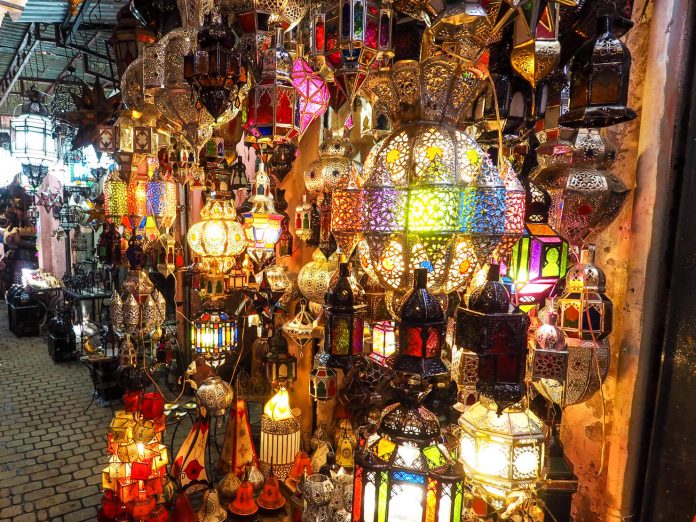
Shopkeepers Are Your Friends
If you want some help navigating, the best people to ask are shopkeepers or those that are working in the souk. They will point you in the right direction usually without wanting anything in return and they also can’t leave their shops.
I always try to walk with purpose and try not to look lost, even when I am. That way someone is less likely to try and take advantage of my situation.
Generally, people in Morocco are very lovely and helpful, but it has been known for some (especially in the cities) to come up to you and offer to show you the way and either take you somewhere else (their friend’s shop) or turnaround and ask you for money, however, I believe the government has clamped down on this anyway (I think it’s actually illegal now- but don’t quote me on that). We did get a few people offering to show us where to go, but none asked for money, although a couple did the first time I was there a few years ago.
Build-in Time for Shopping & Leave Room in Your Suitcase
If you hadn’t worked it out, Marrakech is a shoppers paradise, so build in some time for shopping. Then you’re going to need to leave a bit of room in your suitcase to fit all your souvenirs in and lots of cash to buy them with.
I wasn’t going to buy anything this time and my backpack was full when I left home, however, somehow, I came back with a jumpsuit, 7 scarves (yes 7), a pair of earrings, a bracelet, a pair of shoes, a painting and an all in one kaftan thing that makes me look like Jasmine from Aladdin and that was me bring restrained.
My friend came back with even more stuff, including a rug, a wooden camel, jewellery, some wooden boxes, a game, a bag, ceramics…
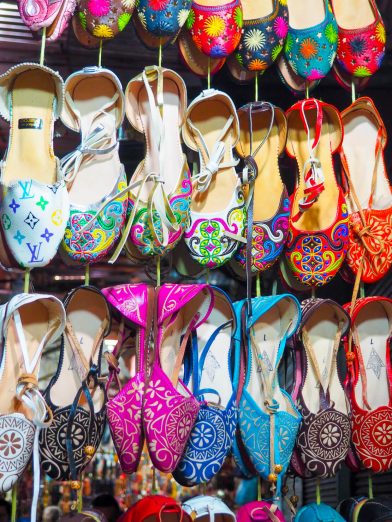
Bargain Hard
Haggling is a national sport in Morocco and I don’t want to say that everyone is trying to rip you off, but most will give it a good go. If they did it at the Olympics, the Moroccans would win every time. It’s in their blood.
A lot of shops sell the same stuff, so you can definitely get a good price if you shop around and aren’t too hasty in your purchases. I bought a pair of shoes (they were similar to the sky blue ones above) for 180 dirhams bringing the guy down from his initial 250. He was a little old man so I figured he wasn’t ripping me off.
Later on, I saw a very similar pair of shoes in another shop. When I asked the price, the guy said 100 dirhams. So the little old fella had definitely seen me coming!
My main rules of haggling:
- Go in with a sense of humour and a smile. Moroccans have an excellent sense of humour, so have a bit of banter with the shopkeepers. It can be really fun.
- Look disinterested. Whilst I was waiting for my friend outside a shop the other day, a guy tried to sell me a bag. I’d actually seen it a few days earlier and quite liked it, but I knew I couldn’t get it home with my luggage restrictions and on closer inspection, it looked a bit dirty. I kept saying no, no, no. He started his price at 700 dirhams, he thought I was driving a hard bargain, but I actually just didn’t want to pay the excess baggage fee and wasn’t so keen anymore, so he kept dropping his price and eventually was saying 250 dirhams. He dropped his price by 550 dirhams, that’s £42 or $60. If this guy came down that much, just think how much he was trying to rip me off in the first place.
- Walk away if you need to, just to emphasise your disinterest.
- Go in with a price in your head that you are happy with. When the salesperson gives you their price, drop it right down, to maybe a third of the price or less if you’re feeling feisty. They say 800, you say 200, meet somewhere in the middle that you are happy with. They’ll never sell for less than it’s worth so don’t feel bad about starting low (see number 2).
- Be firm. Sometimes I just keep repeating the price I want to pay until they give in.
- Don’t let anyone bully you into buying something you don’t want. I cannot even tell you how many times I used to get home and be like ‘why did I buy that?’ – but I’m much better at saying these days!
- Check it’s real. Before you buy anything and pay a lot for it, check it’s authenticity. If they say it’s real leather, drop some water on it . If they say it’s a rug made from wool, take a lighter to it (real wool won’t light). If they say it’s real silver, check for the stamp or test it with a magnet (real silver is not magnetic). Not always easy (I mean who carries a magnet round with them?), but just don’t always believe everything the sellers tell you.
Play the Happy Imbecile (if you need to)
As you walk through the markets, lots of people will call you and try to get you to go into their shop, buy their stuff, drink their orange juice and they can be persistent. So I just smile, wave, and carry on wandering, looking around smiling like an idiot so they think that I’m in my own little world.
As I walk away I’ll often hear ‘miss, miss, excuse me, hello miss’ and I just keep on walking. That way I don’t appear rude, just a bit stupid.
This is one of my favourite tricks, which I have been doing for years, however, a Dutch guy I met in Mozambique hit the nail on the head with this description. This was his tactic for avoiding the notoriously corrupt Mozambican police. As they tried to flag him down, he would wave and smile like a maniac and just keep on driving.
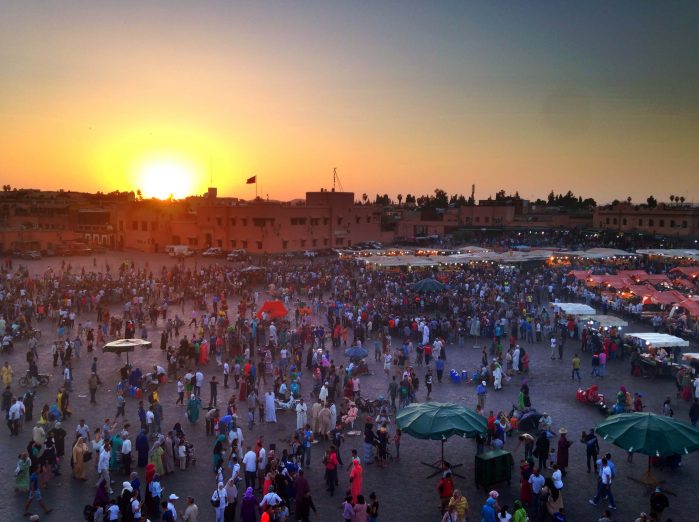
Learn the Word “Inshallah”
A favourite phrase of mine in ‘Inshallah’ which means ‘God willing’ in Arabic. It’s used commonly in Morocco, for when you hope to see someone again, or if you’re hoping something good will happen.
People also use it in the context of time, as in the same way the Spanish use ‘manyana’. Morocco is in Africa, so it’s not immune to good old ‘African time’, you get there when you get there at an unspecified time in the future, ‘Inshallah’.
Although nowadays, a lot of people use it to get out of situations that they don’t want to be in. For example:
A shopkeeper says ‘Come in and see my shop, just look, not buy’ (you will hear this a lot) and you really don’t want to, you say ‘Inshallah’ with a smile and keep on walking. Probably not the right use for the word, maybe you will go back to that shop, maybe you won’t but when you say it, the shopkeepers generally find it funny and understand you’re not in the mood right now.
Pronounce it ‘In-SHA-LAH’ with the emphasis on the ‘sha’ and the ‘lah’.
Advice on Getting Taxis
When you need to get a taxi, always ask a local (maybe the people who work at your hotel) how much a taxi will be from A to B. They can usually give you an approximate price so you know what you are working with.
Just be aware that when you go to get your taxi, the taxi drivers will always quote you a higher price – tourist price.
There is some negotiation, but some will just walk away if you don’t give them what they ask for. There are usually a few taxis around though, so you can just move on to the next, but very rarely will they go down to the price that it actually probably should be, so you just need to find a price that works for you both, without you getting totally ripped off. This is how my conversation went earlier today:
Me: How much is a taxi to the bus station? (The owner of my riad told me it should be about 50 dirhams)
Taxi Driver: 70 dirhams.
Taxi Driver: 60
Taxi Driver: Ok 50.
So just be firm. If you find a good taxi driver, who gives you a fair price the first time, take his number and please send it to me.
Taking Photographs
General street scenes are fine, but if you take pictures of a specific person or someone’s stall without asking they may get offended or ask for money.
If you want to take photos of the street performers (musicians, snake charmers, or the guys in traditional costume in the square, etc), you will need to pay for the privilege. They sometimes tell you to take a photo and then demand money after, so just be aware that this may happen and try to agree on the price before if you really want that photo.
When you’re watching the busier performances in the square it’s usually fine and you won’t need to pay (maybe give a tip if you feel like it), but if you want a posed photo, then be prepared to cough up.
12. Avoid the Men with the Monkeys & Snakes in Jemaa el Fna
Speaking of the guys with the monkeys…
One of the things I don’t like about Marrakech is the men in Jemaa el Fna (the main square) with the chained up monkeys and the Snake Charmers. They like to get you to take pictures with the animals for money. It’s cruel (they often mistreat the animals) and the men can be aggressive.
I was walking through the square when one of the monkey guys came towards me, trying to get me to touch his monkey (this is not a euphemism) and I kind of ducked out of his way “What, you don’t like monkeys?” He said. “No, I don’t like the fact that you have chained the monkey up.” His response? Shouting “You are ugly as fuck!” in my face. As I walked away he shouted “Nice ass.”
I just ignored it. Do I wish I’d said something, maybe? But would it have achieved anything? Probably not.
But it’s ok, I go to sleep happy in the knowledge that I travel the world for a living and he is an asshole that walks around a square all day chained to a monkey.
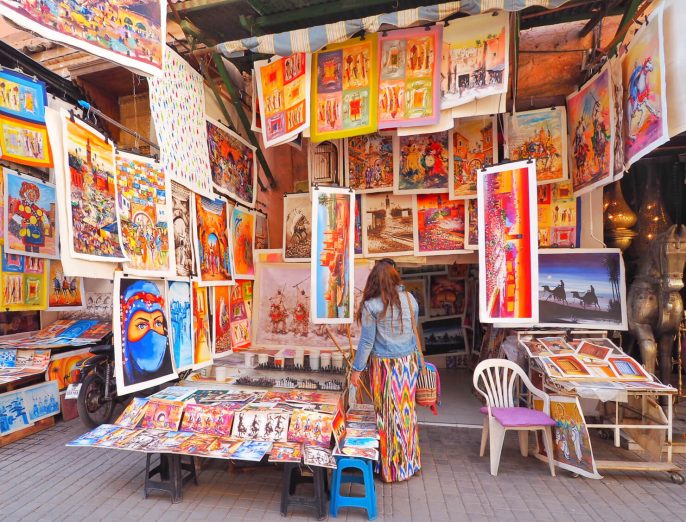
Dealing With Male Harassment
I’ve heard stories of women being catcalled or even having stones thrown at them in Morocco, but I hadn’t personally had any real negativity or harassment thrown my way until the dude with the monkey.
I get the odd “beautiful” or “hey Shakira” but I just give them a polite yet tight-lipped smile and keep on walking so as not to encourage that behaviour. I often pretend that I haven’t heard, or I just raise my eyebrows, roll my eyes, and give a wry smile and just keep on going.
This time I was there I had a guy whisper ‘sex’ into my ear as he walked past me at night and another creepy guy tapped his lips as if to say ‘give me a kiss’ when he was showing us where they dye the materials to make the rugs. He then kept following us around and trying to get us up to a rooftop restaurant to see the ‘views’. We quickly made our excuses and left.
I find the best way to deal with this kind of behaviour is just to not rise to it. Keeping relatively covered up and wearing a wedding ring also helps.
If you are alone, do not let anyone show you a ‘secret’ place and don’t walk alone late at night in the quieter parts of the medina.
Bring a European Plug Adapter
Take a Food Tour with Marrakech Food Tours
I honestly can’t rate this tour highly enough and it’s definitely one of my top Marrakech tips!
Run by Amanda, the blogger behind Maroc Mama and her husband Youssef (who was our guide that night), Marrakech Food Tours is a great way to get an insight into Marrakech (and Morocco) through the heart of the city – the food, the souks, and the people.
Again, they will take you to local places that you would never find on your own and you’ll get to try all kinds of different Moroccan dishes, including sheep’s head (you get a sticker if you eat the eyeball – I passed on that one) and THE BEST couscous I’ve ever tasted.
Book in advance as the tours fill up pretty quickly and I’d say not to do this tour on the same day as you do Saeed’s tour as you will be exhausted.
If you can’t book onto Amanda’s tour, you could try this tour which also gets rave reviews.
Don’t Drink the Tap Water
The tap water in Morocco is not known for being particularly drinkable, so it’s probably best to avoid it, especially if you are prone to a dodgy tummy every now and again.
I am one of those people who brushes their teeth with the water, with the thought in mind that I’m building up my immunity, but I definitely wouldn’t encourage anyone else to do it!
Bring a LifeStraw bottle (or similar) with you and then you don’t have to keep buying bottles of water.
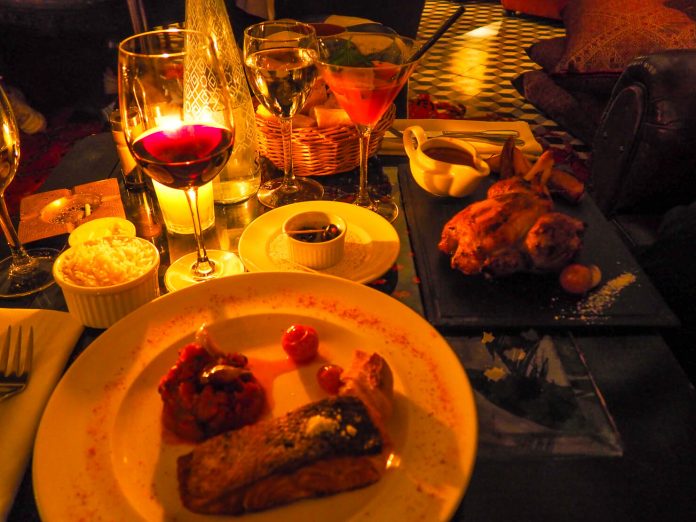
Where to Find Alcohol in Marrakech
So many people asked me about where they could find alcohol in the Marrakech medina because only a few bars and restaurants sell it and those that do, tend to be quite expensive.
The nightlife in the medina is pretty chilled, but the places that I know do sell alcohol are Cafe Arabe, Dar Anika, the Piano Bar at Les Jardins De La Koutoubia, Le Tanjia, Le Salama, Kosybar and the Churchill Bar at La Mamounia (just outside the medina).
But if you want more lively nightlife (and alcohol) head to the modern parts of the city, Gueliz, and Hivernage, which are a short taxi ride away from Jemaa-el-Fna. A taxi should probably only be about 30 – 50 dirhams, but you’ll likely be charged around 80 dirhams one way.
Bigger supermarkets like Carrefour and some riads also sell alcohol.
Keep an Eye on Your Belongings
The medina, souks and Jemaa el Fna are all very busy and therefore it’s an ideal place for pickpockets to lurk.
Keep your wallet and phone safe within your bag or about your person and if you have a bag, keep it zipped and close to you.
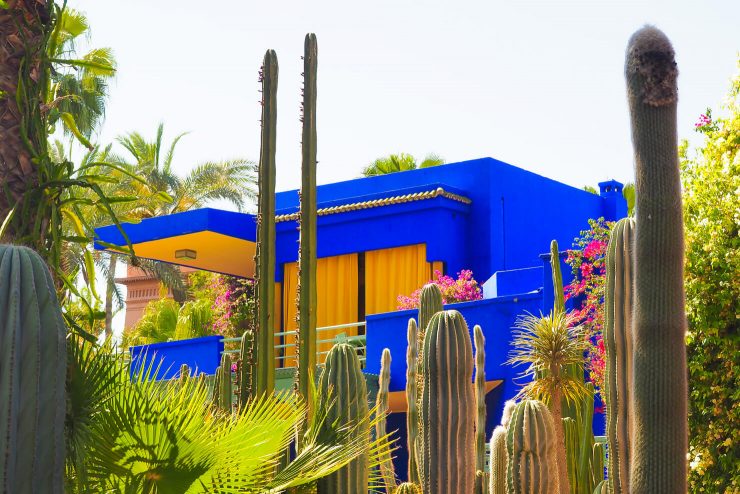
Skip Jardin Majorelle
Some people are bound to disagree with me on this, however, I honestly think Jardin Majorelle is one of the most over-hyped, boring tourist attractions I have ever visited. It might be ok if you’re a big fan of Yves Saint Laurent or really into art deco design, but even then, I’d say it wasn’t that great compared to other places you can visit in Marrakech.
I do love a garden, but there are others that I much prefer to Jardin Majorelle. It’s also usually pretty busy so you need to go early to avoid the crowds.
However they have now opened the Yves Saint Laurent Museum next door, so if you combine the two, it’s probably much better. I like the look of Anima Garden instead, but I haven’t been there yet!
Swat up on Your French, Arabic or Berber
A lot of people can speak English, but knowing a little bit of French is useful, especially in restaurants, as most of the menus are in French and a lot of people speak it.
The two official languages are Arabic and Amazigh (Berber) and even if you don’t speak a lot, attempting a few words will always go down well. The most important probably being thank you, which is ‘shukraan’ (I’ve seen it spelled various ways) in Arabic and ‘sahit’ in Berber. And of course the best word in Arabic… ‘Inshallah’.
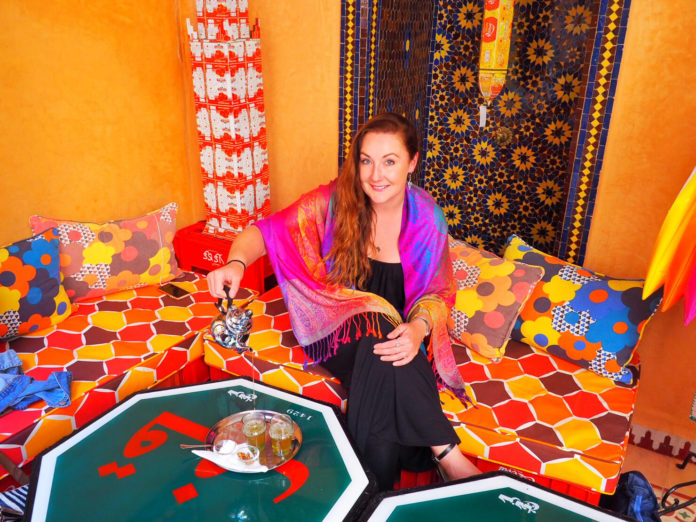
Always Make Time for Tea
When you’ve had enough of the madness of the medina, head indoors to a nice riad courtyard or a rooftop terrace to partake in one of Morocco’s favourite pastimes – drinking traditional mint tea. It’s delicious!
You can get mint tea almost anywhere, but we had a lovely pot at Riad Yima , which is an art gallery, shop, and tea room all in one.
Dress Appropriately
Marrakech is pretty conservative and the local women are usually very covered up especially in the medina, however, it is a cosmopolitan city and they are used to tourists, so you don’t have to go to extremes.
Keeping knees and cleavage covered is definitely a good idea, so no shorts or short skirts or plunging tops, if just to avoid any unwanted attention if nothing else. I generally prefer to keep my shoulders relatively covered out of respect for the local culture, but I wouldn’t feel uncomfortable if they weren’t. Saying that I usually carry a scarf with me at all times – you can easily buy them in Morocco if you don’t have any at home.
You’ll also need to take note of the weather too. If you go in the summer months, Marrakech gets very hot, so breathable, lightweight clothing is good. Marrakech can also get cold and wet at certain times of the year, so take something warm and/or waterproof with you. I was just there in April and it was freezing and raining.
When it rains in Marrakech the souks become very waterlogged as the drainage system isn’t great, so you may want to take some closed-toe shoes that will withstand a little bit of water.
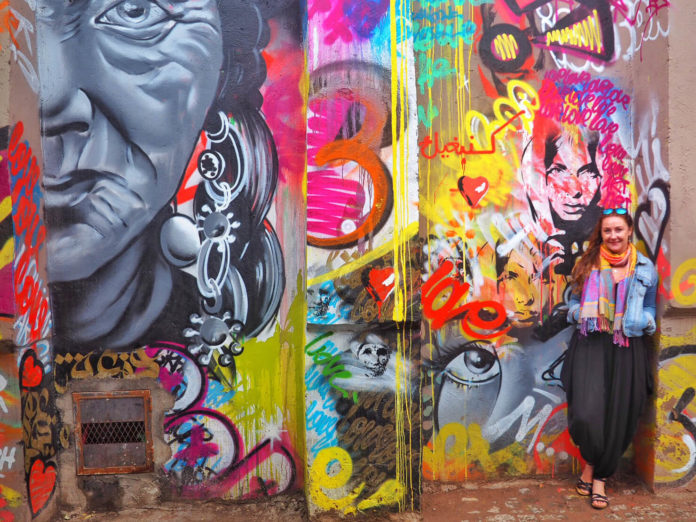
Just Let Marrakech Happen
One of my best tips for Marrakech is to just go with the flow. It’s good to have a bit of a plan for Marrakech and some things do book up in advance (good restaurants/food tour etc) but you should leave a bit of time to just let Marrakech happen, to wander, to get a bit lost, let the chaos unfold around you and to just to sit and people watch for a while.
I hope this helps you get prepared for your trip to Marrakech!
Other Morocco posts you might enjoy…
- The Perfect 2-Week Morocco Itinerary
- Surfing in Morocco – The Complete Tagazout Travel Guide
- The Charm of Marrakesh
- Highlights of the Rock My Morocco Adventure
- 16 of Africa’s Most Incredible Hiking Destinations
- Morocco – Yoga, Surf Sleep, Repeat
- Camping Under the Stars in the Sahara Desert, Morocco
I love to travel all over the world, but it's Africa that holds a special place in my heart. My mission is to help people travel Africa in an authentic, safe, fun, adventurous and ethical way.
Similar Posts
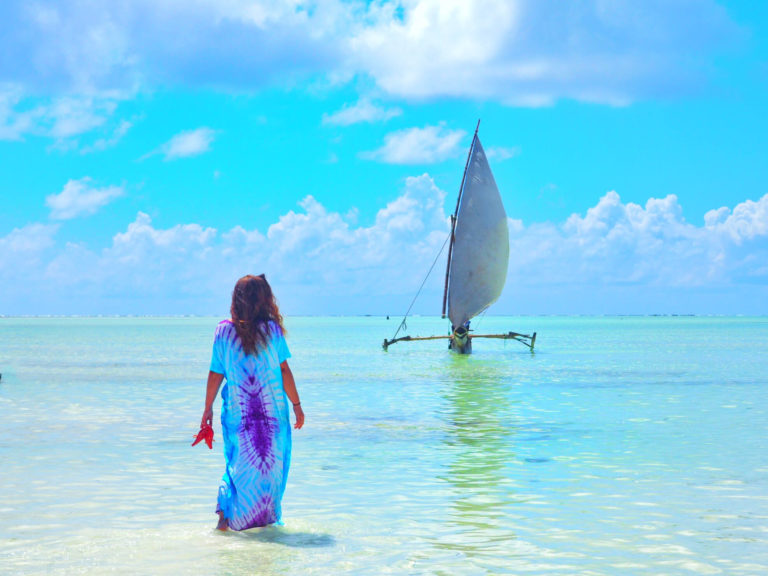
What to Wear in Zanzibar & Other Cultural Considerations
There’s been a lot of talk on social media recently, mostly from Zanzibar locals who are upset with the way…
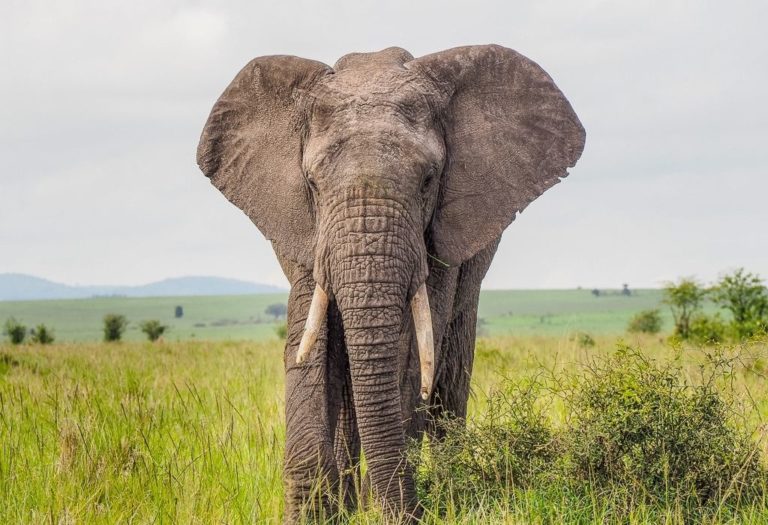
The Best Places in Africa to See Elephants
Seeing elephants in the wild, in Africa, for the first time is out of this world. It’s a completely humbling…
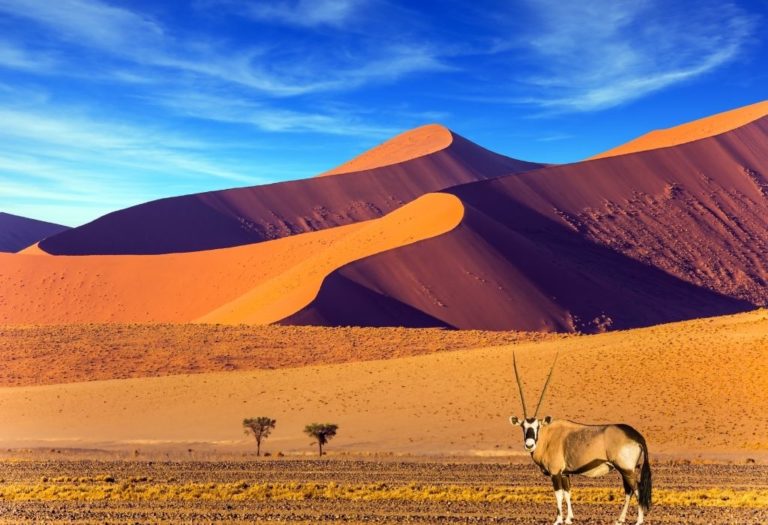
An Epic Namibia Itinerary (Plus Map, Tips & Best Places to Visit)
Planning your Namibia itinerary? Well, you’re in for an incredible adventure! I’ve been to Namibia a few times NOW and…
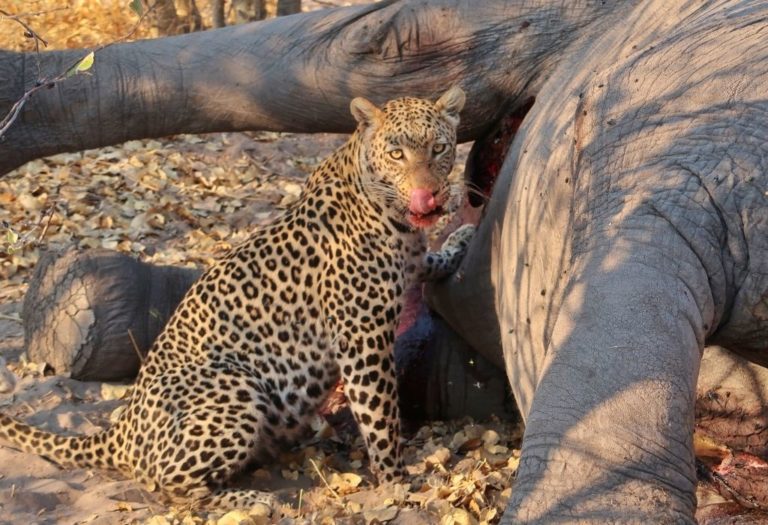
The Best Safaris in Southern Africa
When looking for the best safaris in Southern Africa, you will be spoilt for choice as there are so many…
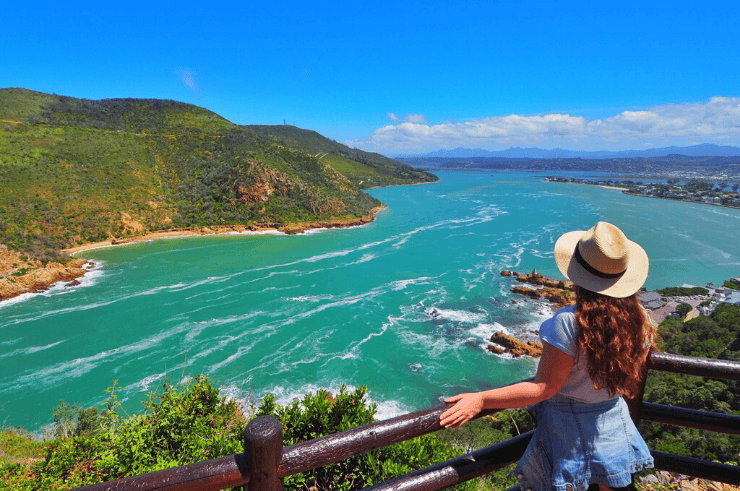
An Awesome Garden Route Itinerary (with Cape Town)
If you’re looking to plan an incredible Garden Route South Africa itinerary, you’re in the right place.
I’ve driven South Africa’s famous Garden Route three times now, so I wanted to share my favourite Garden Route itinerary and tips with you, to help you plan your own epic trip.
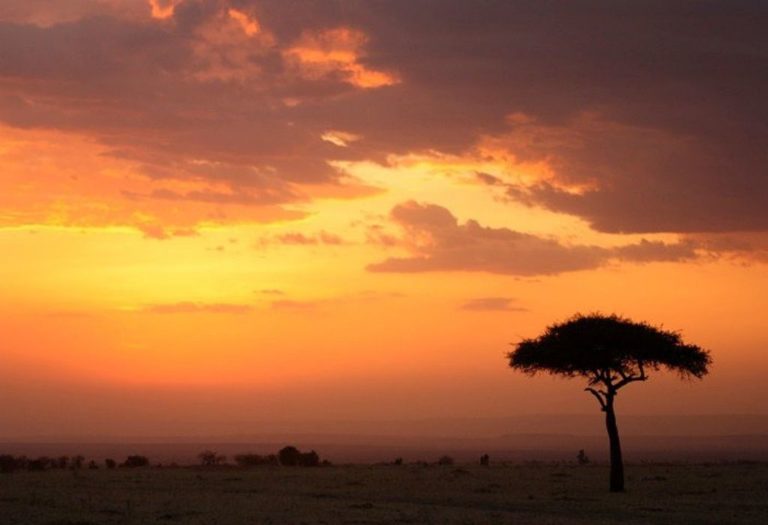
The Best Hostels, Guesthouses & Campsites in Tanzania
Looking for the best hostels, guesthouses and camps in Tanzania? Then you’ve come to the right place! Here are my…
24 Comments
I was in Marrakech last month, and I heartily agree with all of Helen’s advice (except skipping the Jardin Majorelle, but then I’m really into gardens). Here are a few little doodads by way of addition. My Parisian French helped quite a bit, but be aware that Moroccan Arabic is its own creature and Egyptian or Gulf Arabic will be of limited utility. A pleasant surprise for me in Marrakech is that the ice cream is quite good. If you’re into architecture and decorative arts, I recommend the Marrakech Museum (next to the Merdersa Ben Yousef). The building is the star attraction there. In most ‘restored’ historic buildings, the marvelous, ornate plaster and stucco work is restored structurally, but it is left white. At the Marrakech Museum, that decorative work is restored to its polychrome glory.
Thanks Tom! Great tips! 🙂
Great list! I wish I had seen this before I went… My husband and I had a bit of a confrontation with the snake guys in the square our first day (he gave them $20 to end it, smh) and also had a guy in Essaouira try to take us to his friend’s restaurant and then demand money. We refused, and he popped up in 3 different places around the city shouting that the Americans owed him money. Those are definitely two very real things to try to avoid.
However, I LOVED the Maroc Mama food tour- so delicious! It was definitely the best thing we did in Marrakech and the street vendors were much less aggressive when we were with Youssef. And the shopping was unreal!
Yeah, the snake and monkey guys are just horrible people who can become aggressive very quickly – best avoided. and wow, the guy in Essaouira sounds really persistent. I’m really on my guard now when anyone offers to show me the way, I always refuse but some people just genuinely want to help. Then I feel bad I was so adamant! 🙂
I haven’t been to Marrakech but seeing your photo it looks like the place has a lot of fun and lively colors from shops to cafes. I would definitely like to visit the country soon but for now I will add it to my “must travel places” on my bucket list.
It’s amazing!!! 🙂
It is absolutely beautiful. The culture looks like my local swap shop. I haven’t been yet but I would love to go just to try their food and shop haha! We might go to Marrakech this summer If we have enough saved up but the tickets are super expensive $1100+.
Ow wow, that’s expensive! Marrakech itself is pretty reasonable though – except to eat and drink in fancy restaurants! 🙂
Such a detailed post full of useful tips. I really want to go to Marrakech but am a bit nervous about going there alone. Thanks for sharing these advice. Just what I was looking for!
Thank you! Honestly, don’t be scared, it’s a great place to travel, just keep your wits about you.
Thanks for sharing all of these. Totally agree with all your tips! We loved Marrakech and didn’t encounter any problems like I heard so many others unfortunately did. Like you, we always walk with purpose and look like we know where we are going even if we are slightly lost. The men that try to “guide” you were a pain but we were able to mostly avoid them. Definitely agree with wearing comfy shoes and bargaining hard!
Very informative post and enjoyable to read! I’m thinking about taking a trip to Morocco towards the end of the year so I’ve saved this post. Thank you for writing it 🙂
Thanks Sandy! Hope you have an amazing time!
So helpful! Thank you so much! You sure had me in stitches with the monkey man!!!
Ha ha, no worries! 🙂 Hope you are well!!!
Your post is so useuful and I love it. Marrakech is on my bucket list for one year now and I can’t wait to see it.
Wow, first of all, thanks so much for this lovely article with these colorful pictures. I really like it. I’m definitely going to try some of these tips for my next trip.
Such an amazing post.
Thanks for sharing wonderful tips with us. I really loved your post.
Keep Sharing…!!!!
Amazing list Helen, Loved it.
Great Post Helen
I love the pictures . Very nice article . Also taking Moroccan cooking class is a good experience as well as trying the Moroccan Hammam (spa).
Excellent blog post, and thank you for sharing some very helpful thoughts!!! Best of luck with your travels.
What a great article! Marrakech is such a great place but I definitely wish I did more research before I went! Thanks for all the info!
I have been to Marrakesh before, long ago, and am about to visit with my partner and our 5 year old girl. This blog is by far the best of of all the travel tips I have seen, all very wise. It seems like the place has calmed down a little since I was last there 10 years’ ago so am a little less nervous about launching into the souks with my little girl in tow!
Vive l’adventure!
Leave a Reply Cancel reply
Your email address will not be published. Required fields are marked *
Privacy Overview
Another day, another discovery.
- Hueco Tanks
- Central Park
- Who’s This Oddball Anyway?
Marrakech, The Tourist Trap

I don’t want to miss a single second of my experience here, and yet I feel as though the days have been dragged on, due to massive amounts of schoolwork, intense culture shock, homesickness, and in-group drama.
But all the tiny moments, positive and negative, I had experienced during that first week in Rabat, all culminated into an intense whirlwind of emotions that is Marrakech.
First: The City
Marrakech is not tourist friendly; much of the famous medina is dedicated to luring tourists into buying overpriced items. The city felt as if it was a representation of what foreigners wanted to see, and not how locals actually lived. From (renovated) crumbling ancient mansions with entry fees and hoards of tourists, to poly-lingual storeowners who switched between three or four languages to grab a passerby’s attention, the city was catered to foreigners.
And yet, once spoken to with kindness and an interest for the culture, many of the storeowners responded with excitement and curiosity. Our most frequent greeting to the people of Marrakech was “I’m not a tourist, I’m a student studying Arabic.” Many friends were made, and conversation (along with haggling!) became very easy once we expressed our interest in their culture. Though I still clearly overpaid (I knew something was wrong when he accepted my first offer), I wound up buying a lantern and a set of argon oils for friends and family back home!
Architecturally, the city was beautiful. It was colorful and intricate, and distinctly Moroccan. Entrances to most streets within the medina were curved archways, and the city itself was surprisingly lush with plants and trees. Large public squares were breeding grounds for harassment and those who aggressively tried to sell hats, watches, phones, henna, and those who conned the naïve into taking pictures with exotic animals, for a price.
As a group, we spent most of our time amongst ourselves, shopping, exploring the most touristy of all the attractions, and of course: taking care of one of the hundreds of abandoned kitten that roamed the streets. The kitten, now named Tima, became particularly attached to one of the girls who fell desperately in love and decided to take her home with her. Crazy? Absolutely. As we walked from our hotel to the taxi cab station, people called “Meow” out at us, as if the situation weren’t already ridiculous.
Two days were not enough to explore everything. I hope to visit Marrakech again and to experience it more fully.
Second: The Group and I
According to some psychologists, as humans we instinctually group together, from macro to micro communities, for codependence, security, and a sense of belonging. We in part define who are based on how we fit into our group’s dynamic. I personally have never felt associated to a group other than my family, and so who I have become was solely influenced by how I fit into my family’s dynamic.
Here’s the relevancy: when I chose to study abroad, I knew that there was going to be a level of codependency between us classmates because of the obvious language barrier that existed. But that codependency turned into a fight to find sanity within each other in a country that made little sense to most of us. The journey to Marrakech strengthened that fight, as the central part of the city further alienated visitors as foreigners.
I have never truly experienced a level of bonding that demanded so much of my emotional and mental energy. I guess I missed that phase in high school. Miscommunications that presented themselves earlier that week came to a fine point our second night in Marrakech and resulted in an awkward break between individuals in the group. Naturally, alcohol was involved.
For our second night in Marrakech, we decided to be heretics and drink some wine. Some wine turned into a lot of wine. And a lot of wine translated into drunken shenanigans that were hilarious but disrespectful. For that night we became: The Americans.
Within our group of seven, personalities clashed and tempers flared as a result of the increasing levels of frustration experienced, presumably due to culture shock. The night ended with hysteria and unnecessary drama that is normal when one figures out how they fit into a group, and if they fit in at all.
This group was comprised of mostly American international studies majors who had already traveled all around the world. Being a psychology major who had never been further than Mexico, my role in the group felt disconnected. I struggled with the cliché feelings of not belonging but ignored the symptoms until a member of the group cursed me at over a misunderstanding. It had felt as if it was the tipping point for all the anxiety that had surfaced during my trip, and for the first time since I was here I truly regretted my decision to come at all.
But luckily we were all still codependent, and relationships were mended for the sake of peace in spite of significant personality differences. It made me realize how much compromise went into a person’s identity within a group, for better and for worse. While as individuals we compromise how we feel we should be, members of group teach you how your perception of self translates outside of your own mind.
I suppose that being abroad for even only a week amongst relative strangers can teach you who you really are. It was terrifying and humiliating, but it was my learning experience, and not a negative one.
I had often times told others that I loved to travel because I loved to explore places. But it seems that travelling goes beyond the excitement and the constant moving to constantly see new things: it’s stressful, and frequently stagnant, it forces you to adapt in ways you may not be comfortable with, and yet it’s a way to experience life through the lens of another.
No one ever said it would be pleasant, only that it would be meaningful. So far, I’d like to think that it was.
Morocco , Travel
drama homesick marrakech Morocco Study Abroad Travel Traveling in groups
Leave a Reply
Your email address will not be published. Required fields are marked *
Save my name, email, and website in this browser for the next time I comment.

- Uncategorized
- Documentation
- Support Forums
- WordPress Blog
- WordPress Planet
© 2024 Jetlag Diaries
Theme by Anders Noren — Up ↑

- Privacy Overview
- Strictly Necessary Cookies
This website uses cookies so that we can provide you with the best user experience possible. Cookie information is stored in your browser and performs functions such as recognising you when you return to our website and helping our team to understand which sections of the website you find most interesting and useful.
Strictly Necessary Cookie should be enabled at all times so that we can save your preferences for cookie settings.
If you disable this cookie, we will not be able to save your preferences. This means that every time you visit this website you will need to enable or disable cookies again.

Home » Travel Guides » Morocco » 15 Best Day Trips from Marrakech
15 Best Day Trips from Marrakech
Marrakech is Morocco’s most famous tourist destination.
The name conjures up images of spices, souks, deserts, and riads; an exotic place of bustling markets, ancient walled streets, and ramshackle houses.
It’s an exciting, vibrant and colorful place to visit; a place where you may well be as frustrated at times as you are enthralled, but where every moment is different and life is unique, noisy and seemingly chaotic.
The city is full of history, culture and excellent Moroccan cuisine, where every turn you take opens a world of new shocks and surprises that will keep you transfixed for days.
Beyond the historic walls of Marrakech, this city in the foothills of the high Atlas Mountains is the perfect launching pad to the surrounding area.
From deserts and waterfalls to Berber villages and rocky valleys, there are many day trips to take from Marrakech.
1. Ouzoud Falls

The Ouzoud Falls are an incredibly impressive set of waterfalls that plunge from high cliffs far down into a huge basin.
The multi-layered waterfall cascades from a maximum height of 110-meters, and in an otherwise arid landscape, the location is a veritable oasis in the desert, where lush, green vegetation is found amongst the rocky confines of this canyon.
The area is famous for its olive trees; after hiking to the falls, you can relax in the shade of these trees while you feel the cooling breeze of the crashing waterfall filling the air with refreshing sprays of water.
If you are really overheated, you can even swim in the Al Abid River which the falls plunge straight into.
It’s a glorious day trip from Marrakech, and one not to be missed.
Recommended tour : Ouzoud Waterfalls Full-Day Tour from Marrakech
2. Palm Groves of Marrakech

Known as the Palmeraie, the palm groves of Marrakech are a dense area of land that is completely devoted to the growing of palm trees.
It’s a strangely beautiful place; the palm trees are grown in the desert and are completely reliant on the ancient irrigation network that has been here for centuries to survive in this harsh climate.
The area is around 50 square miles and the palms are used to harvest dates, so expect to be given plenty to try by the local growers and sellers that you find here.
Many people will choose to join an adventurous quad bike tour to ride around the desert and the Palmeraie, a unique way to experience this beautiful and surreal landscape.
Suggested tour : Marrakech Desert & Palm Grove Quad Bike Tour
3. Sahara Desert

Marrakech is surrounded by desert, however, the really brutal and almost unbelievable landscapes of the famous Sahara Desert don’t truly begin until you are at least a few hour’s drive outside the city itself.
The Sahara is the world’s largest hot desert.
It’s a place of extremes, where little water is found and sand dunes tower high on the horizon.
It’s an almost mystical place – especially locally – and a trip even to the edge of the Sahara is an enlightening experience.
Many people will choose to undertake multi-day expeditions through the desert guided by locals; however, if you are short on time, you can still travel to where the Sahara begins and admire the harsh, natural beauty before returning to Marrakech for the evening.
Multi-day tour : From Marrakech: 2-Day Zagora Sahara Desert Tour
4. Agafay Desert

If you would rather stay closer to Marrakech and experience a desert closer to your accommodation, then the Agafay Desert – although not quite as famous or as sandy as the Sahara – is within easy reach of the city.
Found between the Atlas Mountains and Marrakech, the Agafay makes for an excellent day trip.
You won’t find the distinctive sand dunes here that you may be imagining, but you will find a rocky, barren and seemingly lifeless terrain that is difficult to fully comprehend in its sparseness.
It’s a humbling place to visit – you may be able to tour some of the local villages and marvel at how people have managed to thrive here for thousands of years.
Suggested tour : Quad Biking Tour in Agafay Desert
5. Essaouira

Essaouira is a vibrant port city found on the Atlantic coastline of Morocco.
It’s a welcome escape from the desert and the dry climate of Marrakech, and a trip here makes for a long but rewarding day trip.
Enjoy the beautiful sea breezes along the coast, as well as the colorful culture and buildings of the city.
The Medina is a UNESCO World Heritage Site and it’s begging to be explored, while the narrow maze of alleys and souks are as quintessentially Moroccan as you can get.
Recommended tour : Day Trip to Essaouira from Marrakech

Agadir is another coastal Moroccan city that’s found a good three-hour drive from Marrakech.
The city is making a name for itself in tourist circles as a sun-drenched, windswept and relaxed place to visit.
There is an ever-growing number of resorts taking advantage of the beautiful beaches and coastline, while the city itself is an interesting example of modern Moroccan culture and life – it’s large enough to easily escape the tourist trail and discover something new.
7. Casablanca

Casablanca is the only other city that could rival Marrakech in terms of international fame.
The name Casablanca has gone down in history, thanks to the movie and the romantic connotations associated with it.
The reality is probably very different to what you might expect, and it’s a good thing to only make a day trip to the city – it is a sprawling, urban mass.
It’s worth the journey to see this famous place for what it really is, to walk through the old streets and the new and experience an inseparable piece of Moroccan history.
8. The Atlas Mountains

The Atlas Mountains make up a vast and towering range that rises sharply close to Marrakech.
The mountain range stretches through three countries and the highest peak stands over 4000-meters tall.
The Atlas Mountains are an integral part of not only local geography but local Berber history and culture.
Marrakech is an excellent location from which to launch yourself into the mountains; many of the valleys and villages can be reached on day trips from the city.
Recommended tour : Berber Villages & 3 Valleys Atlas Mountains Day Trip
9. Ourika Valley

The beautiful Ourika Valley is found 50-kilometers to the south of Marrakech in the cool shadows of the Atlas Mountains.
The valley is full of small, local villages that have stood here for centuries, while the cool climate makes it a lush and verdant place to explore, particularly during the hot summer months when Marrakech can become scorching.
There are waterfalls, a mountain backdrop, and epic scenery wherever you turn.
Available tour : Ourika Valley & Atlas Mountain Full-Day Tour

Imlil is a local Berber village that’s found high in the Atlas Mountains.
Standing at 1800-meters, it’s set in spectacular surroundings.
Many visitors will use Imlil as a base for getting even further into the mountains on multi-day treks, including to the summit of Mount Toubkal, the highest peak in the range.
But it’s perfectly fine to simply explore here for the day – see the way the Berbers have lived here and adapted their lifestyle to the mountains and even make a few small hikes into the surrounding area.

Lower down than Imli but perhaps easier to reach, Asni is the gateway into the Atlas Mountains when you travel here from Marrakech.
It’s a quaint place of mud-brick buildings and dusty streets, where you can see local life happening on the streets.
12. Ait Benhaddou

Ait Benhaddou is a marvelous UNESCO World Heritage Site that’s found on the outskirts of the Sahara Desert.
It’s an ancient, fortified town that has stood guarding the trade routes through the desert for centuries.
Today, the town is more famous for the huge number of movies that have been filmed here.
You will most likely recognize the walls, towers, and streets from at least one film that you have seen.
Despite its now touristy, star-studded fame, the town is still an incredible and distinct example of Moroccan architecture and history and it’s well worth the dusty three-hour drive from Marrakech to see.
Suggested tour : Day Trip to Ouarzazate and Ait Benhaddou
13. Ouarzazate

Further along the road, to the south of Ait Benhaddou, can be found the fortified town of Ouarzazate.
Like its neighbor, Ouarzazate is also used as a filming location by many studios and has featured in countless historical epics and desert-based movies.
This is really where the Sahara begins too – after the high plateau that the town is built upon disappears to the south, the sandy dunes of the desert truly begin.
Suggested tour : Ouarzazate Full-Day Tour from Marrakech with Lunch
14. Amizmiz

Found in the foothills of the Atlas Mountains, just an hour’s drive from Marrakech, Amizmiz is an excellent example of a relatively untouched Moroccan Berber town.
Life here is slow.
The town is colorful but there is little of great interest to see except on a Tuesday, when the weekly market arrives as villagers from the mountains and surrounding area descend upon Amizmiz to buy and sell their produce.
It’s an incredible sight to witness.
15. Oukaïmeden

Oukaïmeden is a very high altitude resort that’s found in the snowy peaks of the Atlas Mountains.
At the right time of year, it makes for an incredible contrast to the lowlands and Marrakech.
No longer is there sun, heat and desert, now there is snow, wind, and cold.
It’s a famous ski resort within the country, and being only a two-hour drive from Marrakech, you can quite literally spend the day skiing before heading back to the warmer climes of the city for the night.
15 Best Day Trips from Marrakech:
- Ouzoud Falls
- Palm Groves of Marrakech
- Sahara Desert
- Agafay Desert
- The Atlas Mountains
- Ourika Valley
- Ait Benhaddou

Casablanca vs Marrakech: An Honest Comparison To Help You Choose
If you’re planning a trip to the fabulous country of Morocco, you might find yourself struggling to choose between two of its biggest and best-known cities: Casablanca and Marrakech. They’re both wonderful places for those who want to dive into Moroccan food, culture, and history, but they also have plenty of big differences.
Marrakech, for instance, is known as a very touristic location, drawing in travelers from far and wide, with a deep dining scene and dynamic nightlife. It’s got lots of famous attractions and landmarks to see, from its Jemaa El Fna market to its ancient red city walls and glamorous Bahia Palace.
In contrast, Casablanca, despite being well-known around the world due to the movie of the same name, isn’t exactly the most tourist-friendly spot. It’s much more of a business-oriented city, with one of the biggest ports on the planet. However, it’s still got much to offer the curious traveler, with some stunning architecture and a growing arts and culture scene.
So, which one should you pick? Well, that all depends on what kind of experience you’re looking for, and this guide is here to dig into the details and help you make up your mind. Below, we’ll compare Marrakech and Casablanca in a range of key areas, including attractions, nightlife, food, and safety, to help you see which city is just right for you.
A Quick Overview Of Casablanca vs Marrakech
Which has the best weather, which is best for activities, which is best for day trips, which is best for nightlife, which is best for shopping, which is best for food, which is safest, which is best for families, which is best for couples, which is best for backpackers.
- Which Is Cheapest?
Casablanca vs Marrakech: Which Is Better?
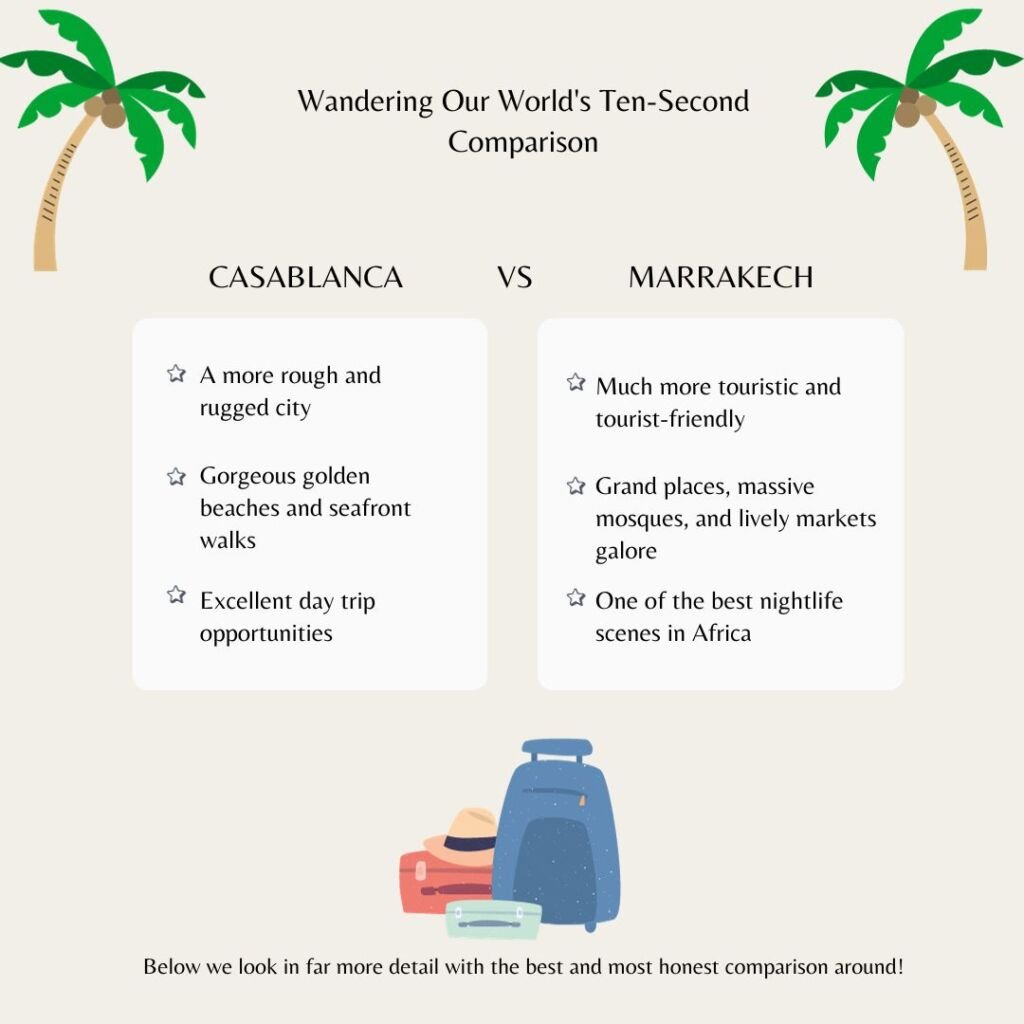
Casablanca: A Quick Overview

Casablanca, also known to locals at Dar el-Beida, is the biggest city in Morocco. It’s also the nation’s main economic and business center, with a massive population of around 3.7 million people in the main urban area and over 4.2 million in the larger Greater Casablanca region. The city sits on Morocco’s Atlantic coast in the central-western part of the nation.
Berbers settled the land around Casablanca thousands of years ago, in the seventh century BC. It became a useful port for various civilizations, including the Romans, and was later the site of great conflict, being destroyed by the Portuguese in the 15th century and bombarded by the French in the early 1900s .
In short, this city has been through a lot, but has always managed to build itself back stronger than before. Now, it’s the home of Morocco’s most important port, and also serves as the base for the country’s Royal Navy . It’s also one of the best-performing financial centers on the planet, and many major companies are based in this city.
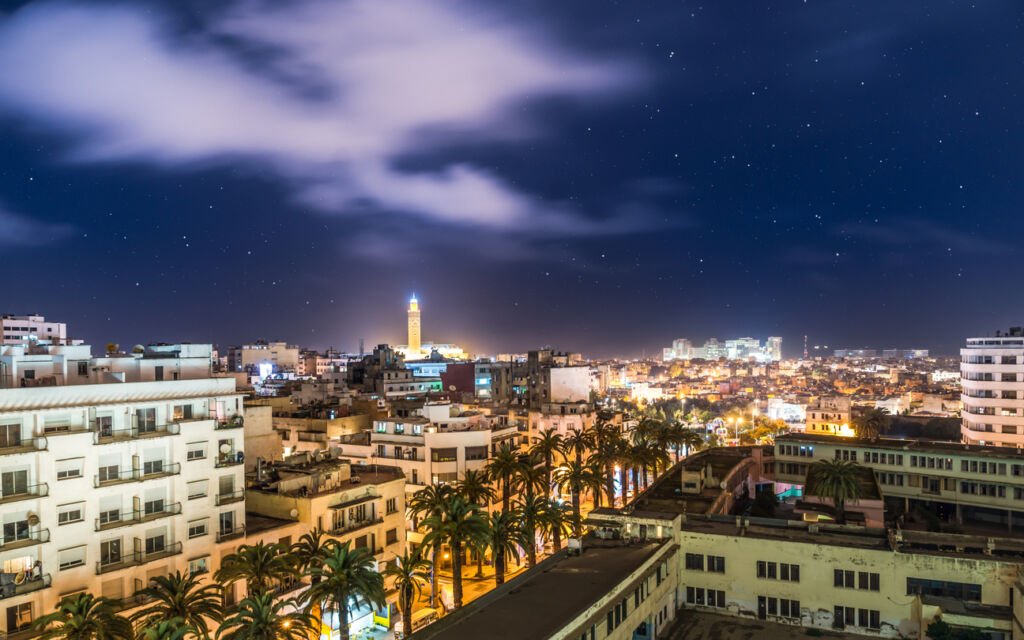
From a touristic point of view, Casablanca is a little more rough and rugged than Marrakech or other Moroccan cities, like Fez. It’s not quite as tourist-friendly, but still has some impressive landmarks, like the Hassan II Mosque and diverse architecture, with a mixture of styles including Art Deco, Art Nouveau, Neo-Moorish, and French Colonial .
Marrakech: A Quick Overview
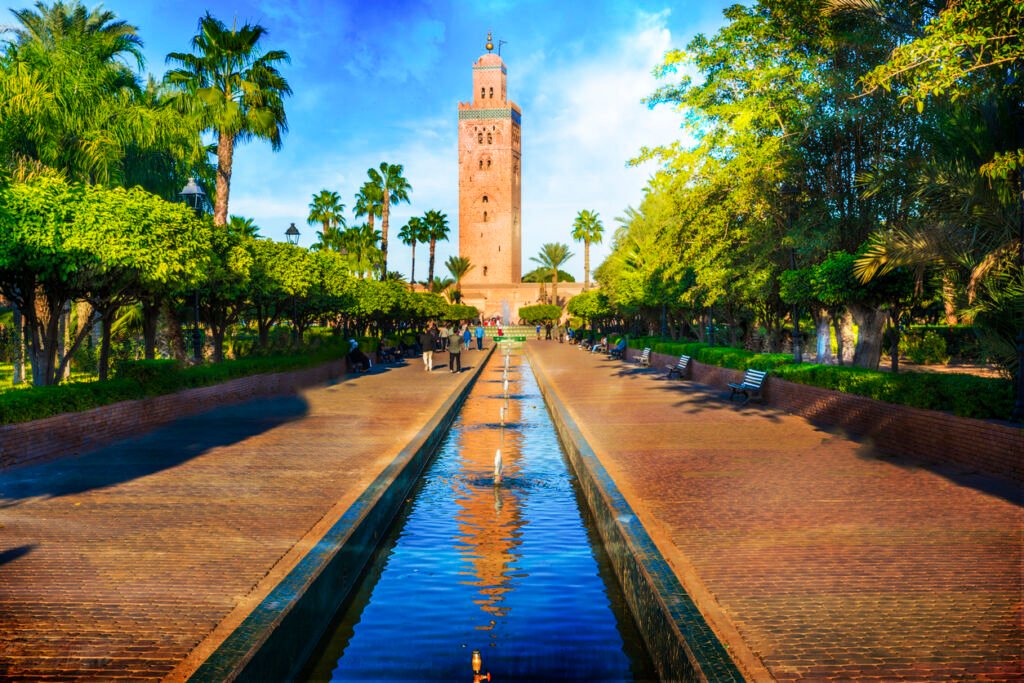
Marrakech, which may also be written Marrakesh, is the fourth-biggest city in Morocco. It’s one of the country’s four “Imperial Cities” or historic capitals – this group also includes Fez, Meknes, and Rabat. It’s situated just under 150 miles south of Casablanca in the Marrakesh-Safi region, due west of the Atlas Mountains, with a population of around a million people.
Just like in Casablanca, Berbers have inhabited the area around Marrakech throughout the ages, but the city itself wasn’t founded until 1070. It started life as the capital of the Almoravid Empire , growing rapidly in the years that followed into a major center of both trade and culture for the entire Maghreb Region.
The city later went through some tougher times, but reemerged as one of the most significant cities in Africa – a status which it maintains in the modern era. It’s also one of the most touristic cities not only in Morocco, but in all of Africa, drawing in millions of travelers each and every year from across Africa, Europe, and beyond.

Compared to Casablanca, Marrakech has much more of a touristic and tourist-friendly vibe. It also boasts a very long lineup of popular landmarks and attractions, f rom the Marrakech Museum to the Jardin Majorelle and 16th century Saadian Tombs . The city is also famed for its diverse cultural experiences, offering everything from cooking classes to hot air balloon rides .

Along with the other countries of Northern Africa, Morocco is famed for its warm temperatures which continue throughout the year. It never gets too frosty in this part of the world, but the conditions are a little different between Casablanca and Marrakech, as Casablanca is much further north and by the coast, while Marrakech has an inland location.
So, what does that all mean in weather terms? Well, it means that temperatures tend to be a little steadier and stabler in Casablanca, without too much deviation from one month to the next. Marrakech, meanwhile, enjoys much larger temperature swings, with far hotter summers and higher peaks than its northern counterpart .
In fact, summer in Marrakech can be almost unbearable, with many tourists preferring to visit during the shoulder seasons. If you’re planning a summer trip, Casablanca will be much more comfortable, but for other times of year, Marrakech is consistently warmer and drier, too .
Casablanca and Marrakech certainly differ when it comes to sightseeing and typical touristic fun. You’ll find more of the usual big city tourist attractions in Marrakech, but Casablanca also has its share of interesting activities and landmarks. Here’s a quick breakdown of the best things to do in both of these cities.
Casablanca: The Activities
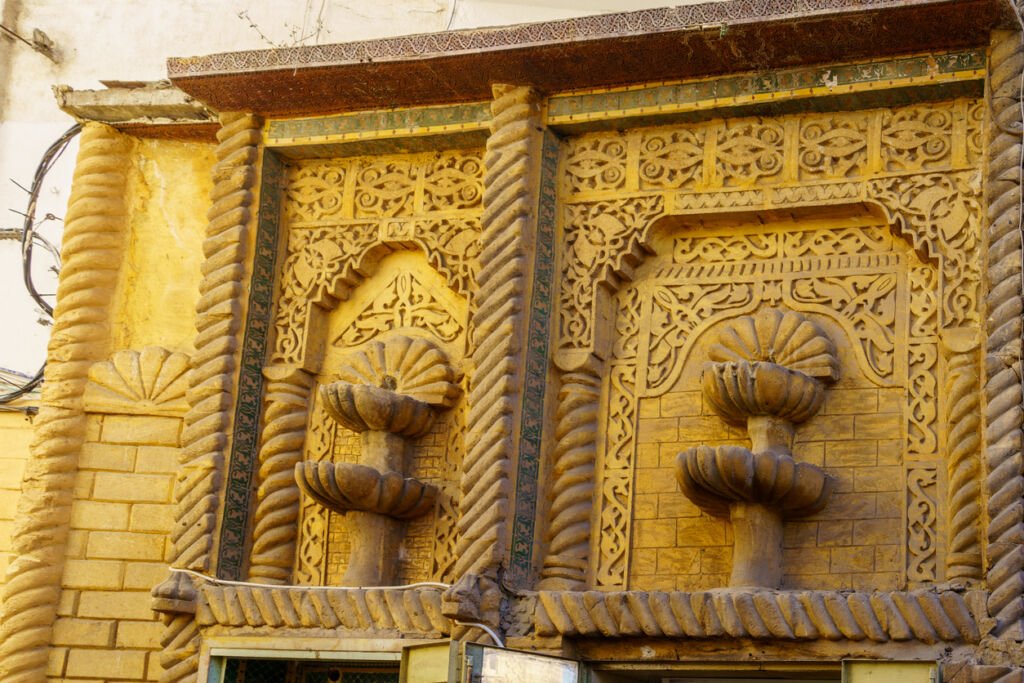
In terms of famous landmarks and sightseeing hotspots, Casablanca doesn’t have quite as long a list as Marrakech. But there are still some iconic structures to see here, starting off with the awe-inspiring Hassan II Mosque – looking out across the ocean, this is the biggest mosque in all of Africa, boasting a retractable roof and exquisite hand-crafted marble features.
Casablanca is also famed for its architecture, with an eclectic mix of styles spanning Art Deco and French Colonial. If you’re an appreciator of fine design, you’ll love to roam the city streets, stopping off at decorative buildings and squares like the Marché Central, Villa des Arts , and Place des Nations Unies.
History fans will enjoy exploring Casablanca’s Old Medina , with its fortified walls and old cannons. It’s not as impressive as Marrakech’s, but it’s still a fascinating historical area in which to spend a few hours. Then, there’s the New Medina, showcasing the city’s more modern side, with excellent shopping and dining prospects.

Of course, Casablanca is also on the coast. That means visitors can enjoy waterfront walks along the scenic Ain Diab Corniche or spend time on one of the city’s many sandy stretches, l ike the Plage Lalla Meryem or Ain Diab Beach . There are also nicely-maintained public gardens and parks dotted about, ideal for picnics or people-watching.
Marrakech: The Activities

Over in Marrakech, most tourists start off by exploring the historic Old Medina. Feeling almost like a vast open-air museum , this place is filled to the brim with beautiful old buildings, which are generally better-preserved than those in Casablanca. This is also where you’ll find Marrakech’s traditional souks , or markets, selling everything from spices and snacks to antiques and textiles.
With its narrow, winding streets and distinctive red walls, the Medina feels a little like a maze, but it’s one you won’t mind getting lost in – filled with decorative courtyards, charming gardens, and peaceful vibes , it’s the kind of place that travelers can easily spend entire days wandering around, with hidden gems awaiting around each and every corner.
If you’re seeking something a bit more grandiose, Marrakech is also home to multiple palaces. There’s the gorgeous 19th century Bahia Palace, for instance, or 15th century El Badi Palace. Religious landmarks are also scattered across the city, like the grand Koutoubia Mosque or Ben Youssef Mosque, the oldest in the entire city.
For rest and relaxation, Marrakech has many traditional hammams, along with stunning gardens, like the Jardins Majorelle, dating back to the 1920s, or the significantly older Menara Gardens , first planted back in the 12th century. On the hottest days, you might prefer to take refuge in a local museum, like the Yves Saint Laurent Museum or Museum of African Contemporary Art .

Overall, there’s much more to do in Marrakech compared to Casablanca. Marrakech has a much greater number of impressive historic buildings, along with galleries, museums, and majestic mosques to admire. Casablanca’s list of attractions is notably smaller, but it does have beaches, which are sadly absent in Marrakech.

While Marrakech and Casablanca both offer plenty of fun-filled activities, you may like to spend a day or two exploring other parts of Morocco before you take your leave. So, which city is best-placed for exciting day trips?
Of the two, Casablanca has arguably the better location for diverse day trips, as it’s within easy reach of three of the most significant Moroccan cities: Rabat, Fes, and Meknes. Long-distance buses can take you to all of these places, with plenty of towers, mosques, museums, and more to explore. There are also s ome lovely coastal resorts to see, like Bouznika and Skhirat .
Meanwhile, if you’re based in Marrakech, the best day trips are more nature-oriented. You might like to explore the mighty Atlas Mountains , for example, where you can ski, climb, or explore little villages. Marrakech is also well-placed for camel treks into the desert – you could climb the famed dunes of Erg Chebbi, for example, or delve into the Agafa Desert .

Overall, the best option for you will depend on which types of day trips you like the most. For urban excursions and cultural depth, Casablanca is best. For adventures in nature, Marrakech is the place to be.

If you love staying out late, partying and drinking until the early hours or exploring the city after-dark, Marrakech is the place for you. In fact, it’s widely regarded as one of the very best nightlife destinations in all of Africa , with a broad array of pubs, clubs, and bars to suit every kind of traveler.
Whether you’re looking for upscale restaurants, fancy wine bars, thumping nightclubs, or traditional pubs, Marrakech has got you covered. Hivernage and Gueliz are the top two nightlife neighborhoods in the city, but there are plenty of other places to party, and this city generally feels safe and walkable, even in the middle of the night.
Casablanca also has a decent nightlife scene, with a fun mix of wine bars, dance clubs, and even themed Irish pubs throughout the Racine district and other areas, like Maarif and Gauthier . However, this city doesn’t feel quite as safe or welcoming in the evenings, and most clubs will be filled with Moroccan locals, rather than the diverse mix of travelers you’d see in Marrakech.

Overall, Marrakech is definitely the better place to party and have fun in the evenings. It’s safer, and its nightlife scene is larger, livelier, and more accessible than Casablanca’s.

Shopping is one of the best leisure activities in Morocco. This nation is famed for its lively markets and majestic crafts, offering everything from handwoven rugs and handcrafted pottery to jewelry, spice blends, clothing, and antiques . But which city offers the best shopping scene between Casablanca and Marrakech?
Well, if you head to Casablanca, you’ll do most or all of your shopping in the Old or New Medinas. The Old Medina has a great range of traditional shops and stalls, while the New Medina offers an even wider range of stores, with very fair prices and a nice mix of items, like clothes, shoes, and déco r.
Over in Marrakech, the souks are the best places to browse, with lots of textile stands, carpet shops, pottery ateliers, and craft stores to see. All of the typical Moroccan goods can be purchased here, and it’s one of the best cities for stocking up on t raditional souvenirs and gifts to take back home, like rugs and shawls .

Overall, both cities have pretty similar shopping scenes, but you’ll find a bit more diversity and more English-speaking sellers in Marrakech.

For many travelers, the food is one of the best aspects of visiting Morocco. A real melting pot of ideas and influences, Moroccan cuisine is often spicy and flavorful, with the likes of cumin, ginger, paprika, coriander, and cloves featuring heavily in the most popular and traditional dishes. But which city has the better dining scene between Casablanca and Marrakech?
Well, both cities have some terrific restaurants serving up all the main Moroccan classics, like couscous and tagine. So, no matter which one you decide to visit, you’re guaranteed to get some fantastic meals and street food during your stay .
However, there are a couple of key differences. Casablanca, being by the sea, has much more seafood on offer compared to Marrakech, while Marrakech’s restaurants are a little more v aried, catering to the diverse tastes of the city’s big tourist crowds . So, if you’re looking for the wider range of food, head to Marrakech. If you’re a massive seafood fan , opt for Casablanca.

When planning a trip to a big Moroccan city like Casablanca or Marrakech, you may also want to take safety into account. While both of these cities are generally safe to travel to, there is a notable difference between the two.
Casablanca is widely-regarded as a little less hospitable to visitors. That doesn’t mean that tourists will be treated badly here, or that the people are mean. There are still lots of friendly locals in Casablanca who will be happy to help you and show you around. However, this city does have a higher crime rate and a rougher feel than Marrakech.
In Marrakech, travelers largely feel safer and more at ease. The locals are, for the most part, very friendly, though tourists may be bothered by street performers or touts repeatedly asking them for money. Pickpockets also roam the touristic center of the city, so you have to keep your wits about you, but the crime rate is much lower than in Casablanca.
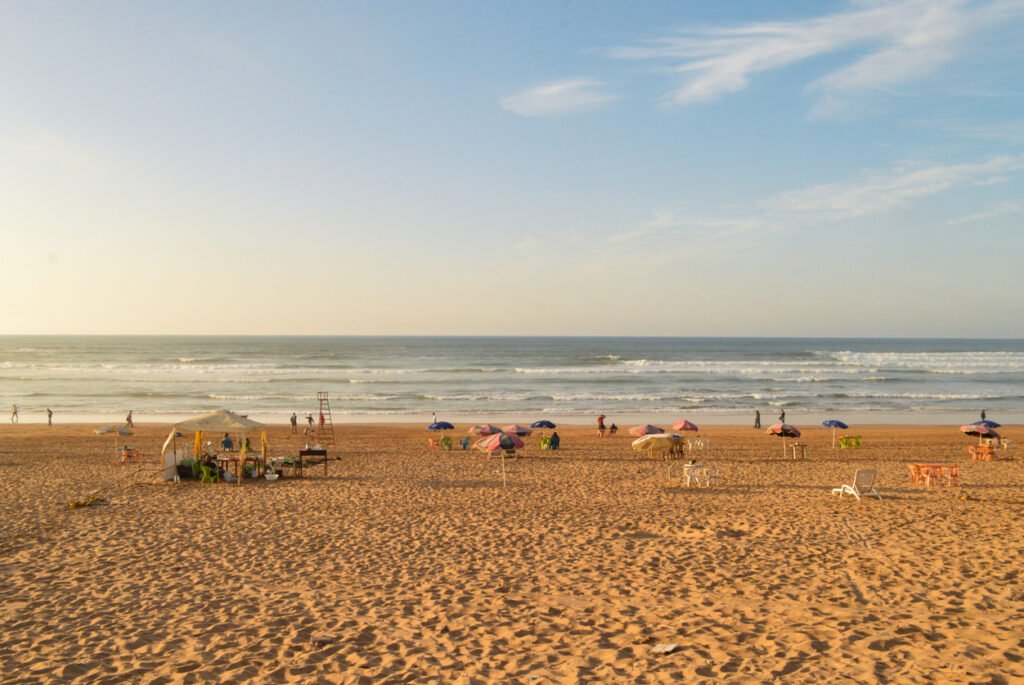
Both Casablanca and Marrakech can appeal to families, but for very different reasons. Casablanca, for example, has the benefit of being by the coast . There are several long sandy stretches to enjoy here, perfect for kids who like to splash in the sea or play games on the beach. However, the rest of the city isn’t quite as family-friendly.
Over in Marrakech, you may not find any beaches, but there are still lots of swimming pools for kids to splash about in. Marrakech also has fun family activities, like cooking classes and guided tours of the Medina. Gardens, parks, mosques, and palaces give you even more ways to pass the time, making Marrakech the better of the two cities for the majority of families.

Couples can also have a magical Moroccan adventure in either Marrakech or Casablanca. Both cities have their benefits, and the right choice for you will depend on what kind of experience you and your partner are looking for.
Those who want an action-packed trip, filled with souks, palace tours, and magical museums, should definitely head to Marrakech. It’s also arguably got the better shopping and dining scenes, along with more dynamic nightlife and a wider selection of comfortable, luxurious hotels .
However, if you and your partner are seeking more of a relaxing or off-the-beaten-path experience, far from the typical tourist traps, Casablanca is a fine place to be. It’s got very interesting architecture, with lots of charming streets to roam along, hand-in-hand with your partner, as well as romantic beaches for sunbathing or watching the sunset.
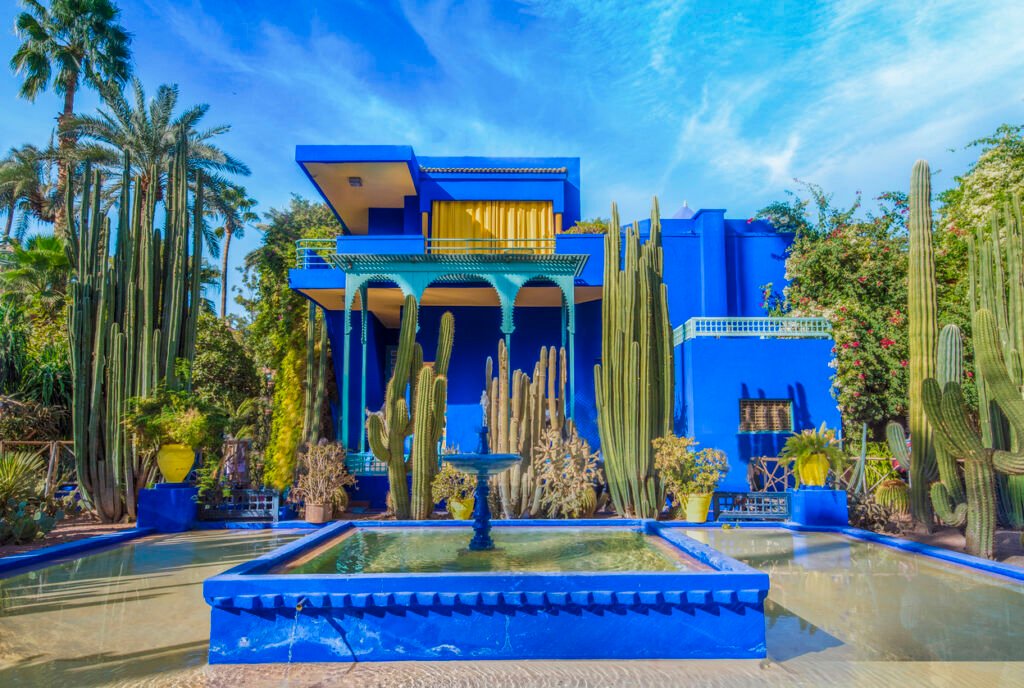
Backpackers might also like to dive into a big Moroccan city, like Casablanca or Marrakech, and both cities have their own advantages for the average adventurer.
Casablanca is arguably better for day trips, so it’s a good city to visit if you’re planning to ride the buses and hop around from city to city, exploring a wide range of Moroccan destinations. It’s also got more of an off-the-beaten-path feel compared to Marrakech, with fewer tourists and more eclectic, unusual sights to see.
With that said, Marrakech is also a fantastic backpacking destination, for several reasons. First, it’s got lots of low-cost hostels and cozy , clean places to stay. It also boasts a super street food scene and crazy nightlife, sure to appeal to young backpackers in particular. There are lots of thrilling sights to see around Marrakech, and the markets are tons of fun to roam around.

Overall, most backpackers will probably prefer Marrakech, and it’s a little safer and more accessible than Casablanca, too. However, if you’re an experienced backpacker in search of something different, Casablanca might be more appealing to you.
Which Is Cheaper?

Price-wise, there’s really not much of a difference between Casablanca and Marrakech. So, if you’re traveling on a strict budget and want to make it count, you don’t need to worry about spending way more in one city compared to the other.
Usually, accommodation rates are a little higher in Marrakech, especially for the nicest hotels in the city center. However, food and activities are a little cheaper in this city compared to Casablanca, so it all evens out, and the average trip price is more or less the same, no matter which city you choose.
Where to Stay According to your Budget
Budget: Best Western Plus Casablanca City Center is a modern oasis in the heart of the bustling city. The hotel boasts a stunning contemporary design, with sleek furnishings and luxurious amenities. Guests can enjoy exquisite dining options, a state-of-the-art fitness center, and breathtaking views of the cityscape from the rooftop terrace. The hotel is conveniently located near major attractions, offering the perfect blend of comfort and convenience for both business and leisure travelers.
Luxury: Four Seasons Hotel Casablanca sits majestically along the oceanfront, offering stunning views of the Atlantic waves. Its elegant architecture is a blend of modern and traditional Moroccan styles, creating an atmosphere of luxury and warmth. Guests can indulge in world-class cuisine, relax in the opulent spa, or take a stroll in the beautifully landscaped gardens. The hotel’s prime location also provides easy access to the vibrant city life and rich culture of Casablanca.
Budget: Ari Boutique Hôtel is a charming retreat that combines traditional Moroccan craftsmanship with contemporary elegance. Its intimate setting is enhanced by exquisite decor featuring intricate mosaics, rich fabrics, and handcrafted furnishings. Guests can unwind in the stylish rooms, savor delicious cuisine at the restaurant, or relax in the serene courtyard. With its attentive service and beautiful surroundings, Ari Boutique Hôtel offers a unique and luxurious experience.
Luxury: Almaha Marrakech is a sanctuary of luxury nestled in the heart of the bustling city. The traditional Moroccan architecture, with its intricate carvings and vibrant mosaics, creates a rich and immersive atmosphere. Guests can indulge in gourmet cuisine, rejuvenate in the tranquil spa, and bask in the lush gardens that surround the property. This hidden gem offers a perfect blend of traditional charm and modern luxury, providing an unforgettable experience for all who visit.
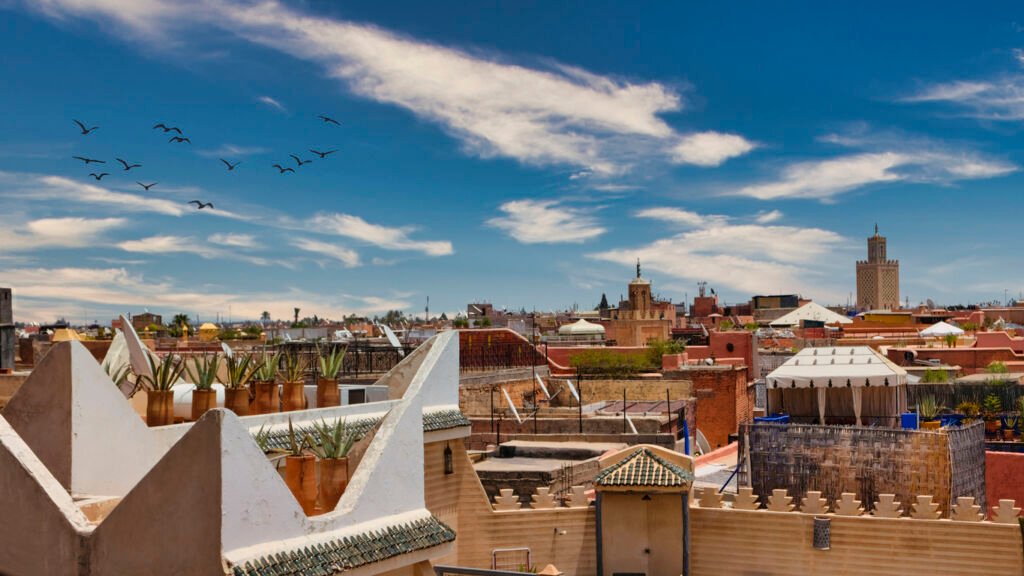
Overall, Casablanca and Marrakech are both worth considering if you’re looking to dive right into Moroccan culture, cuisine, and history. Both cities have charming historic districts to explore, along with bustling traditional markets and excellent restaurants . But, if you’ve only got the time or budget to see one, which should you choose?
Well, if we look back over this guide, one city clearly emerges as the obvious choice. And that’s Marrakech. Marrakech is simply superior to Casablanca in most of the key areas, with a wider range of attractions, better standards of safety, a more engaging nightlife scene, and plenty of fun things for families, couples, and backpackers all to enjoy.
At the same time, Casablanca is still worth considering. It can’t quite keep up with Marrakech in terms of number of activities or touristic appeal , but it offers a different taste of Moroccan life that some would say is more authentic and intriguing. It’s also got gentler weather and some lovely beaches for those who like spending time by the sea.
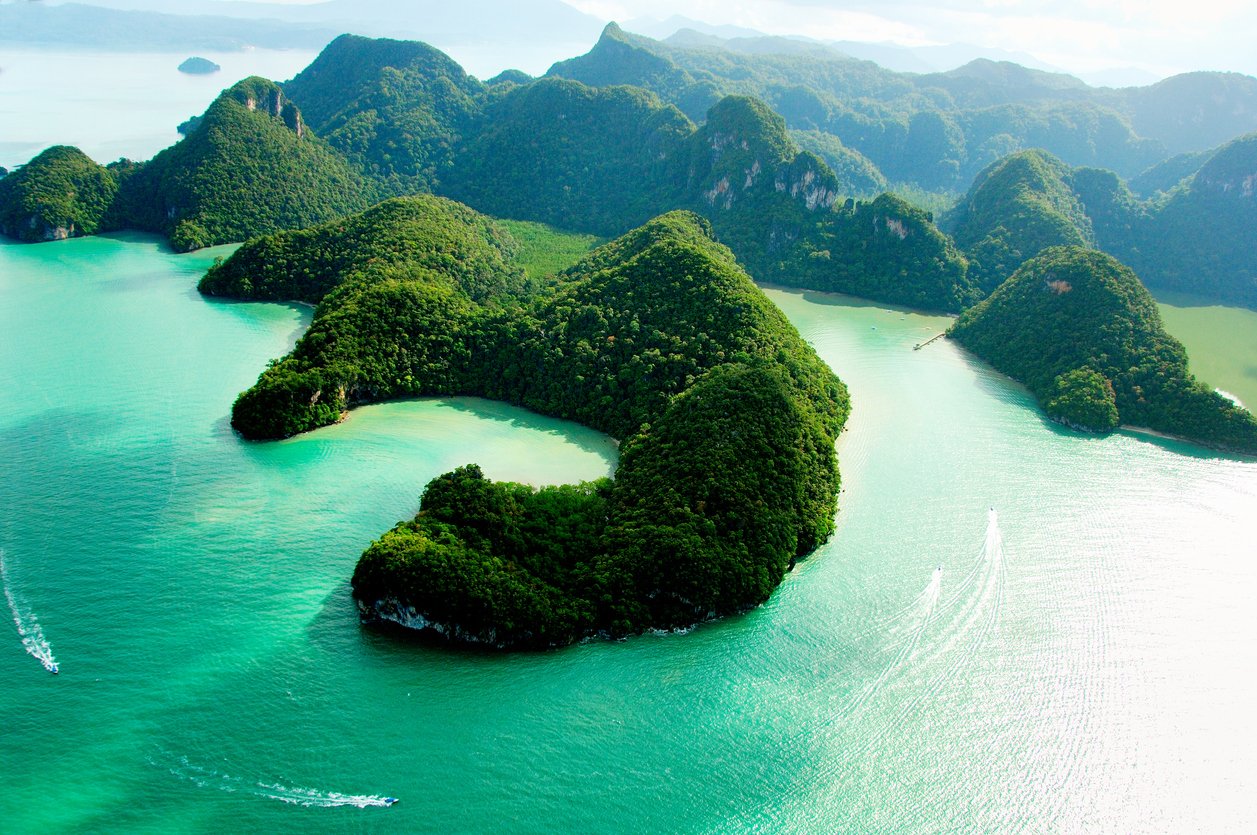
Related Posts

Tunisia vs Morocco: An Honest Comparison To Help You Choose
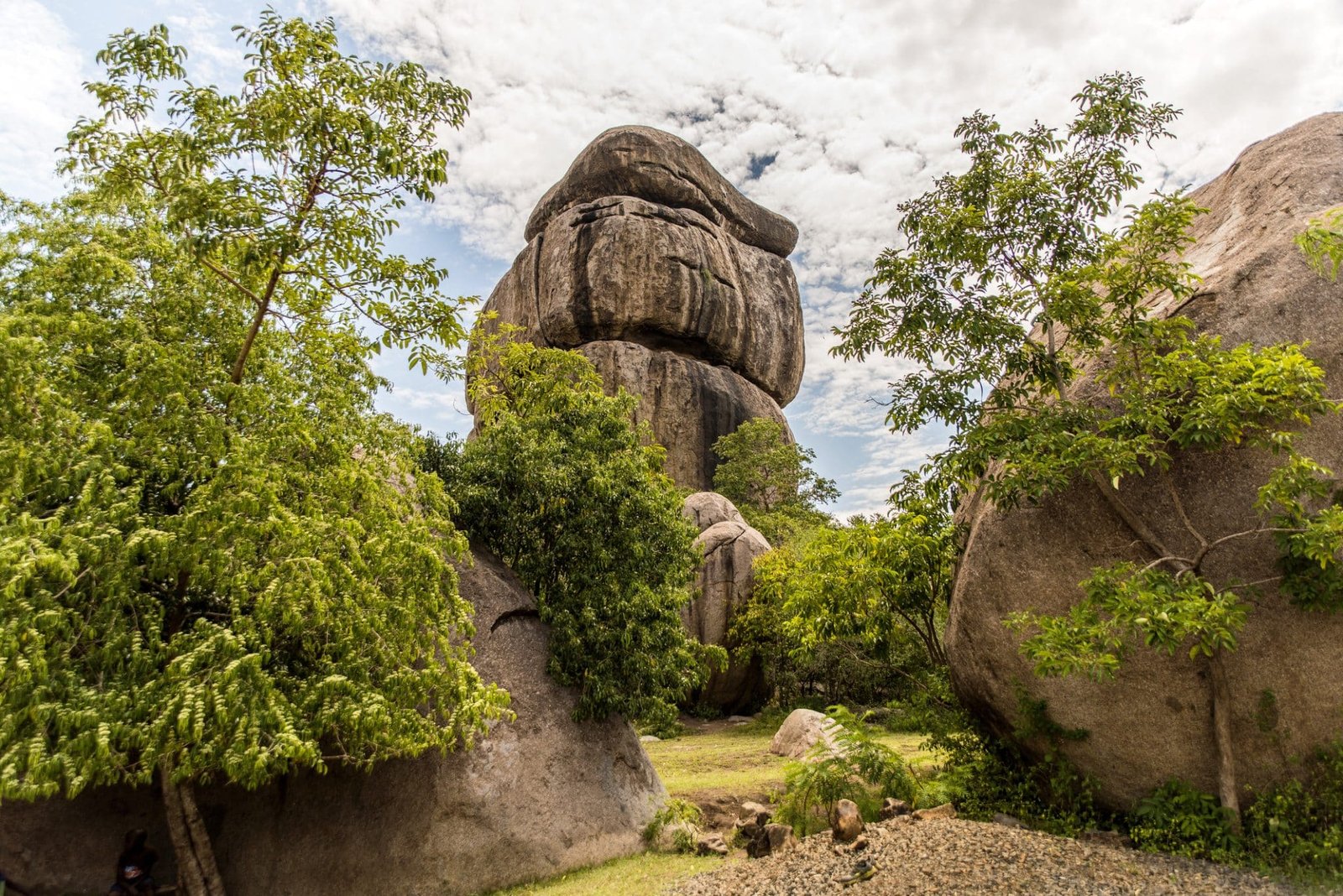
The Ultimate Guide To Kisumu, Kenya: Must-Know Travel Tips & Tricks!
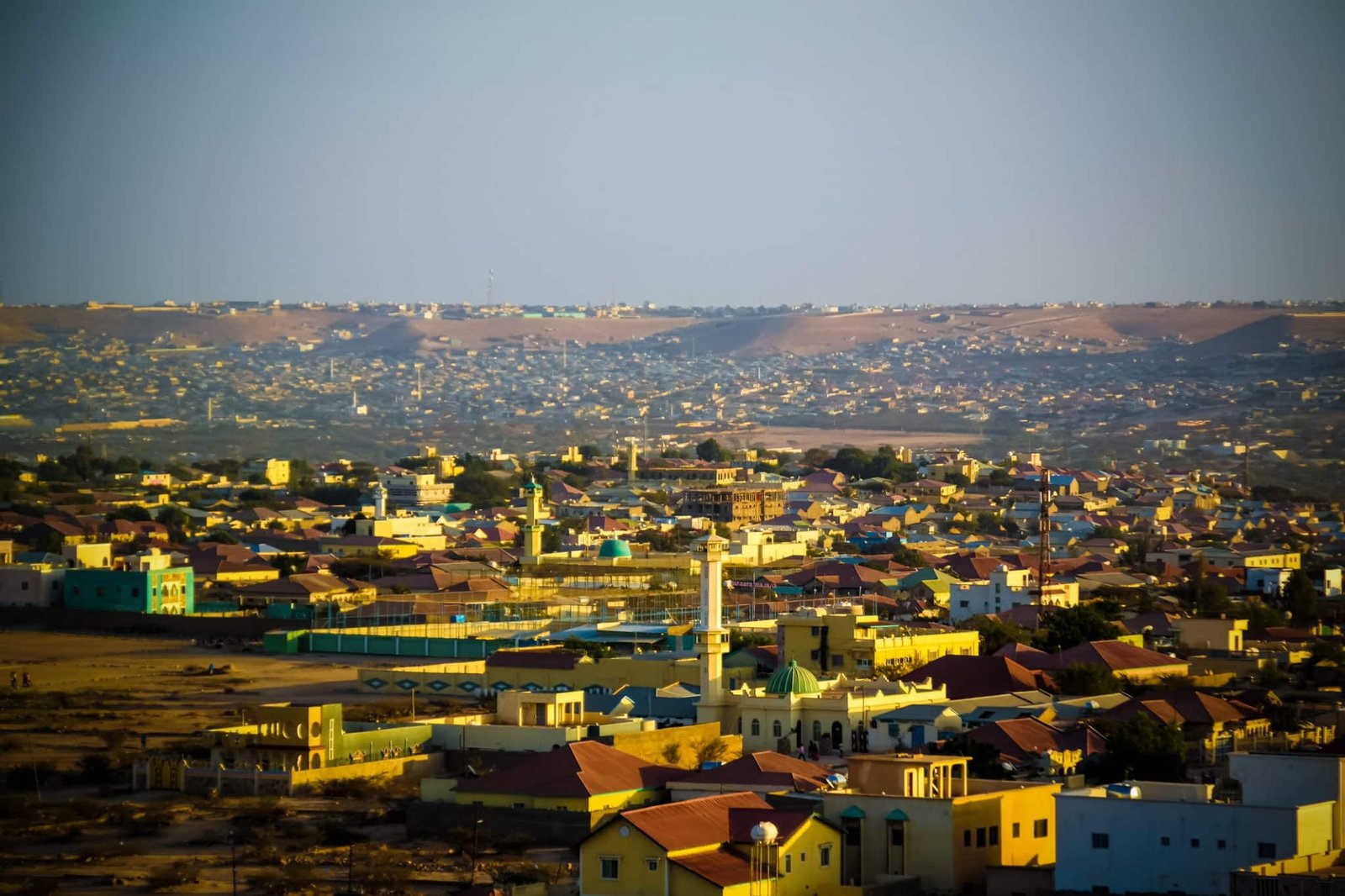
The Best Volunteer Roles In Hargeisa & Somaliland!

Lorem ipsum dolor sit amet, consectetur adipisicing elit sed.
Follow us on

IMAGES
VIDEO
COMMENTS
Marrakech is a vibrant city of color, history, and exotic experiences. However, it's essential to be aware of the things to avoid to ensure a safe and enjoyable trip. In this article, we'll cover 20 things to avoid in Marrakech, from cultural considerations to safety precautions, tourist traps, accommodation, dining, and transportation tips.
Y our Ultimate Guide to Avoiding Scams and Tourist Traps in Marrakech. Marrakech is a vibrant and culturally rich city, attracting travelers from all over the world. However, as with any popular tourist destination, scams and tourist traps can be a concern. To help you navigate these potential pitfalls, we've compiled 24 tips for a safe and ...
Tips for averting uncomfortable situations. Ensure your legs, shoulders, and arms are covered (especially for women). Preferably, at least one male member should be part of the group. If possible, don't walk outside alone especially after sunset, or in back alleys where there are not many tourists.
Public transportation is somewhat reliable and safe in Marrakech, especially ALSA's tourist buses. Be sure to keep valuables close and monitored when taking any type of public transit in and ...
Tips for staying safe in Marrakesh. 1. Don't walk through the Souk at night. You'd think this would be an obvious one, but honestly, I learned this the hard way. Marrakesh, on the whole, is not a dangerous place. You're unlikely to run into any real danger as a tourist. That said, you are a nice target for petty crime.
Avoid the area around Djemaa el-Fna as these tourist traps pay less attention to hygiene. Look for places that have reasonably big crowds of locals. Don't drink the tap water in Marrakech. Opt for bottled or filtered water instead. The weather in Marrakech can get very hot and dry. Stay hydrated and wear plenty of sunscreen.
13. Le Jardin Secret. Tucked away from the lively streets of Marrakech lies Le Jardin Secret, a hidden oasis of serenity and natural beauty. Divided into two sections, the Exotic Garden and the Islamic Garden, Le Jardin Secret offers a tropical escape while showcasing traditional design principles.
According to the tourist numbers Marrakesh is certainly still on the cards for a trip, which could mean that it's a safe destination. In 2017 Marrakesh broke its own record, crossing the 2 million mark for tourists in the city with more than 6 million overnight stays; that's a lot for a city with a population of just under 1 million!. Tourist numbers are still on the rise.
Yes, if you're aware of tourist traps Story by Sarah Pollok • 1w I found myself in the bustling heart of Jemaa El-Fnaa markets, in Marrakech , when a wave of unease swept over me.
3. Hone your negotiation skills in advance. From haggling in souqs to negotiating fares with taxi drivers, bargaining is commonplace in Marrakesh. Shopkeepers often state an offer and the buyer is expected to negotiate a price they are prepared to pay. I say: pay what the goods are worth to you.
The tannery in Fez, Morocco is a tourist attraction, but the tannery in Marrakech is a tourist trap! (Photo by Carlos Ibáñez on Unsplash) 13. Don't Go On A "Tannery Tour" In Marrakech ... 👉 Tip: Skip Cafe de France, which is a bit of a tourist trap, and visit its next-door neighbor Café de la Place. Not only is Café de la Place ...
The Bahia Palace is one of the best photo spots in Marrakech and is very popular tourist spot in the city. Constructed in the 19th century, this palace is a must-visit location for anyone exploring Marrakech and offers an excellent opportunity to take some stunning pictures aside from getting to explore the place, which is a must on any ...
As amazing as Marrakech is, at times, it all get a bit too much. The trick to make the very best of it (and limit the amount of uncomfortable situations you end up in) is to be prepared - here are 16 really useful things to know before you visit Marrakech. ... Over the last ten years or so, Marrakech has exploded as a tourist destination, and ...
Consider when you travel. Meaningful interactions can be had at quieter times of day and year, as a dawn visit to St. Peter's Basilica in Vatican City with an infant once taught me. "Traveling in the low season," Roca says, "will help avoid both tourists and traps alike.". Tim Chester. Tim Chester is a deputy editor at AFAR, focusing ...
All with the purpose to entertain tourists, but at the expense of animals. After five minutes looking around, I decided to get the hell out of there. I did not want to be part of this tourist trap. 4. Avoid taking photos of locals. Taking photos in Marrakech can be challenging. Locals often do not want to be in your photo at all.
Many restaurants in Marrakech charge tourist prices, ... and tourist traps that lurk in the main square. But it was interesting to see this famous spot in Marrakech and wonder why so many tourists fall for the facade of true culture. The famous Jemaa El Fnaa Square. 12. Book a Sahara Desert Tour
There are some legitimate Moroccan tanneries, but there are also some tourist traps set up—especially in Marrakech tanneries. There are two ways tourists can end up at a tannery against their will. A local can offer them directions that take them to a tannery, or the tourist might stumble upon a scam tannery.
Between the high cactuses and the bamboo forest, there are fountains made of mosaics and beautiful buildings in bright blue and yellow. The entree fee is 70 dirhams per person (+/- 6.5 euro). 3. MUST do in Marrakech: Drink mint tea on a rooftop terrace with views over Jamaa el-Fna.
Souk Sebbaghine, the dyers' souk, is a photographer's dream with its strands of wool in bright colours drying overhead. You will be expected to haggle, but through this act it's worth bearing in mind that all traders want to make a sale. Recommended tour: Marrakech: 3-Hour Colorful Souks Tour. 3. Koutoubia Mosque.
My Top 23 Essential Marrakesh Travel Tips (You Can Thank Me Later) - Helen in Wonderlust. Marrakech is a fabulous city, full of intrigue and wonder, but it is chaotic and can be intimidating when you visit for the first time, or maybe even the second or third time. Morocco's Red City is a different world, so having an idea on what to expect ...
Marrakech, The Tourist Trap June 21, 2015 / Christina Torossian / 0 Comments. It's been a full week since I've been in Morocco, and it's been the slowest week I've experienced, ever. ... Marrakech is not tourist friendly; much of the famous medina is dedicated to luring tourists into buying overpriced items. The city felt as if it was a ...
From deserts and waterfalls to Berber villages and rocky valleys, there are many day trips to take from Marrakech. 1. Ouzoud Falls. Source: Alberto Loyo / shutterstock. Ouzoud Falls. The Ouzoud Falls are an incredibly impressive set of waterfalls that plunge from high cliffs far down into a huge basin.
But what is most shocking is that even though there's a pretty clear disdain for visiting these sorts of attractions, 44.48% of respondents shared that they'd visited tourist traps between two to ...
Compared to Casablanca, Marrakech has much more of a touristic and tourist-friendly vibe. It also boasts a very long lineup of popular landmarks and attractions, from the Marrakech Museum to the Jardin Majorelle and 16th century Saadian Tombs.The city is also famed for its diverse cultural experiences, offering everything from cooking classes to hot air balloon rides.